Dutch silver pipe cleaners
Author:
Don Duco
Original Title:
Zilveren pijpenwroeters
Publication Year:
2013
Publisher:
Amsterdam Pipe Museum (Stichting Pijpenkabinet)
Description:
Introductory article about the fashion and decorations in the Dutch silver pipe cleaner from the eighteenth century to the twentieth century.
The pipe tool is an indispensable object for the pipe smoker, an item that is known by a wondrous number of synonyms in Dutch language. The word pijpewroeter (pipe rooter, pipe cleaner) or nowadays pijpenwroeter is the most common and refers to the function: rooting in the pipe bowl. Synonyms are pijpekeuter, pijpekloker or in more specific dialect: piepreukel, piepreutelder, piepuitpluzer or paiperoder. Even Flemish has more than one indication, such as pijpuithaler (pipe extractor) or pijpdoorsteker (pipe piercer).

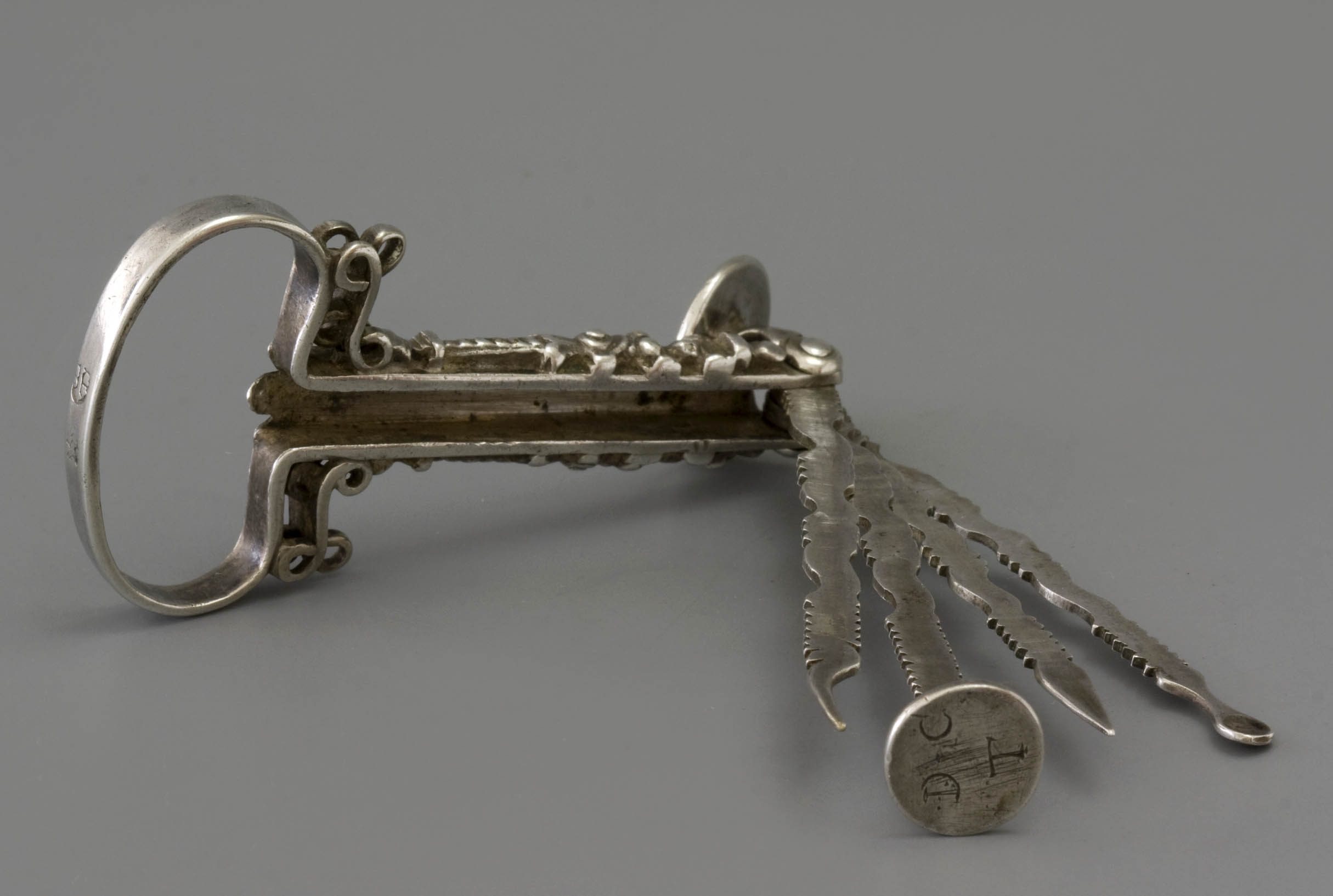
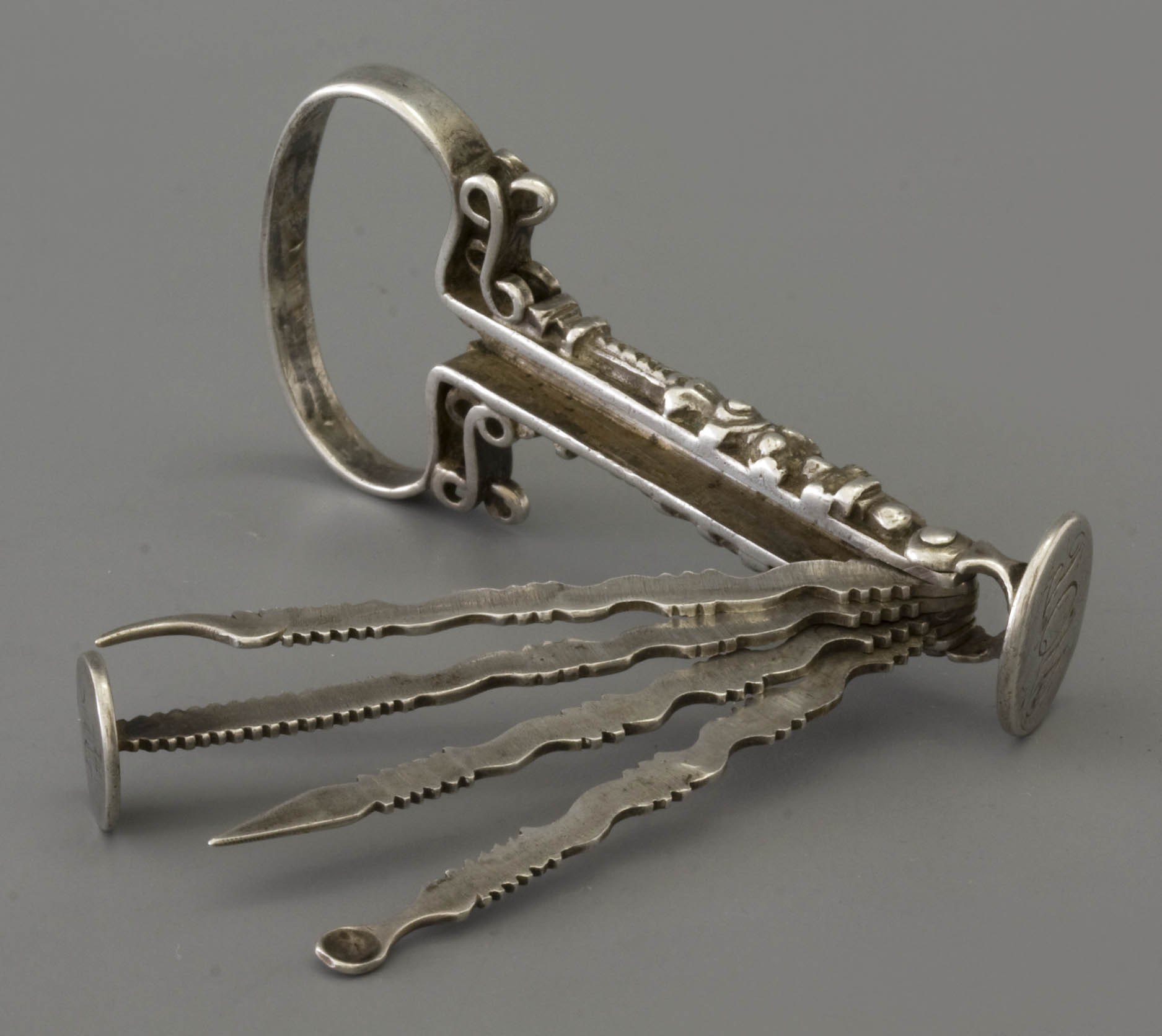
In spite of all these names, the pipe cleaner is firstly a simple instrument purely intended to empty the pipe bowl of ash and tobacco crumbs. Already in the seventeenth century smokers used pins, necessary to remove the ashes from the tiny pipe bowls. These could have been made out of a simple piece of bone, metal or wood. Preserved were the luxury counterparts from the eighteenth century. Examples of these are the multi-part hinged garniture that has been provided with a pipe stopper together with tools to clean the pipe bowl (Fig. 1). In this set, also referred to as travel necessaries, there are all kinds of toilet tools as well. Under the hinge is often a cachet with an engraved seal. In addition, there is the silver knipkoker in which also several loose tools are brought together, including the pipe cleaner, sometimes combined with a pipe stopper.
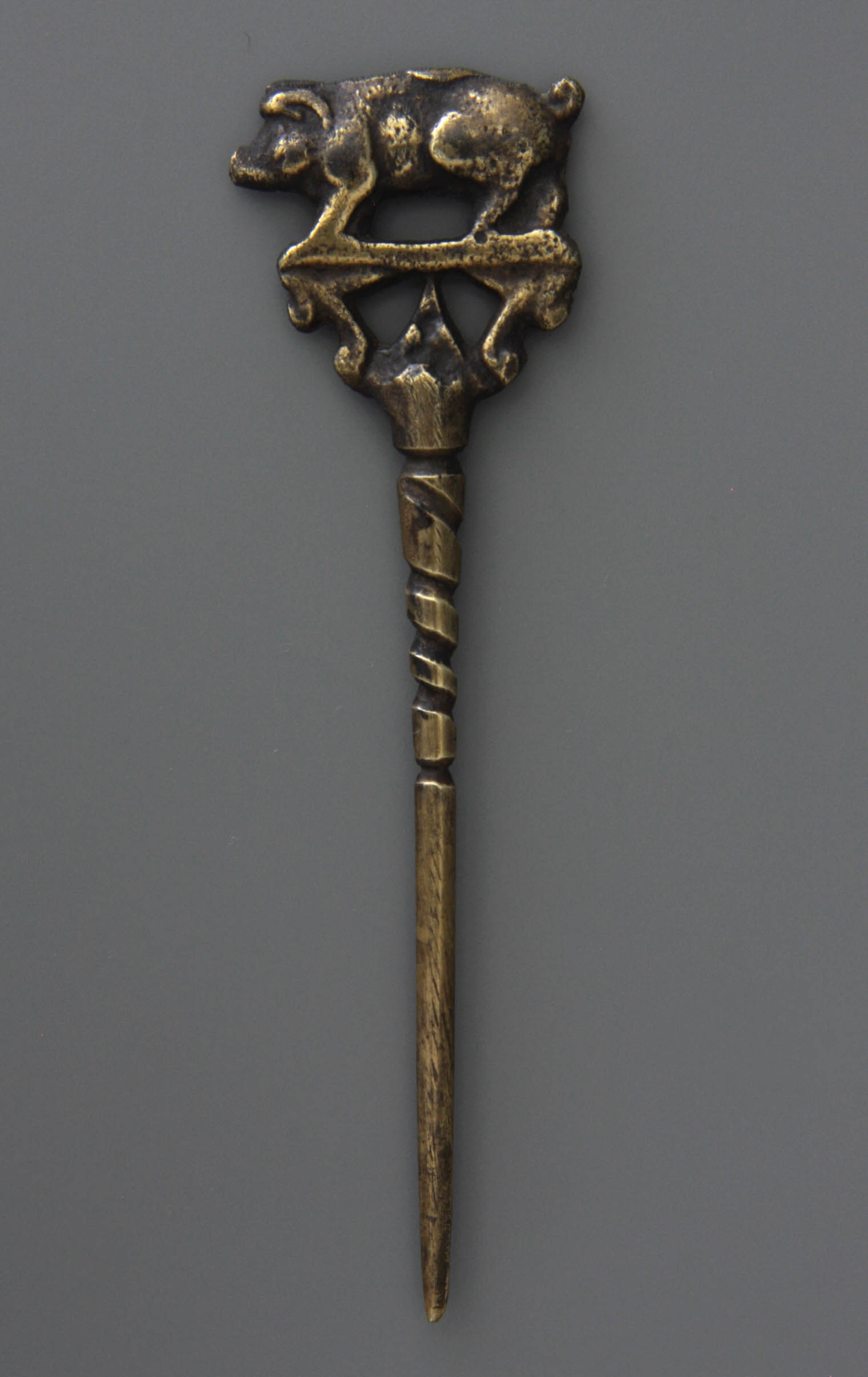
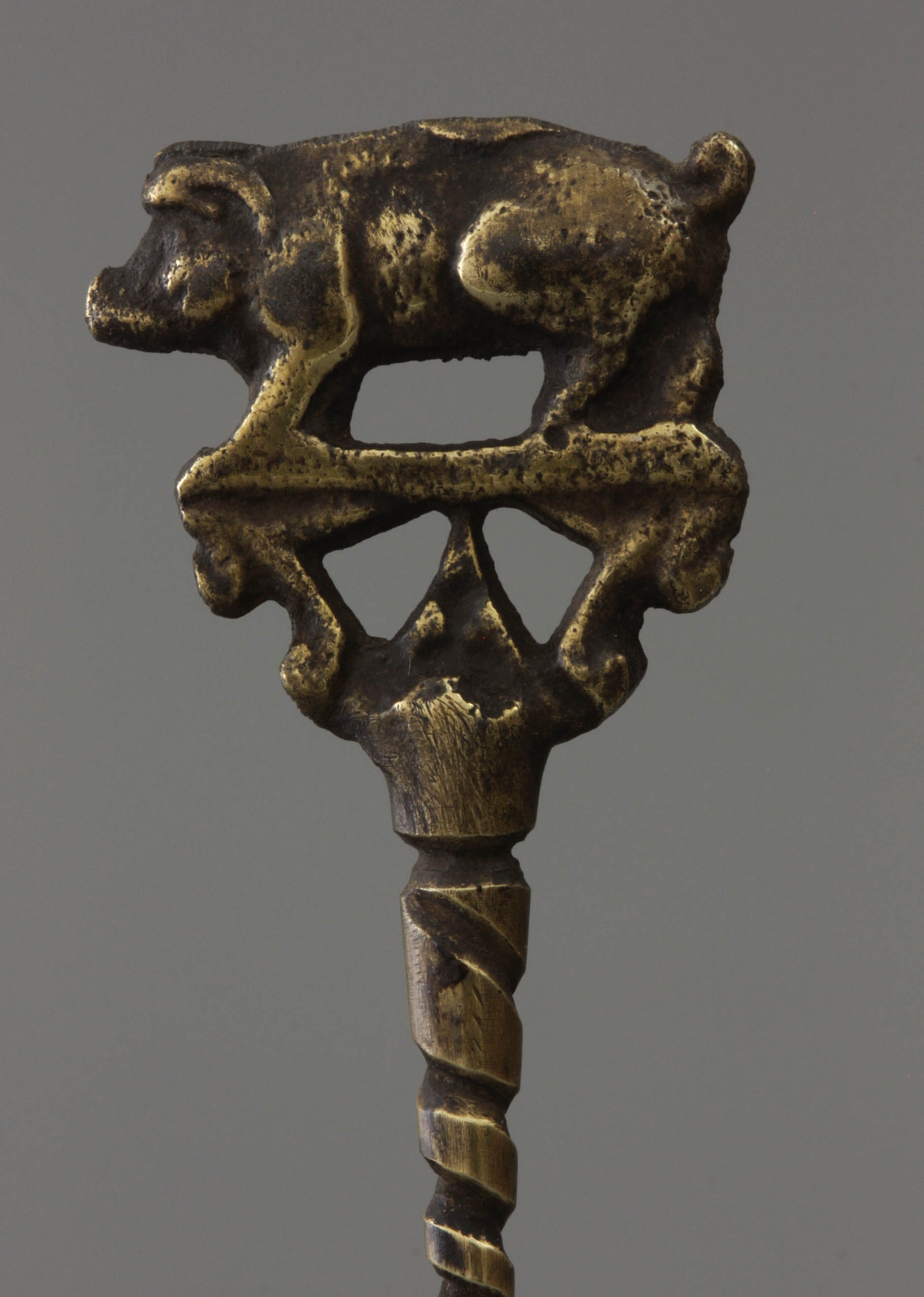
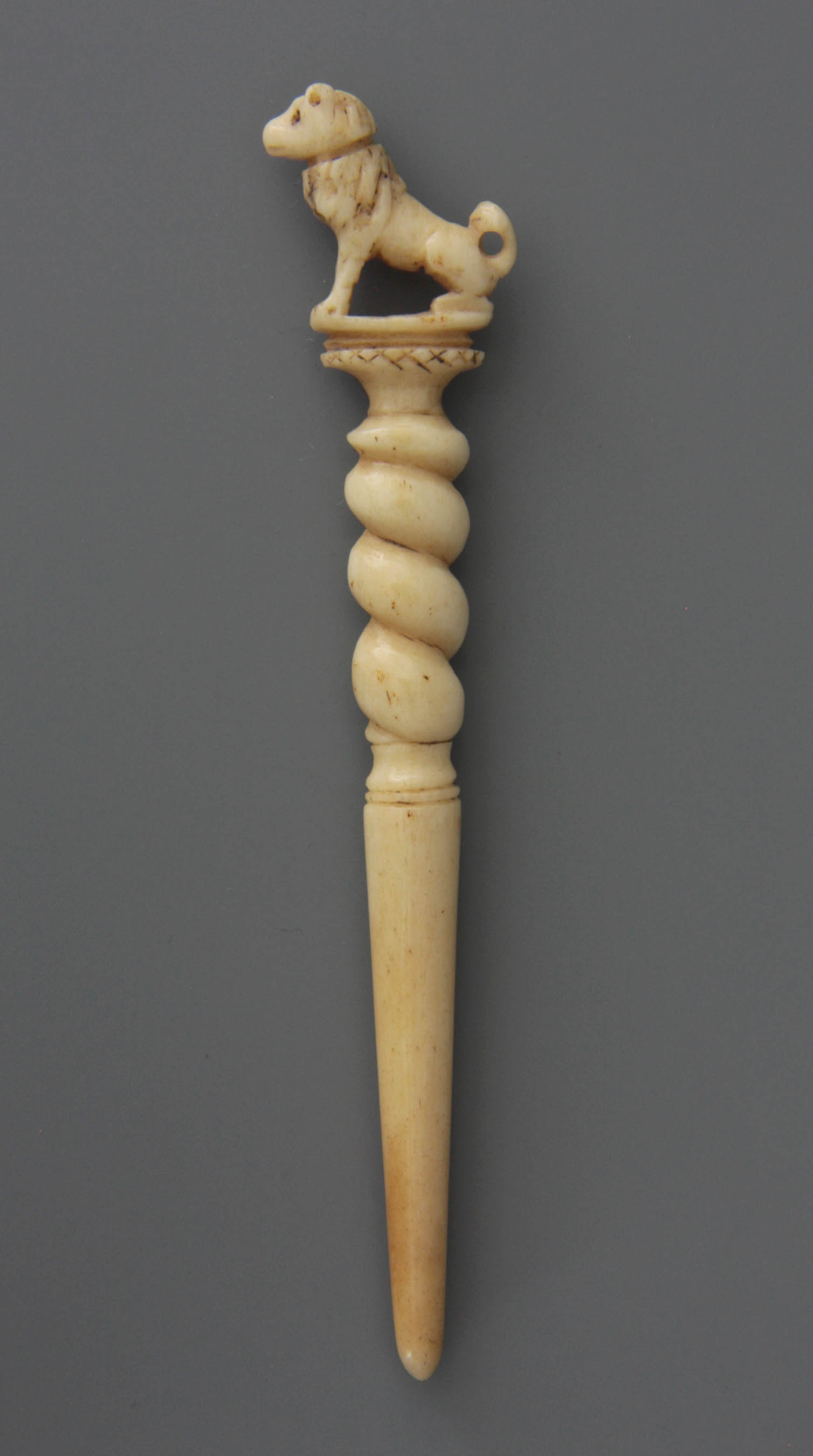
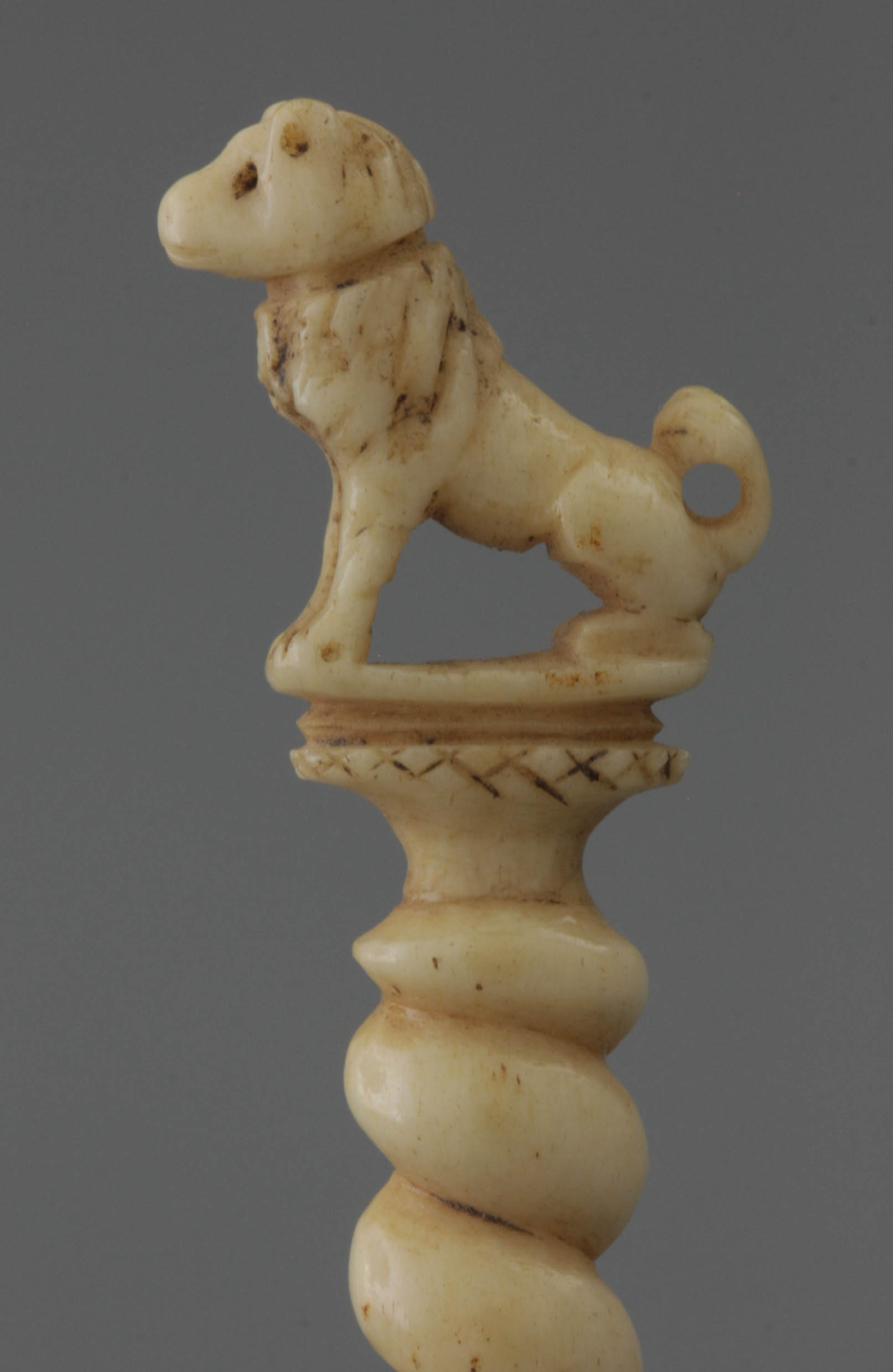
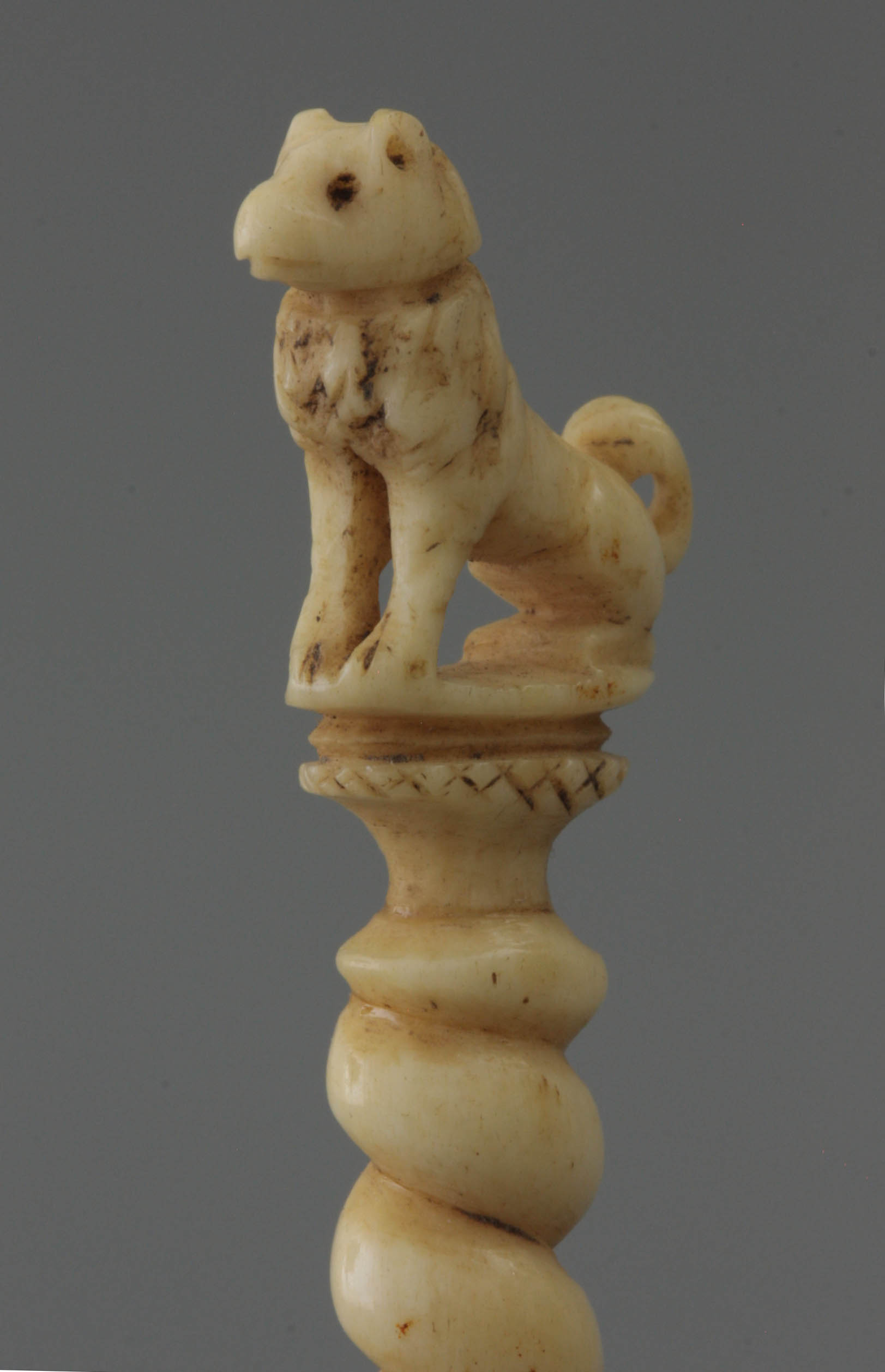
The silver version of the pipe cleaner as discussed here consisting of a pin or pricker crowned by a figure (Figs. 4-51), has no relation with the luxurious multi-part garniture or knipkoker. It originates from the simple brass or copper predecessor (Fig. 2) or the more popular variant of wood, bone or in a rare case also ivory (Fig. 3). What binds all these objects is that they are a commodity with only one goal: to remove the tobacco ashes from the bottom of the pipe bowl. The tip is the working part of the object, the decorative element serves as a handle. In addition to the pipe stopper intended to press down the smouldering tobacco, the pipe cleaner is a piece of equipment that is indispensable for the smoker to empty the pipe bowl after smoking.
Strangely enough, there is little relationship between the pipe stopper on the one hand and the pipe cleaner on the other. Especially remarkable is that the silver cleaners are never combined with a pipe stopper. It is also amazing that no sets are known with a unit of design. All in all, the silver pipe cleaner is a luxury item with a highly ornamental function. Furthermore, the pipe cleaner is typically Dutch, though the use continues deep into Flanders. The English smoker has a much larger bond with the pipe stopper to keep the tobacco at the right density. British cleaners are hardly known, only very occasionally included in a silver pipe stopper. In Germany too, the pipe cleaner is not very widespread, with the exception of the border region with the Low Countries.
Origin
The pipe cleaner with its specific pin and decorative crown must have been introduced in the eighteenth century. Since numerous Dutch brass tobacco boxes of that period are known with a clamp in the lid meant for holding a pipe cleaner, we may assume that the cleaner was already a common article during the eighteenth century. Initially they were made in brass, bone or wood. Still, it seems that the silver pipe cleaner is only becoming popular from 1780 onwards and immediately exhibits its defined characteristics. Perhaps this has to do with the luxury nature. The silver pipe cleaner was often given as a memento or benchmark in a lifetime or as a prize at a competition. That an appropriate performance was often chosen on that occasion is obvious.
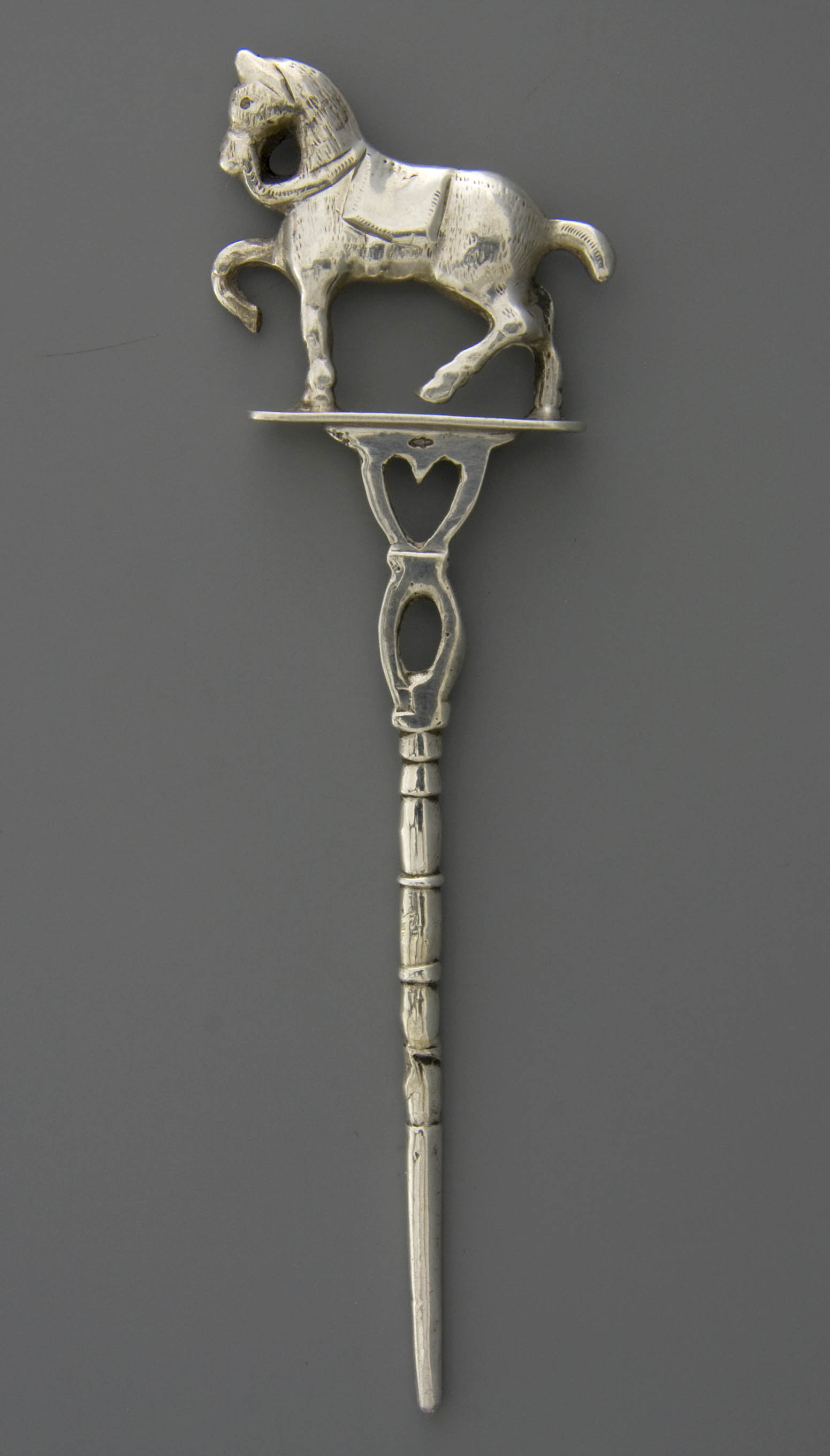
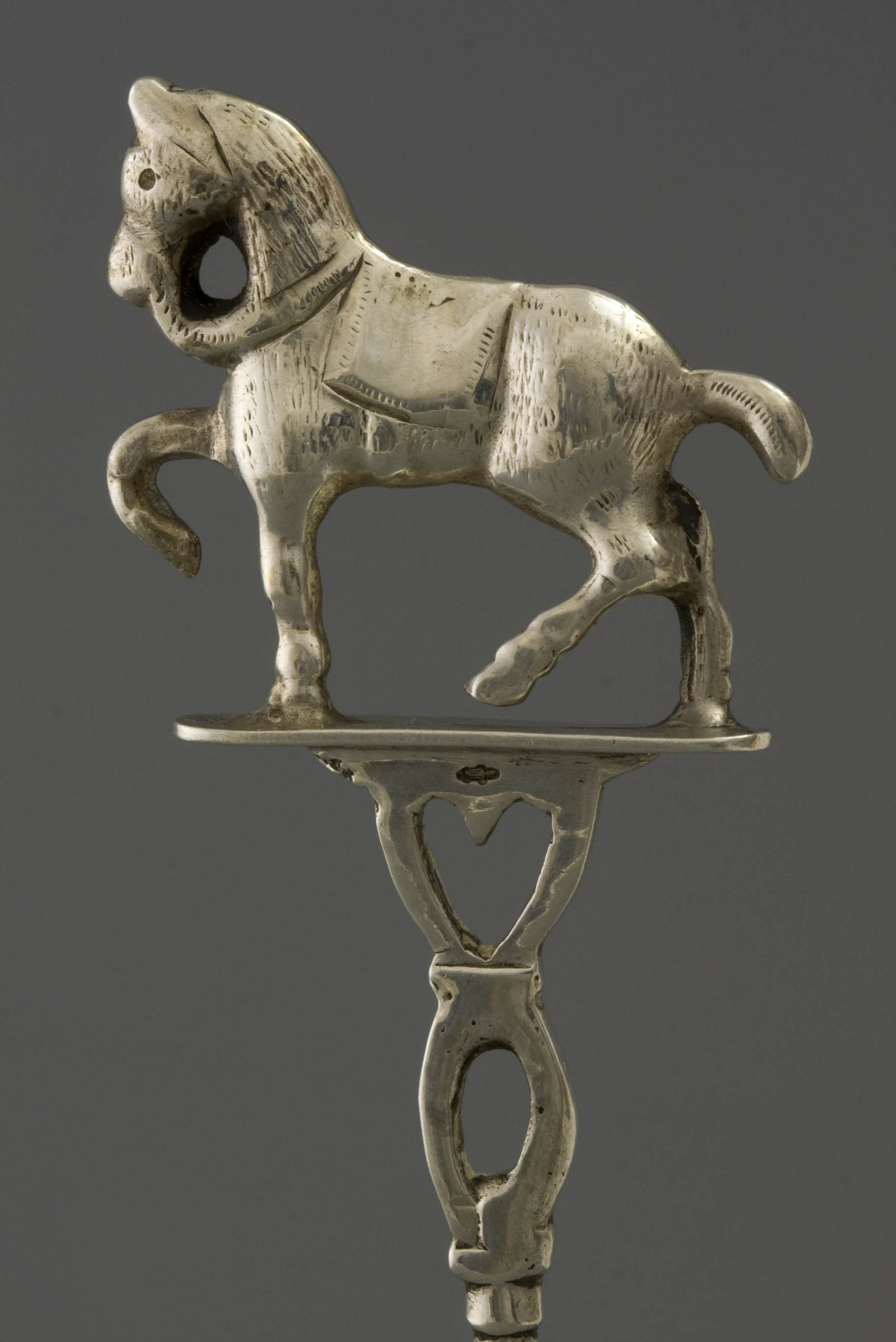
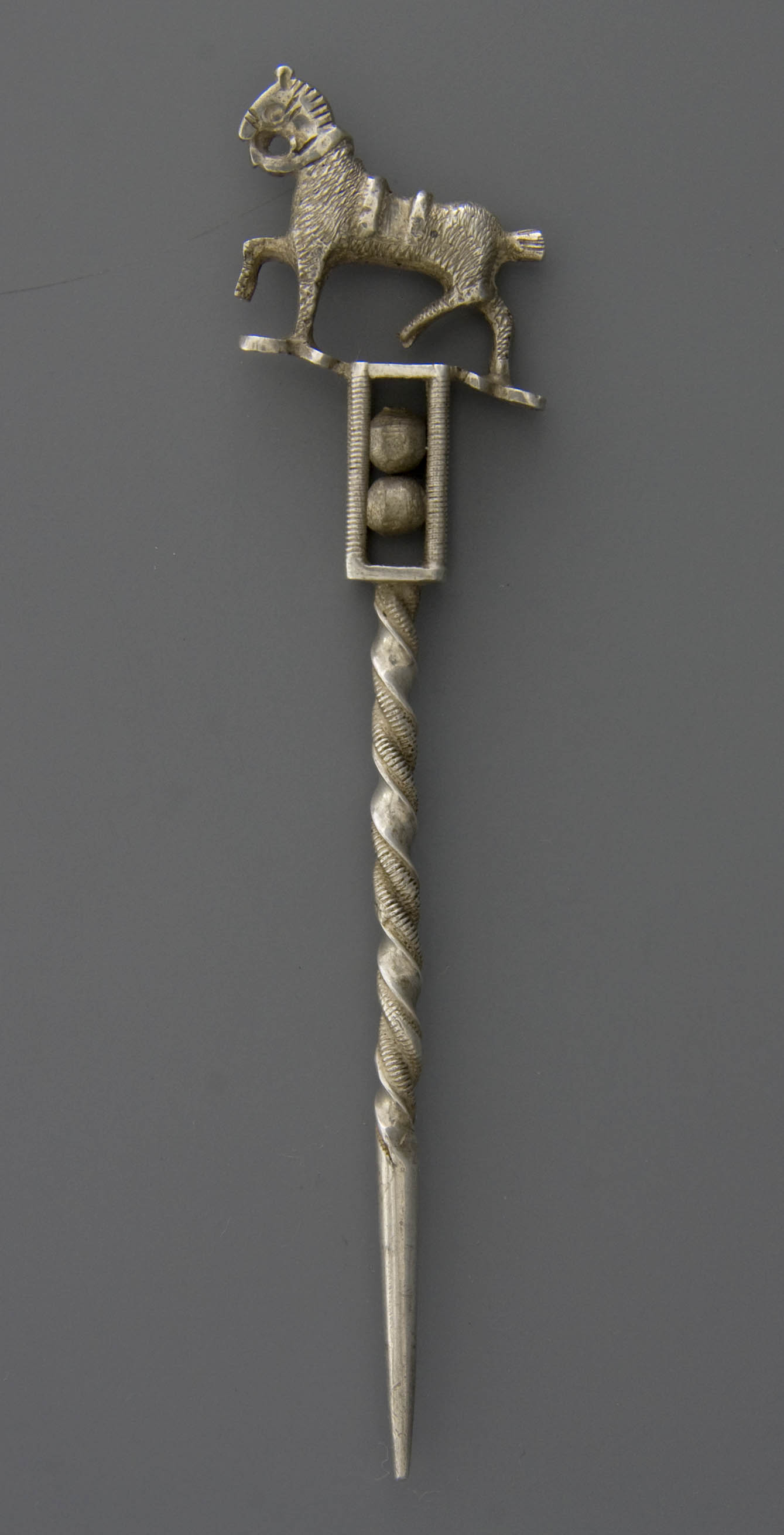
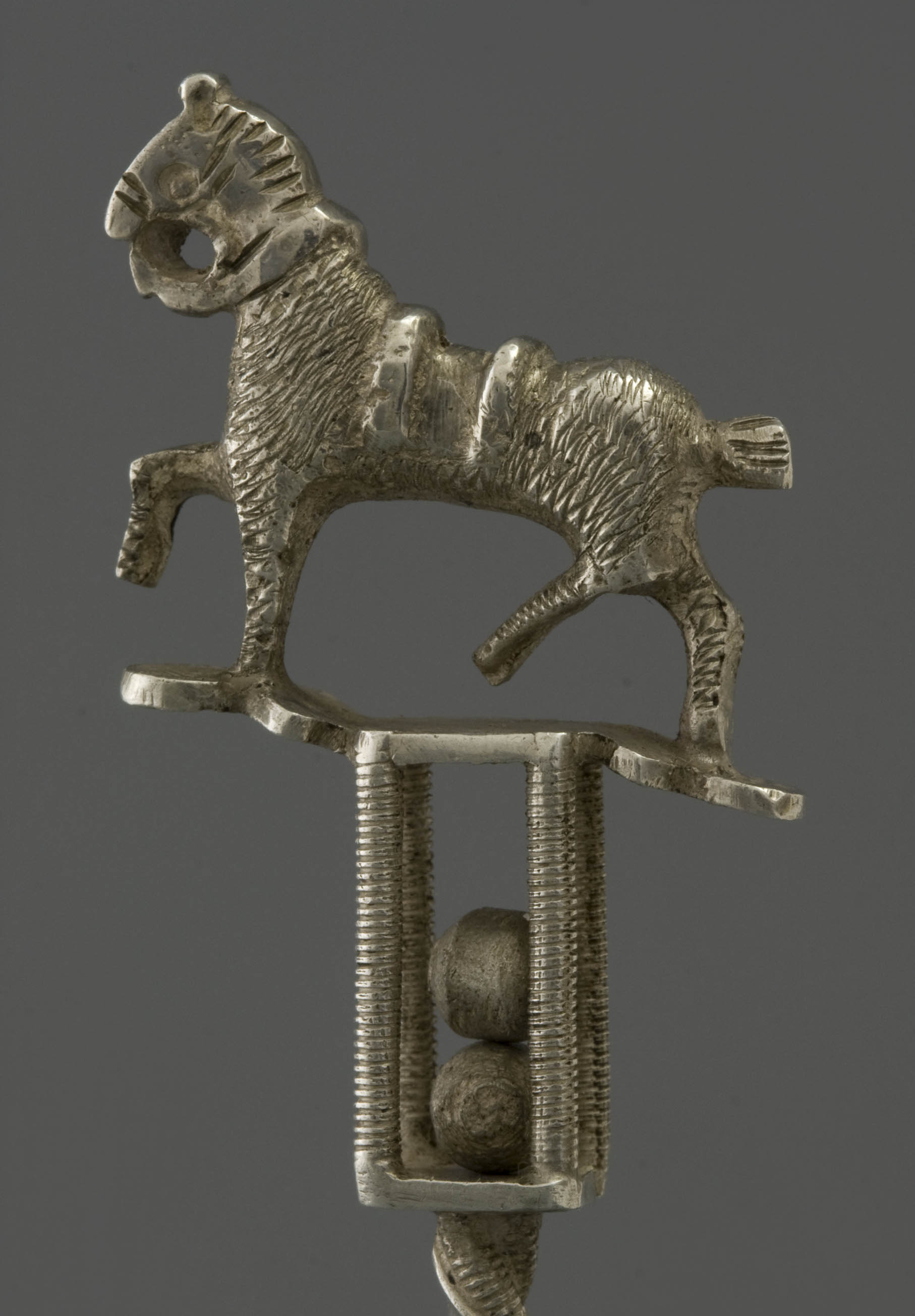
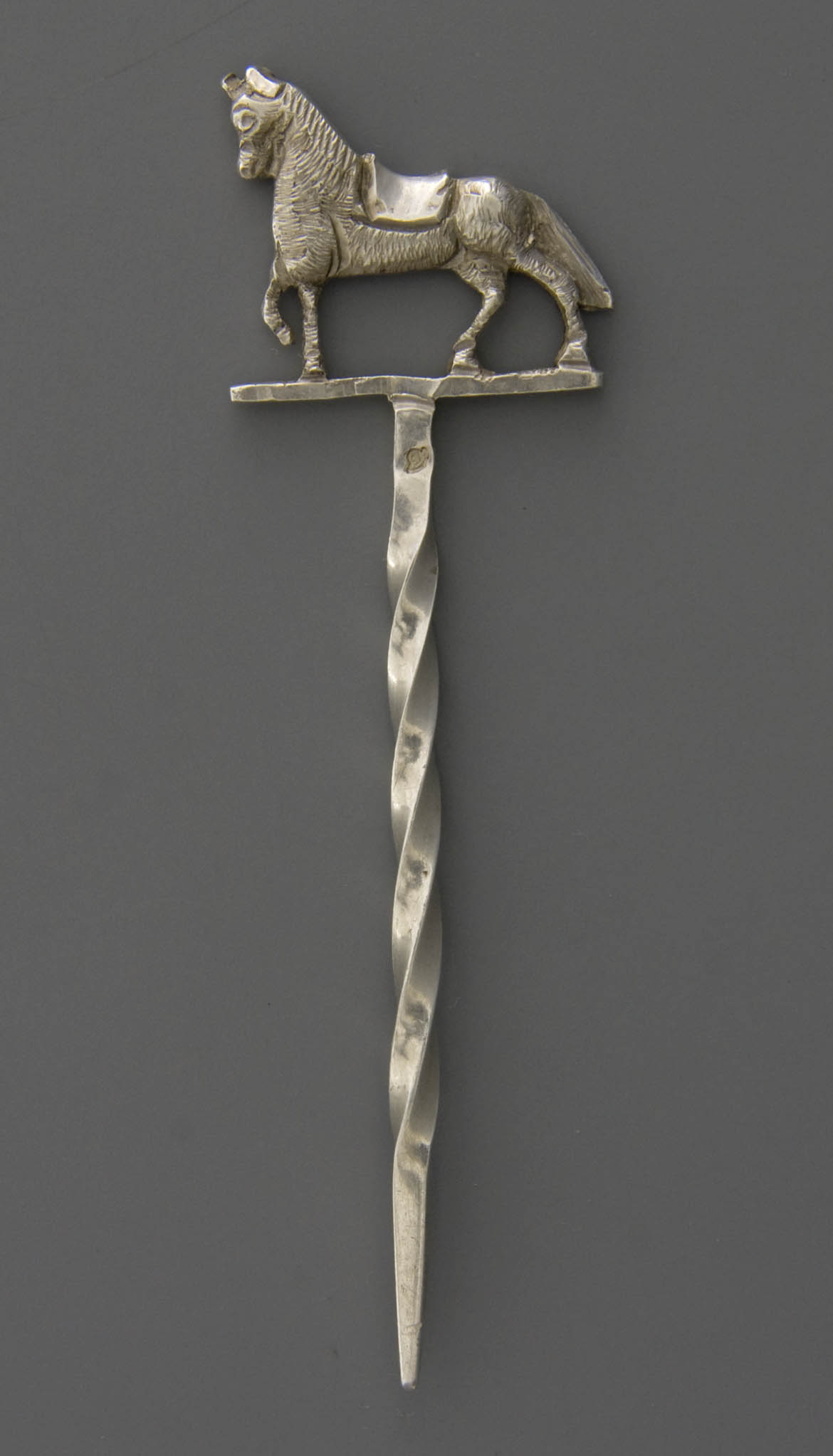

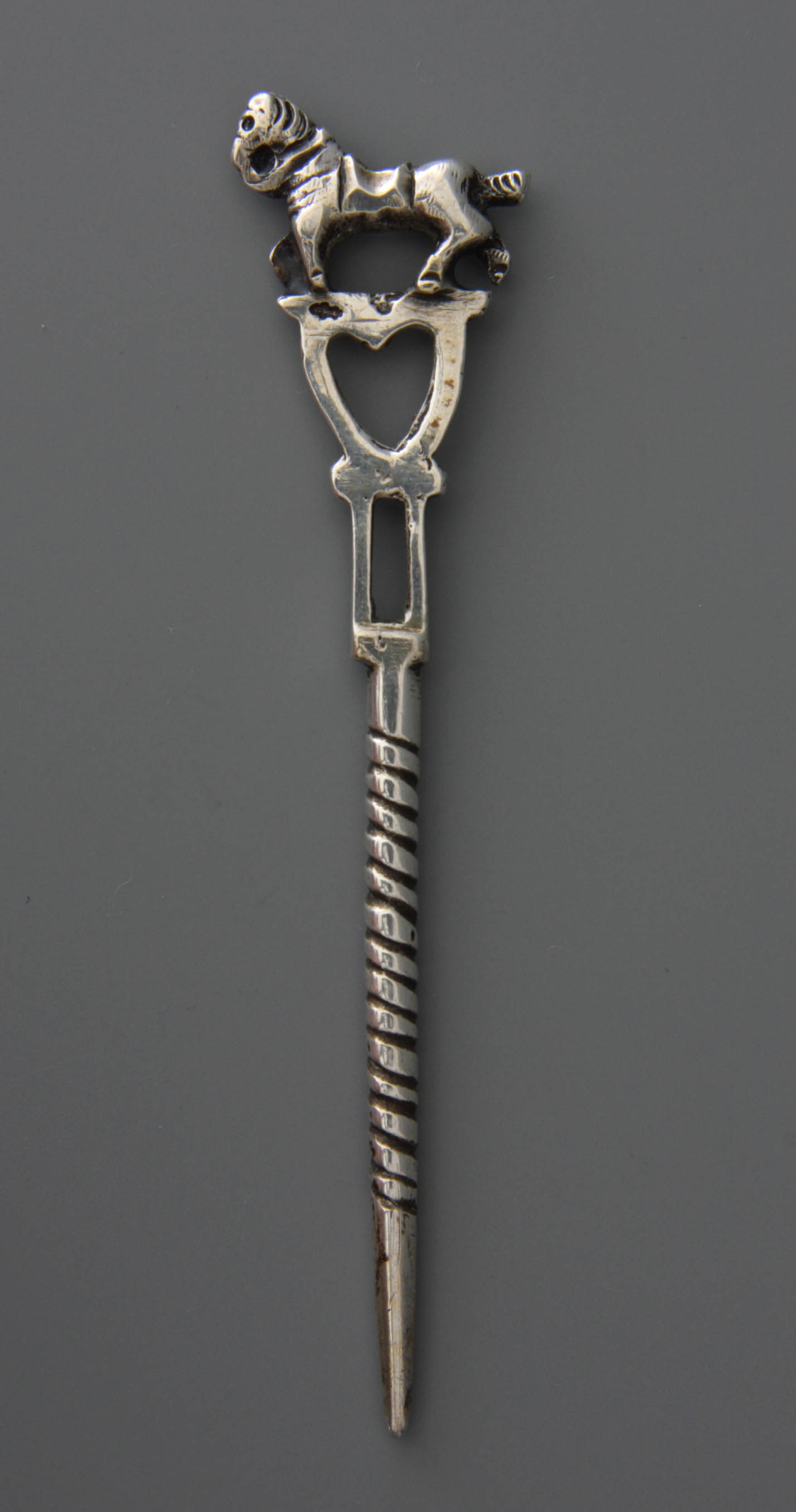

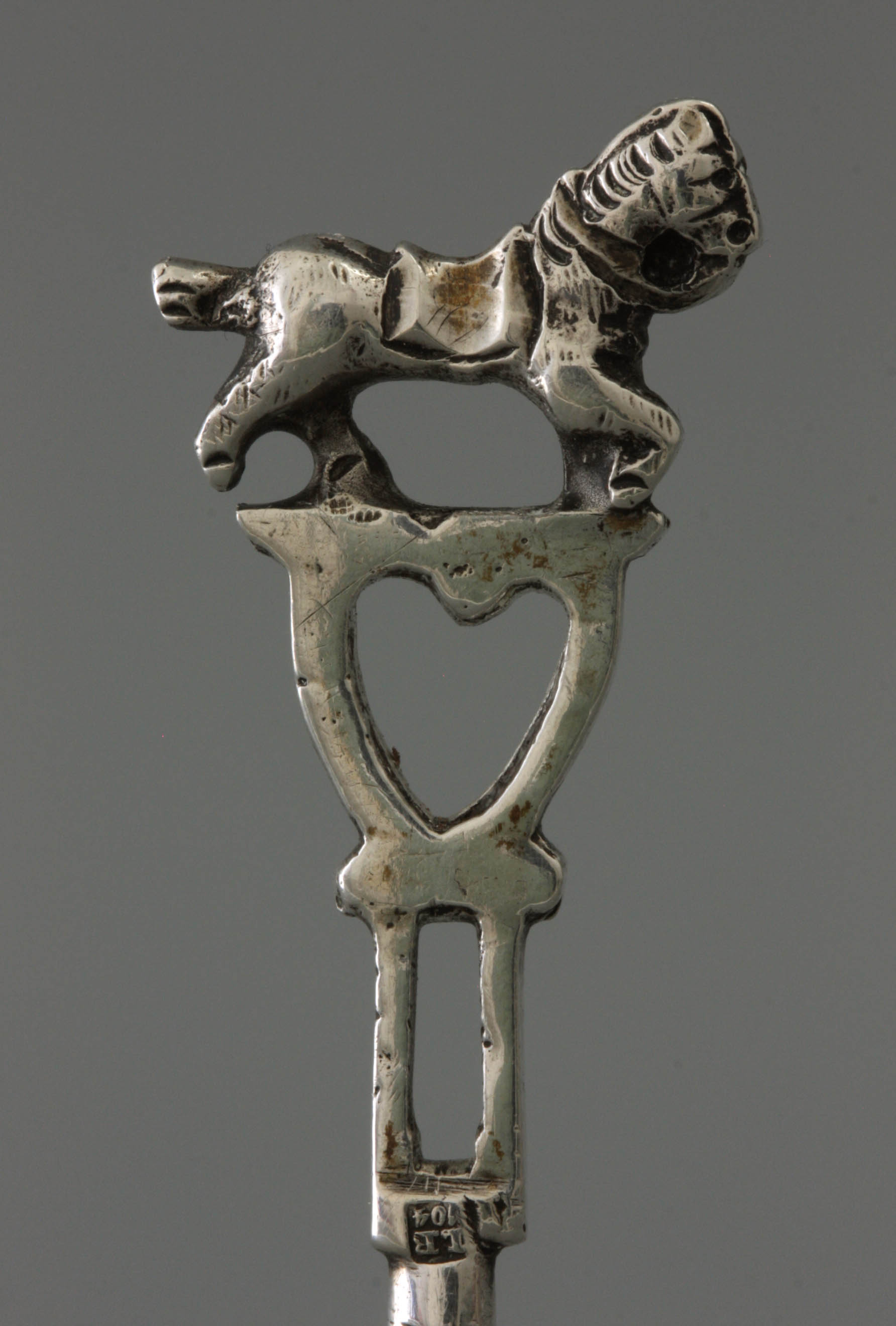
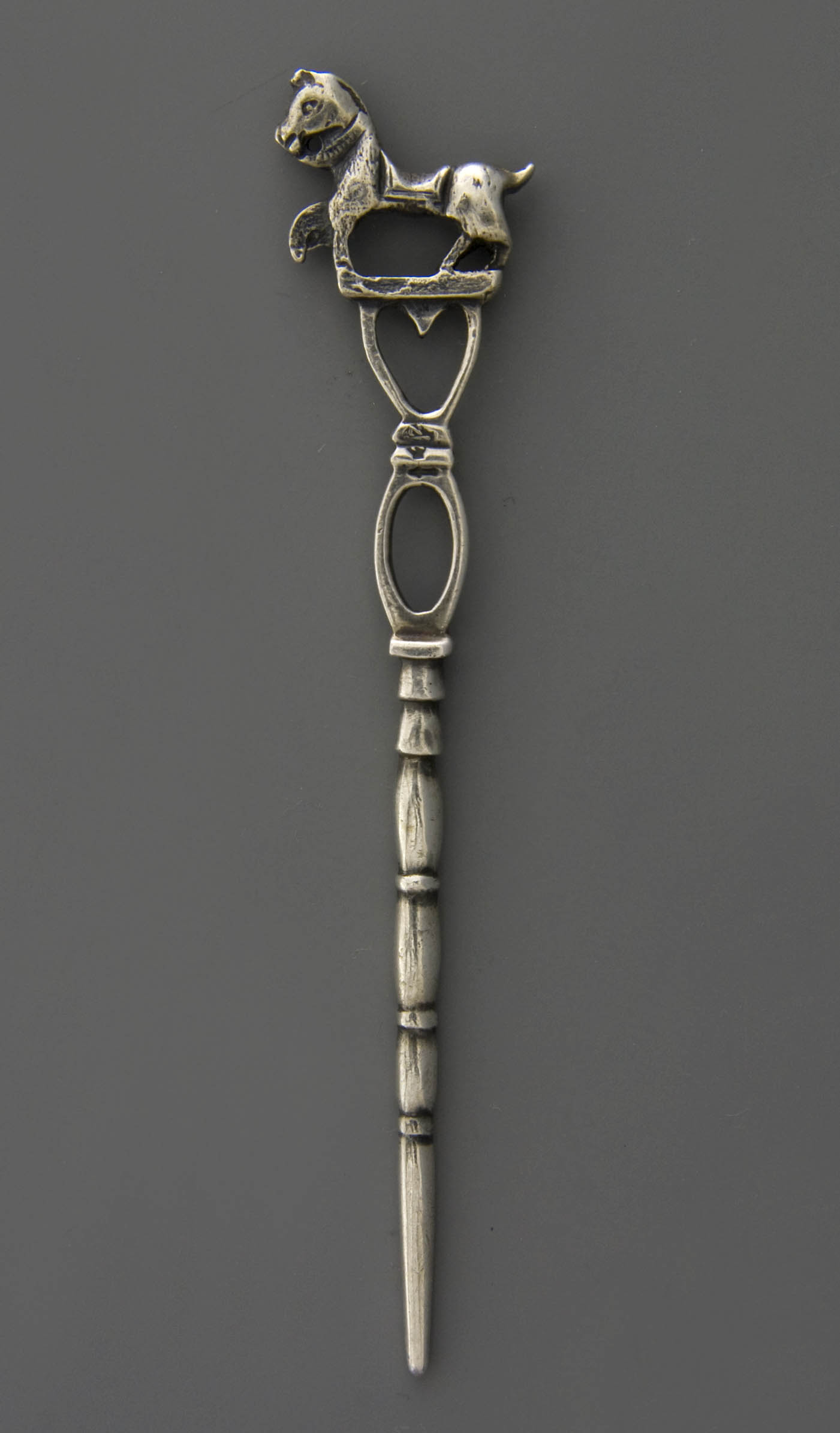
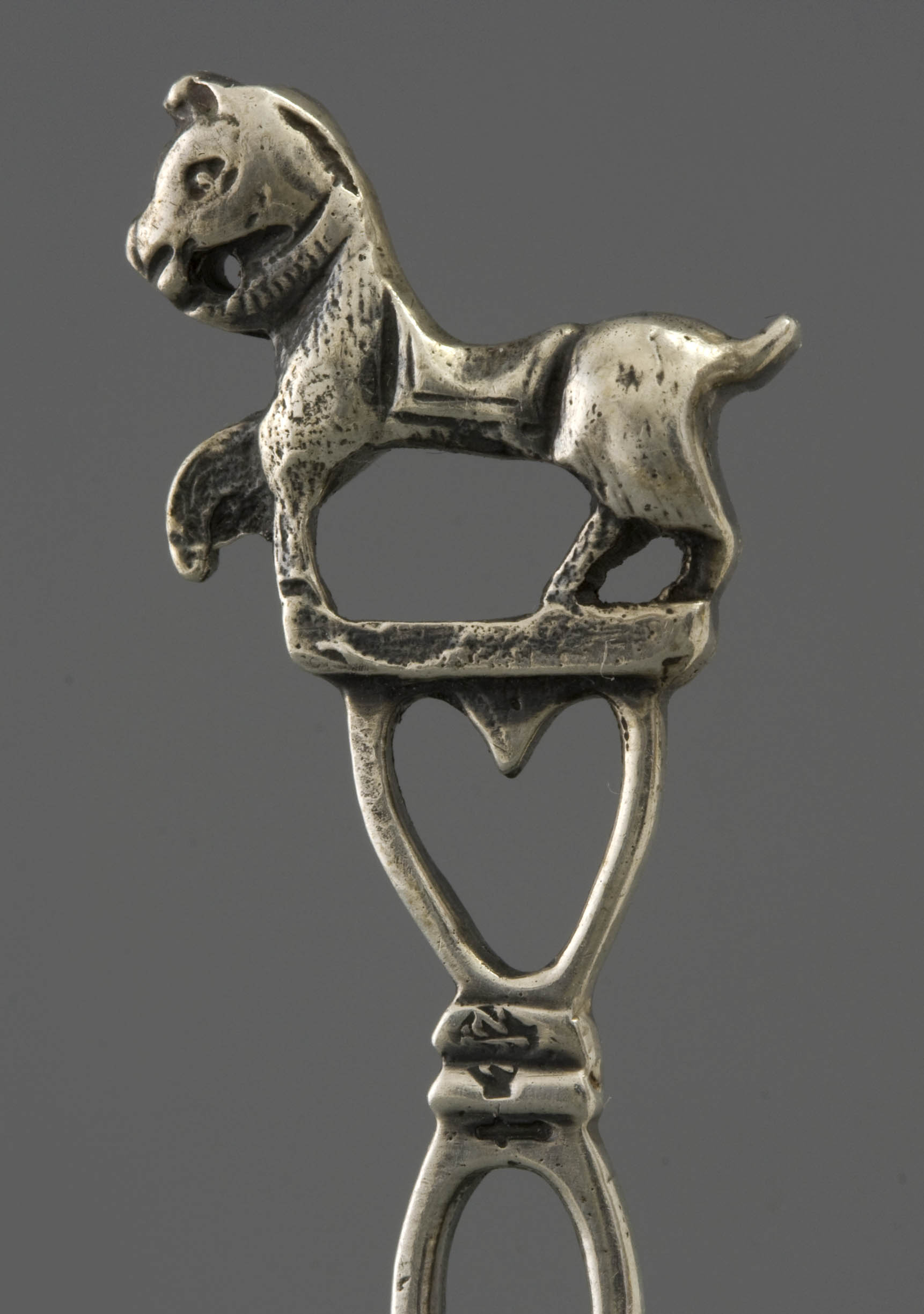
The pricker shows a clear development, which will be discussed extensively later on. The handle or the top is varied in nature, but certainly not infinite in terms of performance. That handle was made in different techniques. Casting is most common and emphasizes the serial manufacture. In addition, thick sheet silver has also been processed by sawing, drilling and filing. Then the details were applied with a burin. The more elaborate cleaners are often made in combined techniques.
The high times of the pipe cleaner lies in the nineteenth century, after which the object no longer fits the current smoking habits. The smokers accessories undergo a drastic change towards the end of that century. Only in the traditional atmosphere of the clay pipe, the silver cleaner remains longer prevalent, especially among farmers. The modern briar pipe and its alternatives, initially mainly smoked in the city, brings the handy three-in-one instrument. This instrument is called pijpenbestek, literally pipe cutlery or smoker’s friend. A rounded spoon is then used for grubbing and taking out the ashes, without damaging the moisturized wood. In addition, a pipe stopper has been added, while the pin shape is now intended for keeping the stem open. The instrument is usually made of iron, only in exceptional cases of silver or even gold. It becomes the twentieth-century counterpart of the predominantly nineteenth-century silver pipe cleaner.
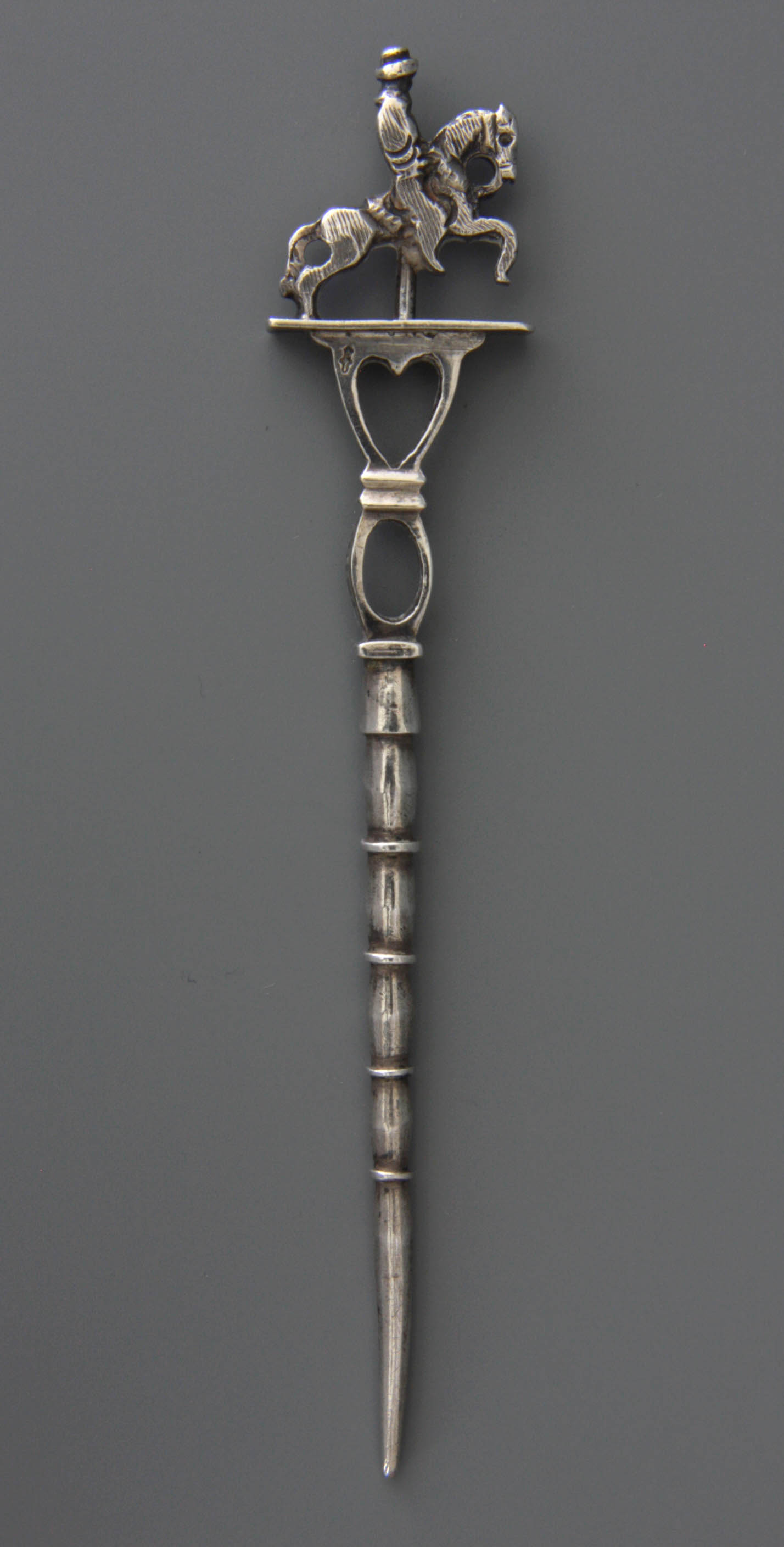
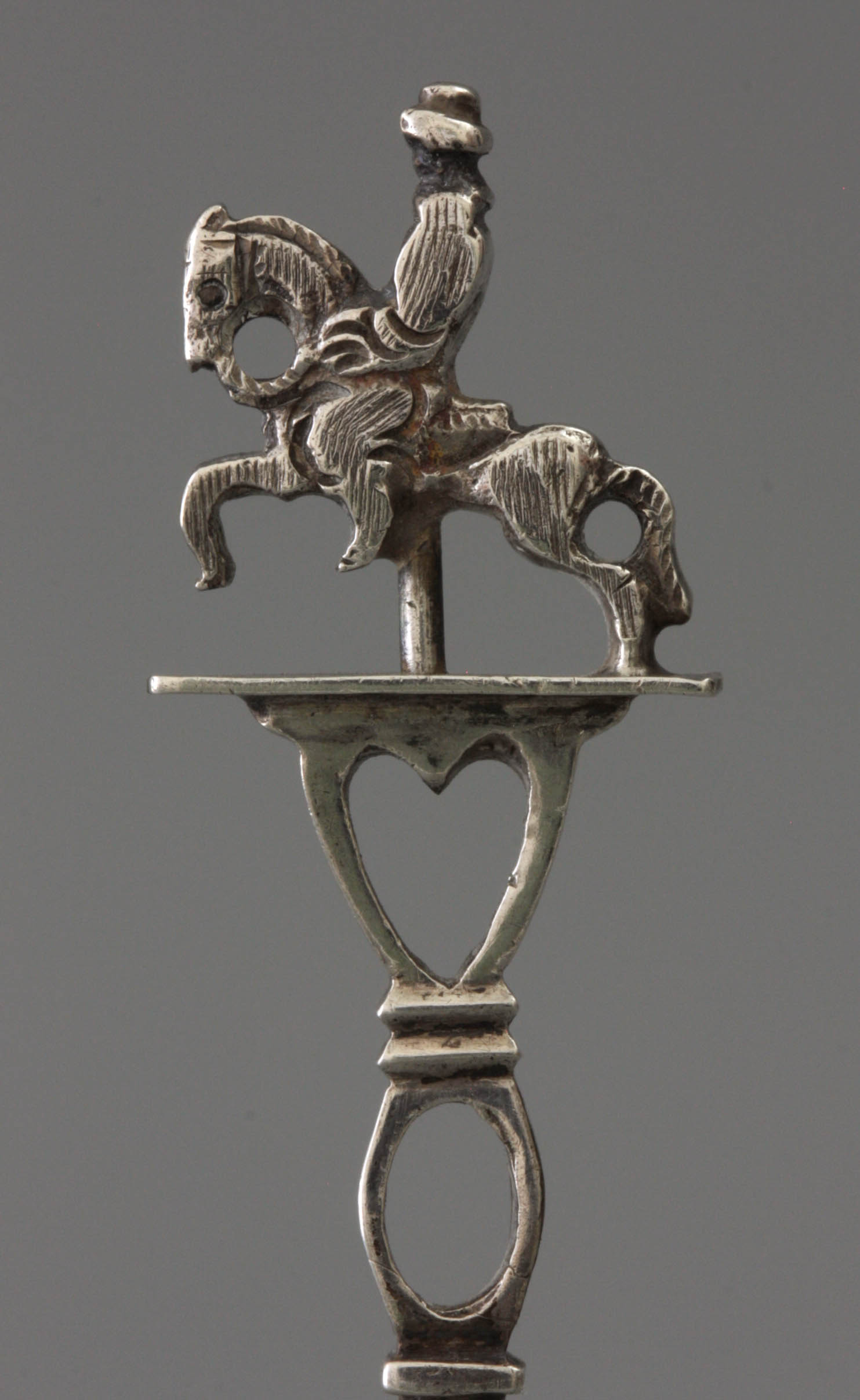

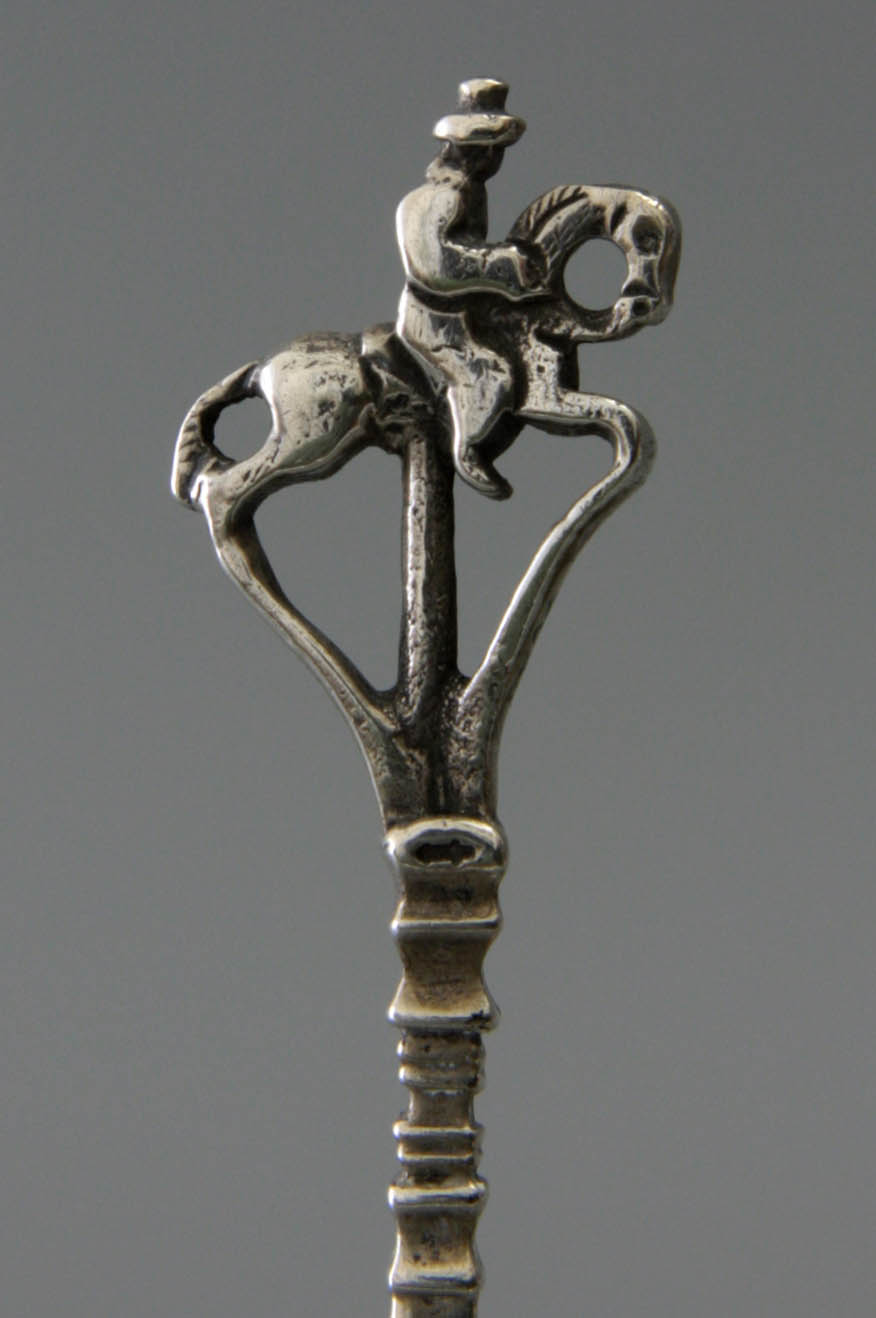
With the silver pipe cleaner, the shape of the pin and the representation in the handle are the guiding principles for classifying as well as dating. The hall marks play an important additional role. The problem is that the earliest cleaners, in particular the eighteenth-century ones, are not marked. The quantity of silver was too limited, while the stamped makers marks were large in that period. A hall mark would need another shape of object. Only when in the French period the silver marks become smaller and the regulations are normalized on a national scale, it becomes a habit to mark the cleaners with a hall mark. The law on gold and silver hall marks of 1813 obliges the stamping of small silver with a sword or dagger, optionally also a maker's mark. This sign is small enough to find a suitable spot on the pipe cleaner. In 1906, the appearance of this sword changes by twisting the handle, but the obligation for the mark remains unchanged. This modest sword is fairly inconspicuous on the pin, but is often hidden somewhere in the decoration.
An important addition to the dating are tax stamps that were an obligation when silver was traded officially. Some eighteenth-century silver cleaners can be recognized by the tax marks from the French period, such as the crowned O and the crowned B from the year 1807 or other marks from later years. From 1814 to 1831 a letter V in serrated contour is used as an assay after re-approval of small silver objects. They proof that the objects already existed and then changed owners through an official trader.
Shape development
Studying the pipe cleaners enables us to make a classification by design. Quite unexpectedly, this classification also reveals a chronology that roughly shows an improvement in technology and an increase in luxury. In this case the pin of the pipe cleaner is a stronger guideline for dating than the ornament. The length of this pin is no indication for date nor use. It varies from seven to eight centimetres, with extremes between five and nine. Cleaners of exceptional length are in use to empty the high porcelain pipe Stummels from Germany. They are a rare alternative.
The pin is initially quadrilateral and is usually twisted with three or four strokes (Fig. 28). This twisting or spiral shape is not only a pleasant decorative element, but can be made easily and quickly,. Forcing the twisting can be done over a longer stretch or more intensively with stronger twists which gives a totally different effect. A wider, flat pin gives an attractive sling shape when twisted (Figs. 29, 40, 46). Larger variety results in the rounding of the sharp edges with a more friendly result (Fig. 24). The twisted pin shape will remain in use until the twentieth century, so a period of popularity is hard to indicate.
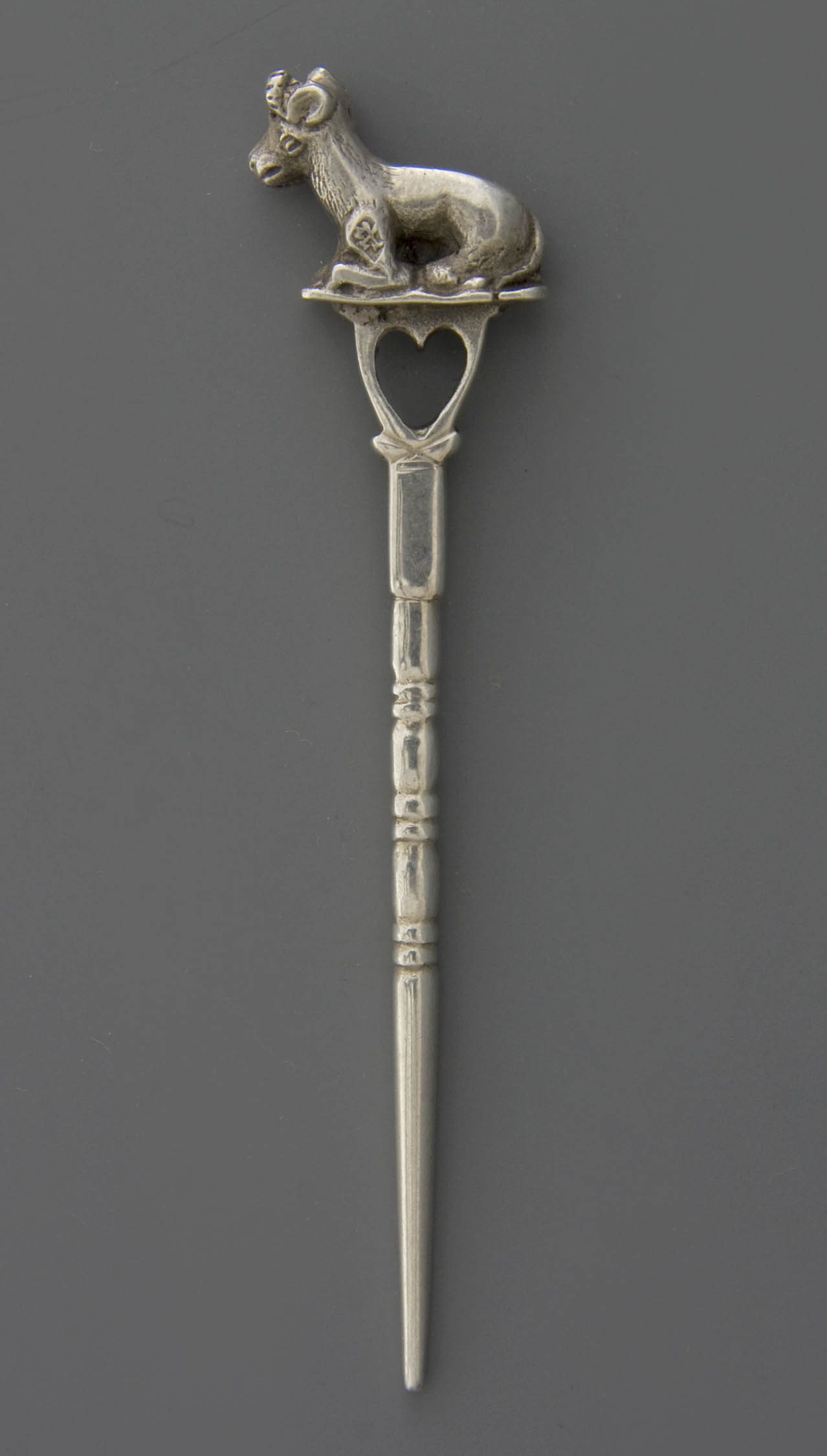
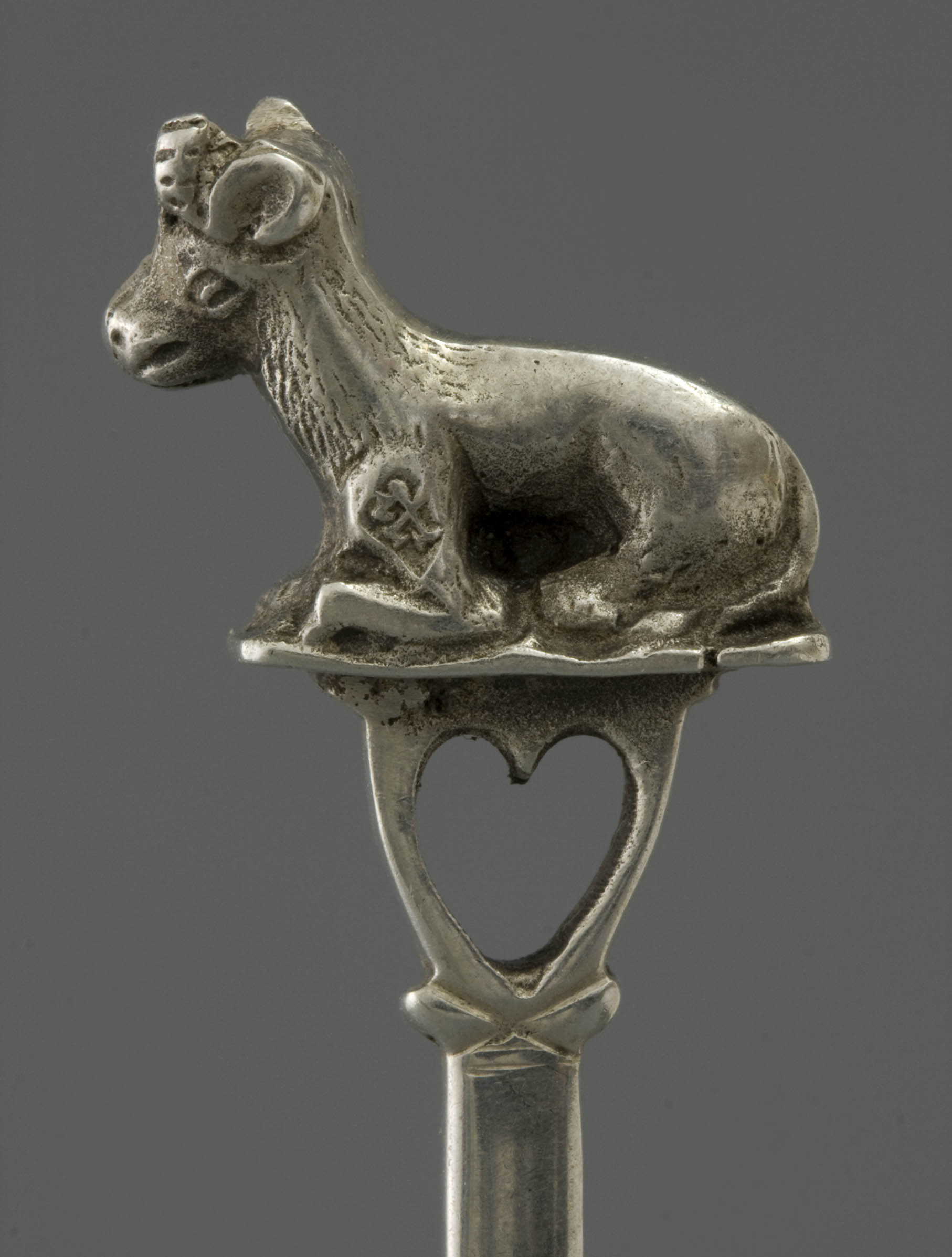
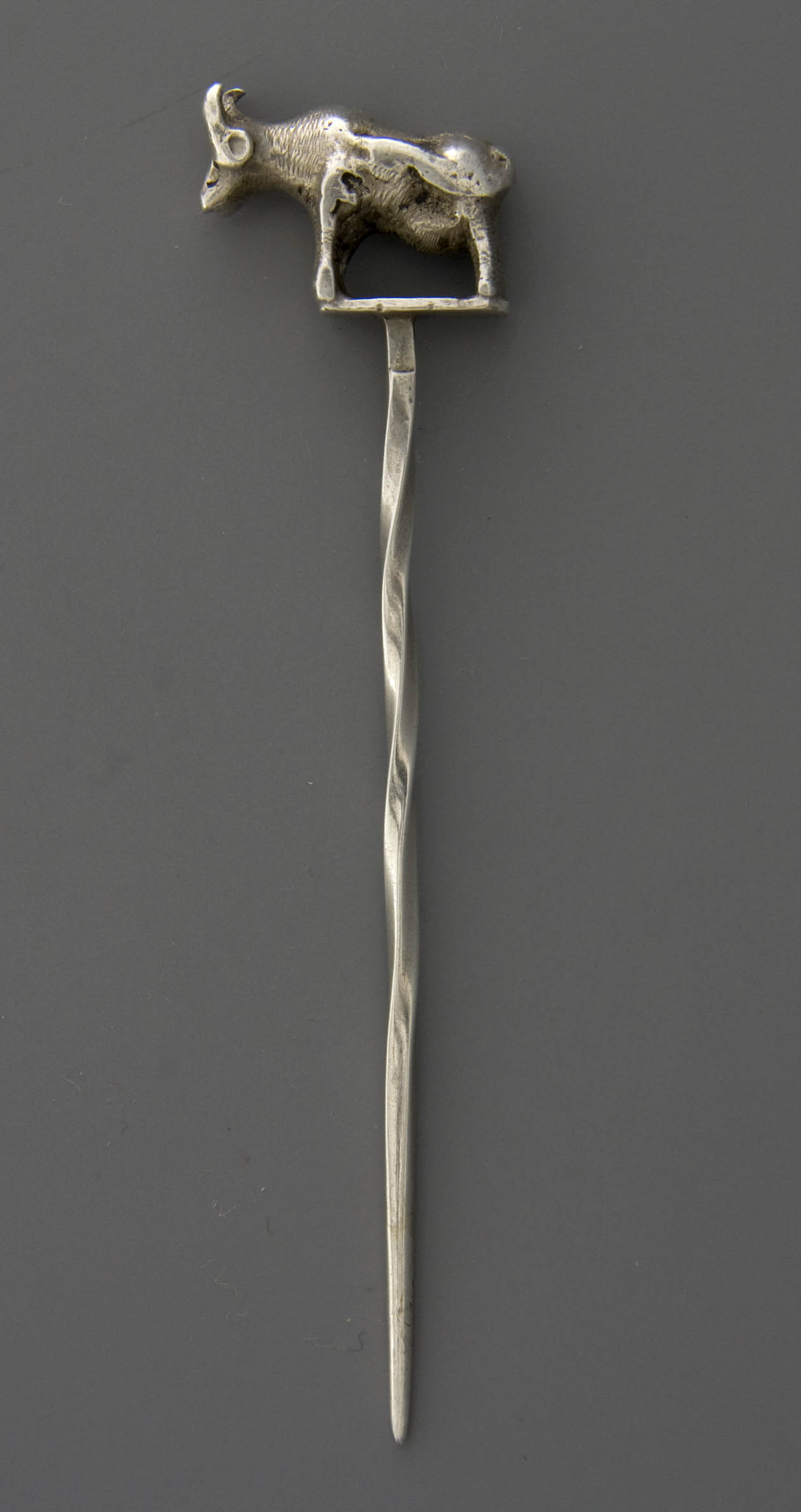
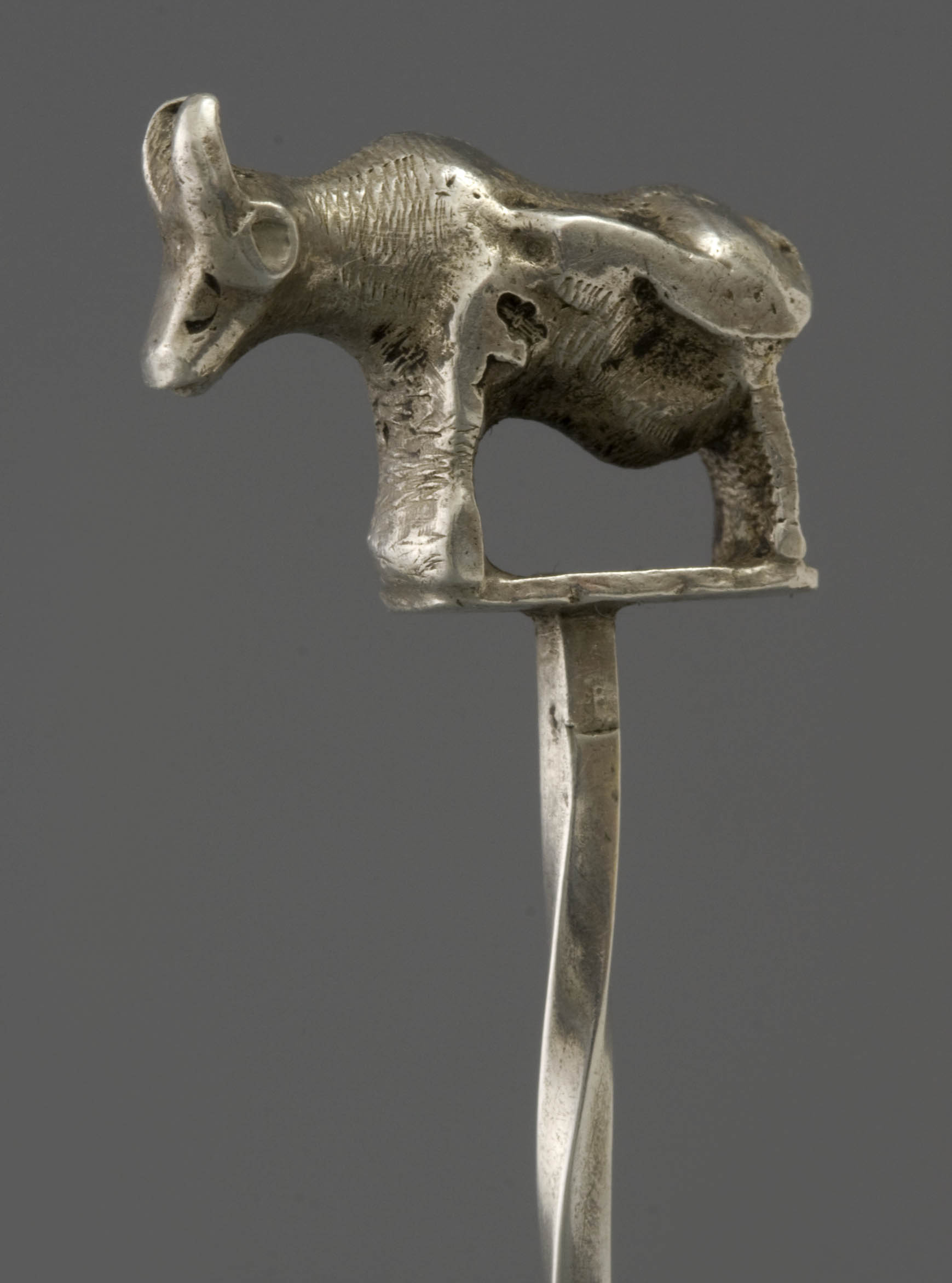
That the transition from the tight pin to the representation in the handle is rather abrupt may be clear. In its simplest form the pin is soldered directly on the decoration (Fig. 46), a plain base is another option (Figs. 24, 28). Soon the silversmith is looking for a softer, more gradual transition. From 1800, a U- (Fig. 29) or V-shaped motif (Fig. 15) is added to the top of the pin, which, as a sort of pedestal, carries the representation of the handle and makes this transition more gradual. That fashion stays in use until around 1860, although it never becomes really common.
Gradually the finish of the silver pin changes. Simple mechanical spiral shapes are replaced by filing work (Figs. 7, 45), which is more labour intensive but also gives the object a more luxurious look. Occasionally, smooth twists are alternated with roughened edges to obtain a more vivid result (Figs. 5, 20). They point to an increase in luxury which indicates that the pipe cleaner has become an established item with a growing status.
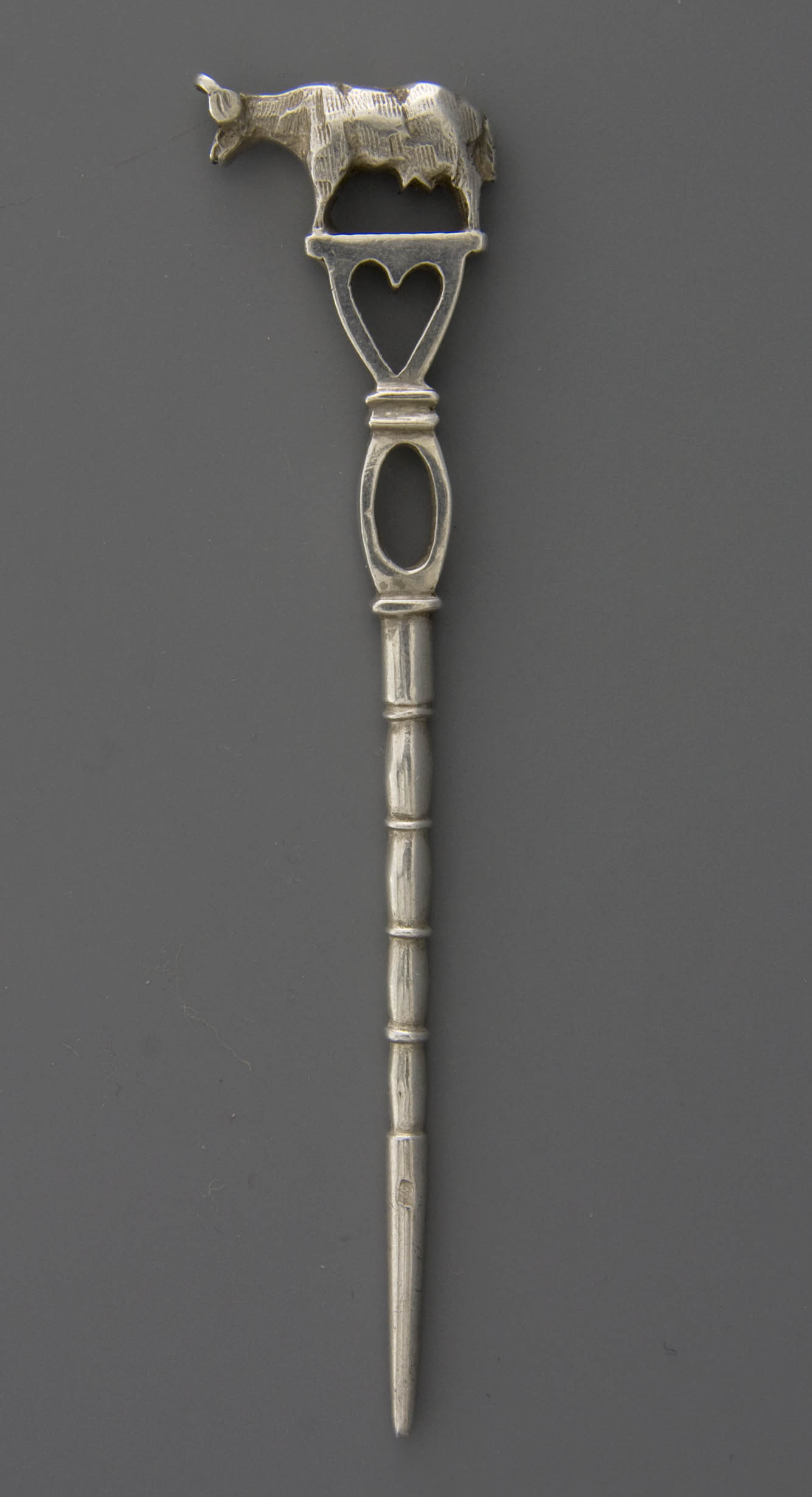
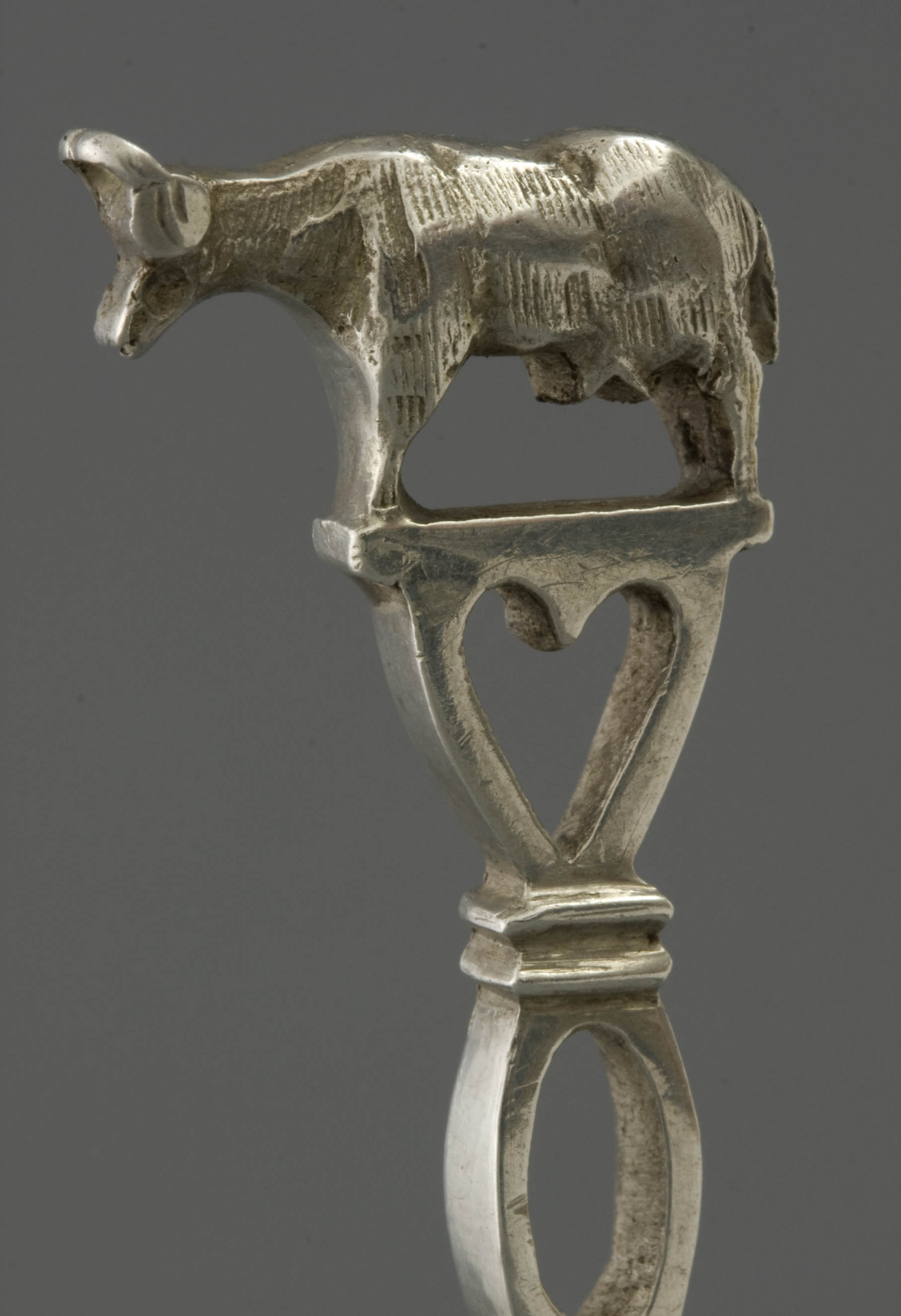
Finally, the twisting is replaced for an articulated stem in which oval knots, beads and cylindrical zones alternate (Figs. 4, 8, 49). These decorations are usually made with the file. The use of a simple lathe for this work would have made the work much easier, although no such examples are known. Viewed from a different point of view, the hand filing also adds a traditional charm to the product. From 1850, such filed stems become more common. While the twisting enforces regularity, the filing gives way to more variation. It seems even that filing was done emotionally, taking into account of course, the wish for a more modest decoration towards the point.
A typical motif on the transition to the crowning is a shape of four pillars, between which one or in a rare case two silver balls can freely move up and down (Figs. 5, 15, 42, 45). That design has derived from the wooden pipe cleaners as an ultimate proof of the craftsmanship of the carvers. They managed to cut the balls between the four styles, so that they moved without falling between the styles. For the silversmith adding a ball was of course no proof of craftsmanship, since the separate parts of the cage were soldered together. The columns originate of the beginning of the nineteenth century and are popular until the 1840’s. Above these pillars we often see a second opening with a heart shape (Figs. 4, 7, 19, 33, 36). It is a nice alternative of the U and V shapes, particularly appropriate when the pipe cleaner is a gift item. For a long time this heart motif will be a popular transition between the pin and the handle.
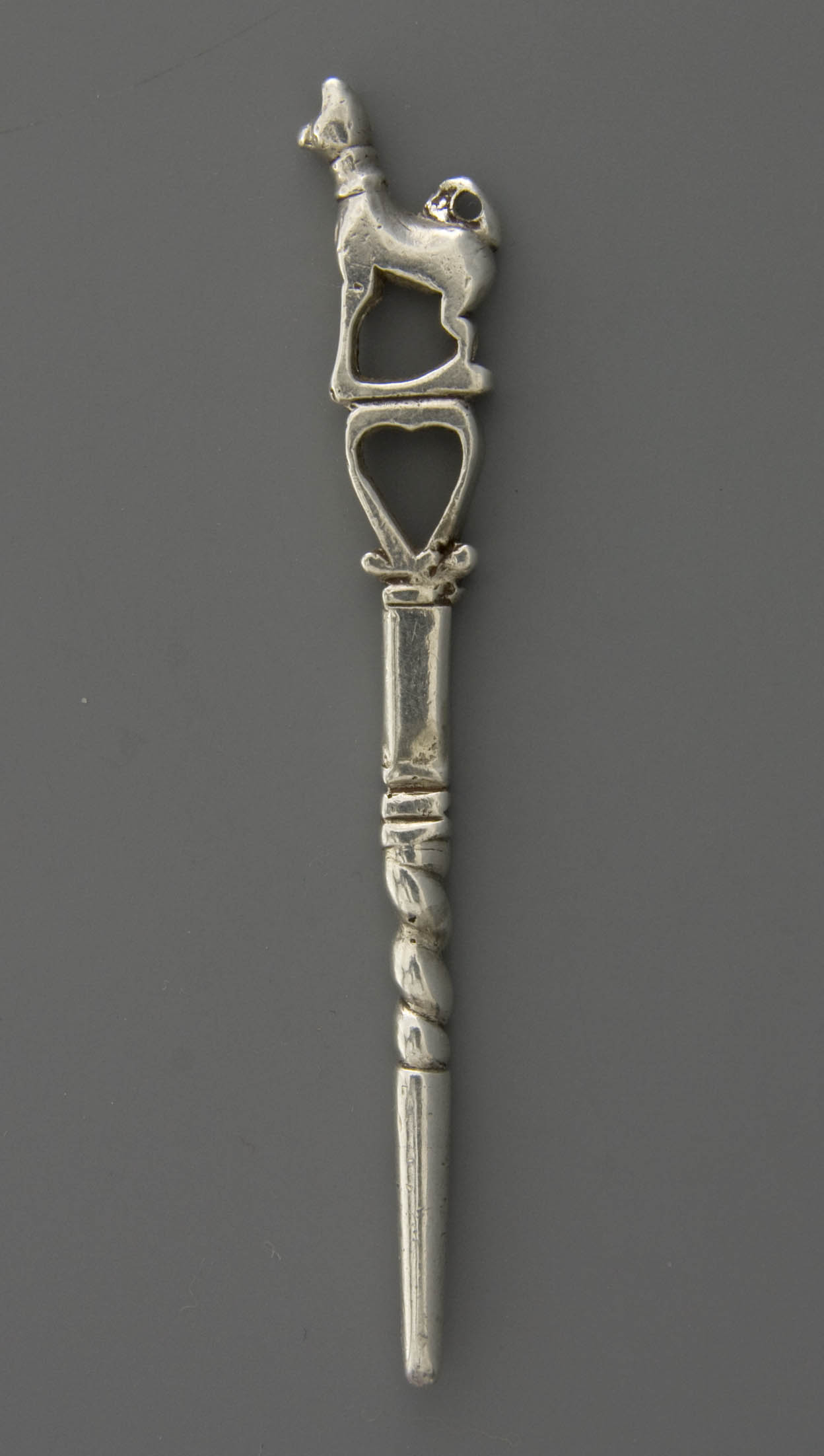
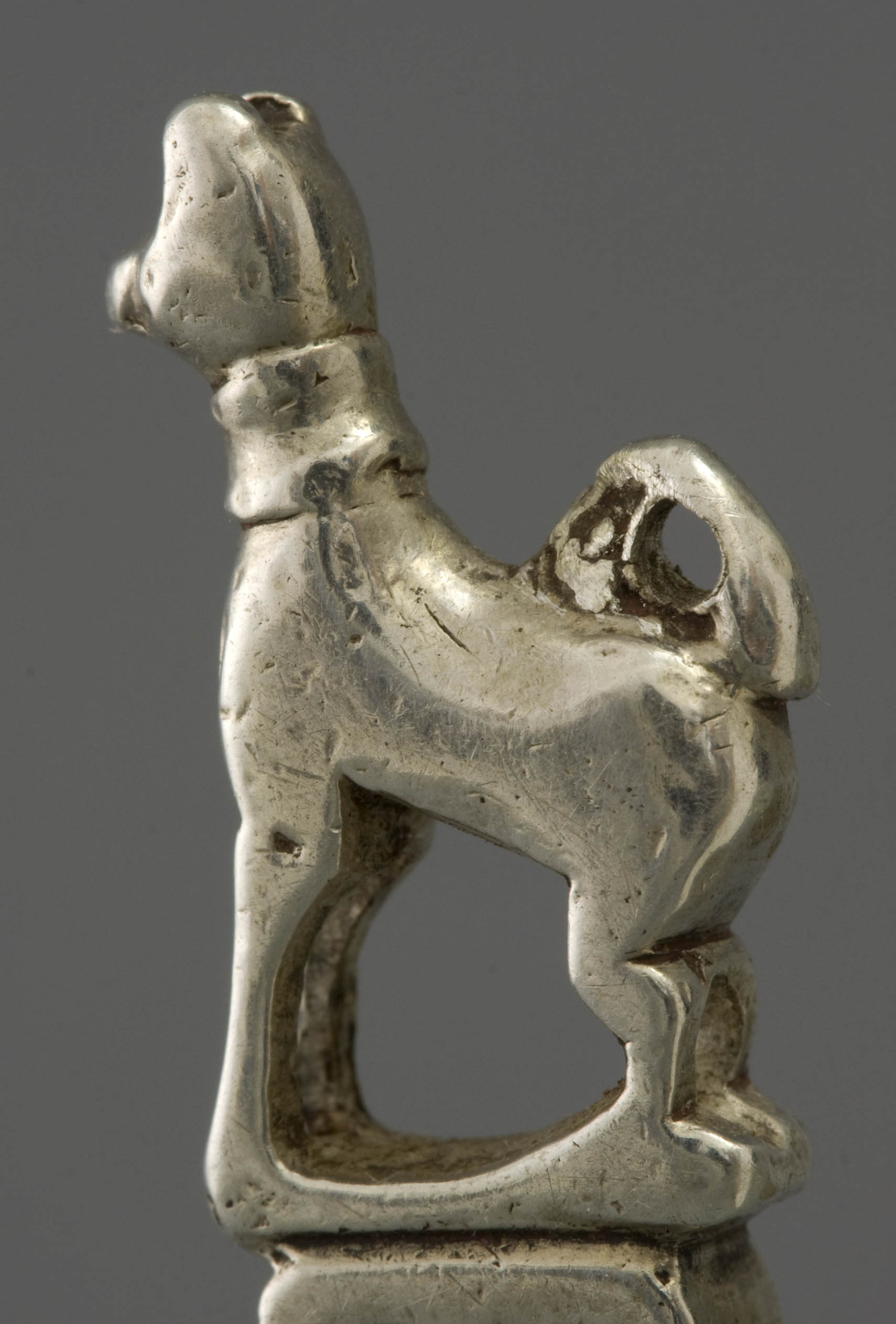
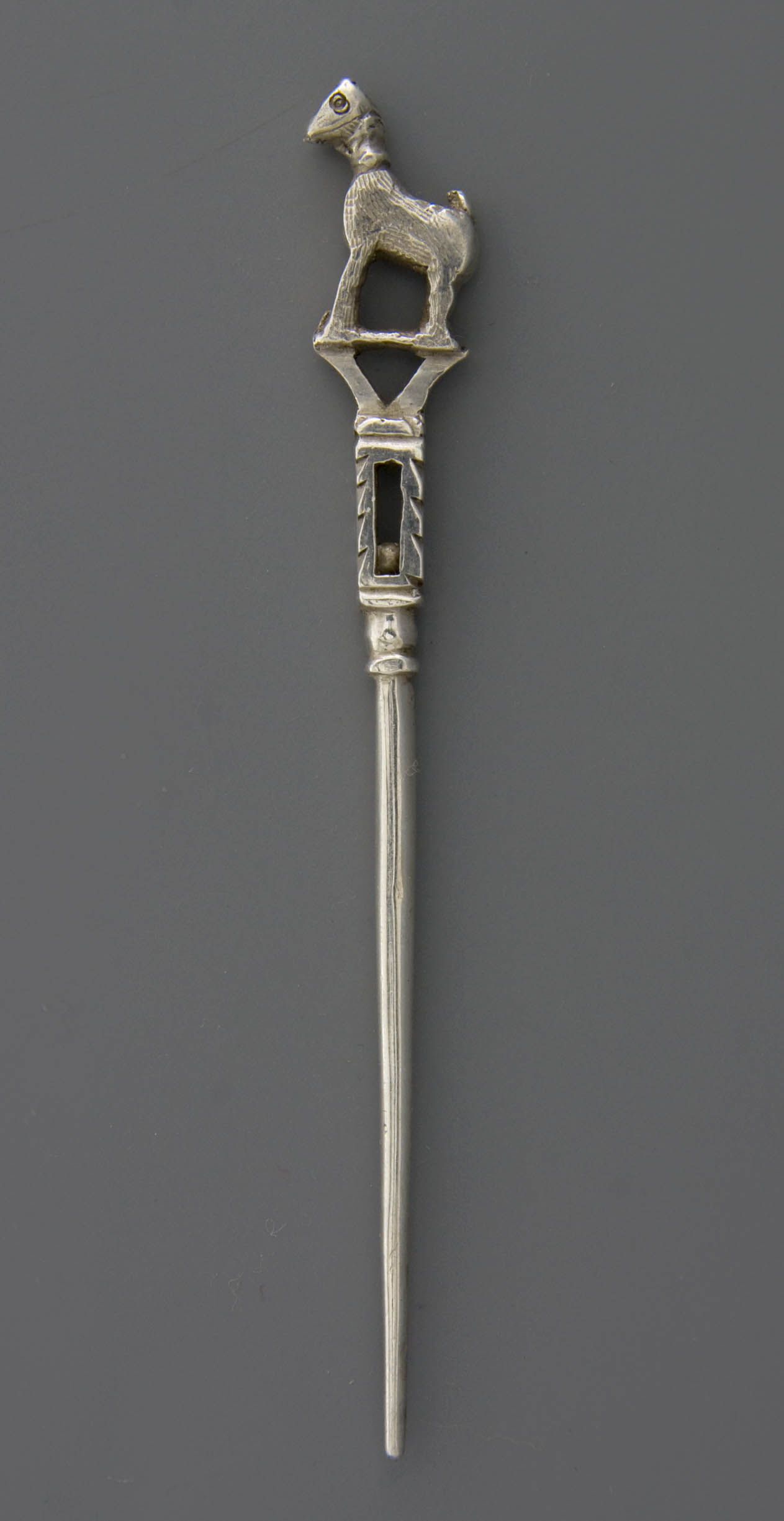
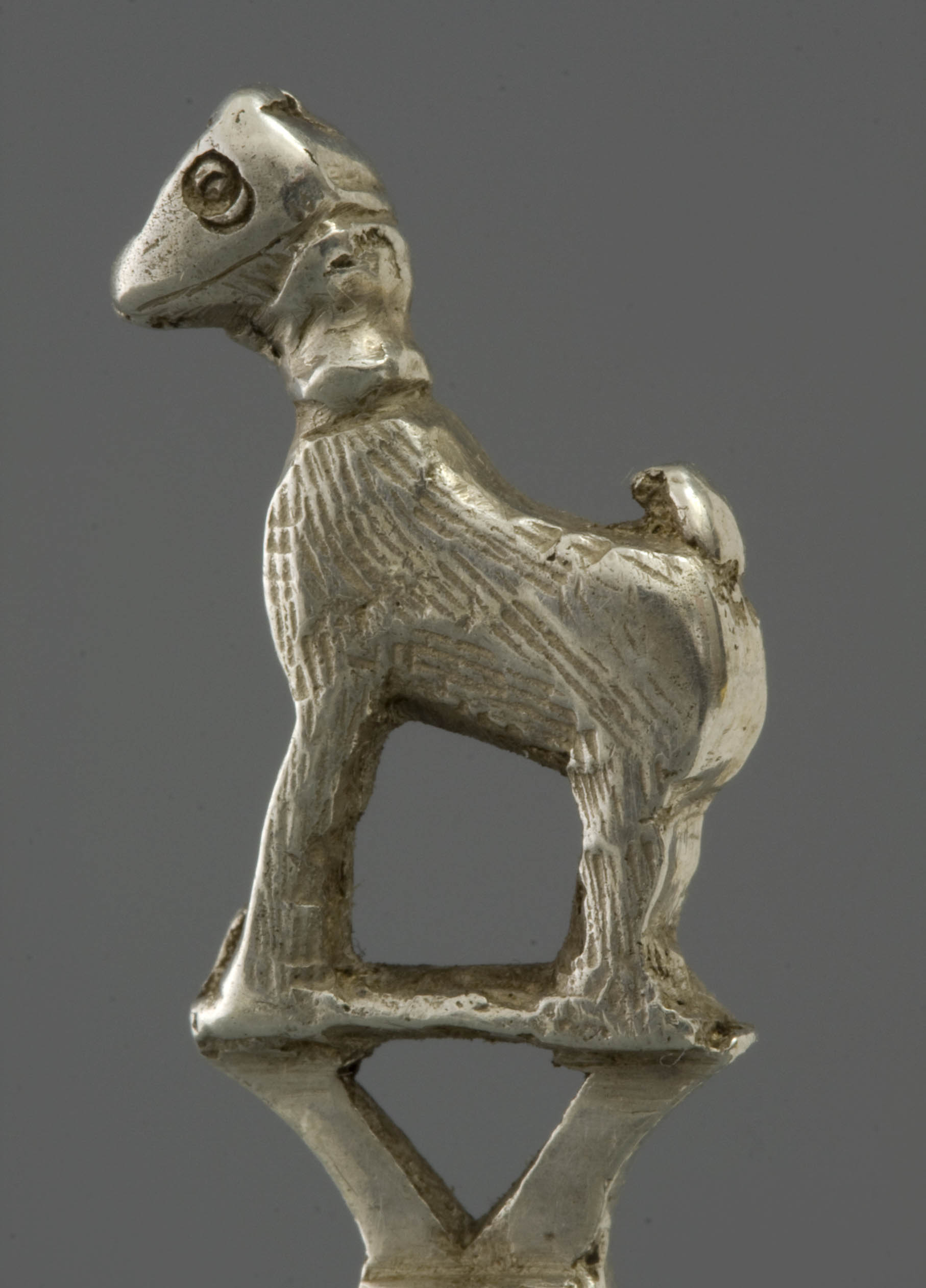
The four pillars are a fashion phenomenon and disappear again to transfer in a simple flattened handle in which the rectangular opening remains (Figs. 19, 30, 36), but now cut or sawn. In this way one maintains the gradual transition from pin to handle, but a single opening can be made faster. Another advantage is that this shape is stronger, which is important for an device to carry in the pocket. In turn, this reminiscence on the pillars soon transforms into a standing oval shape (Figs. 4, 8, 12, 49), which is more elegant and fits better with the heart shape that remains unchanged. The pin with heart and oval openings are very common. The popularity lies between 1850 and 1880, but even today silversmiths still copy this design.
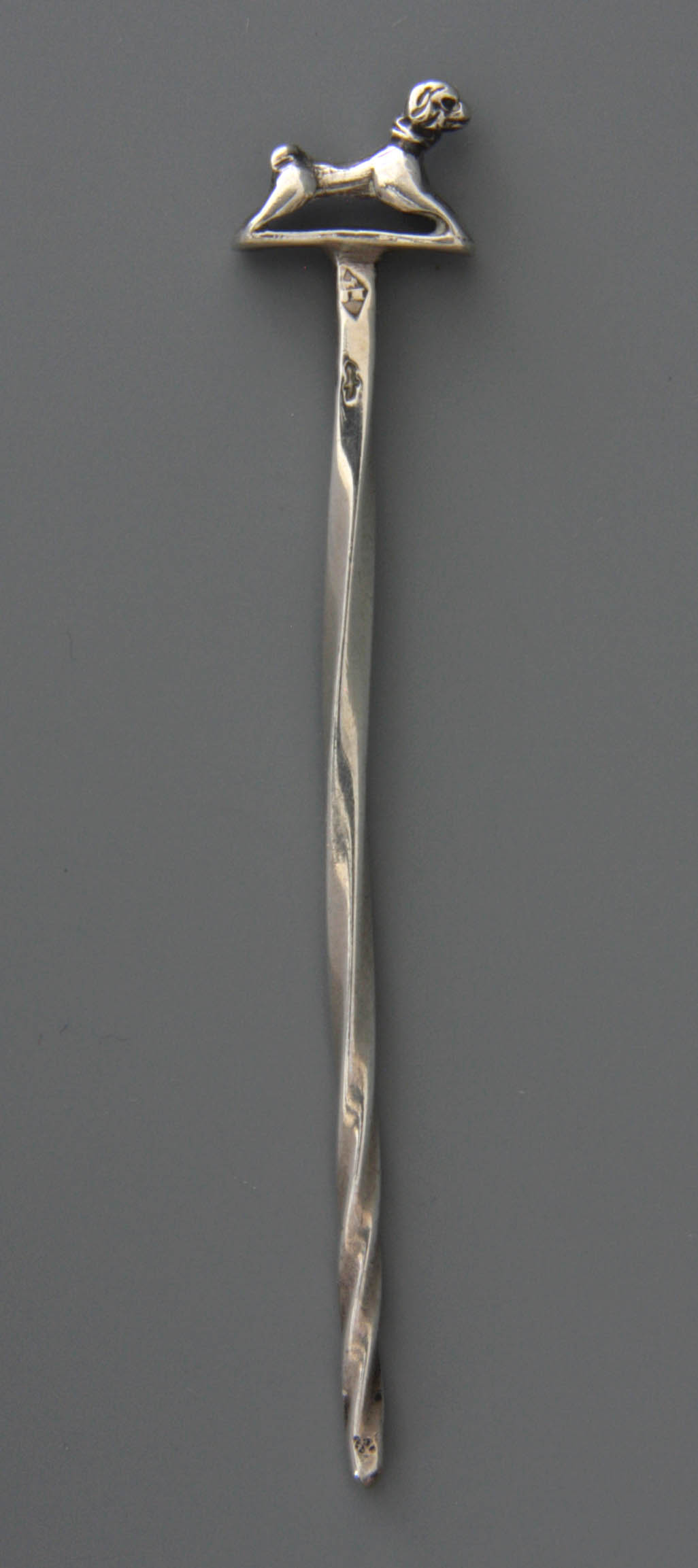
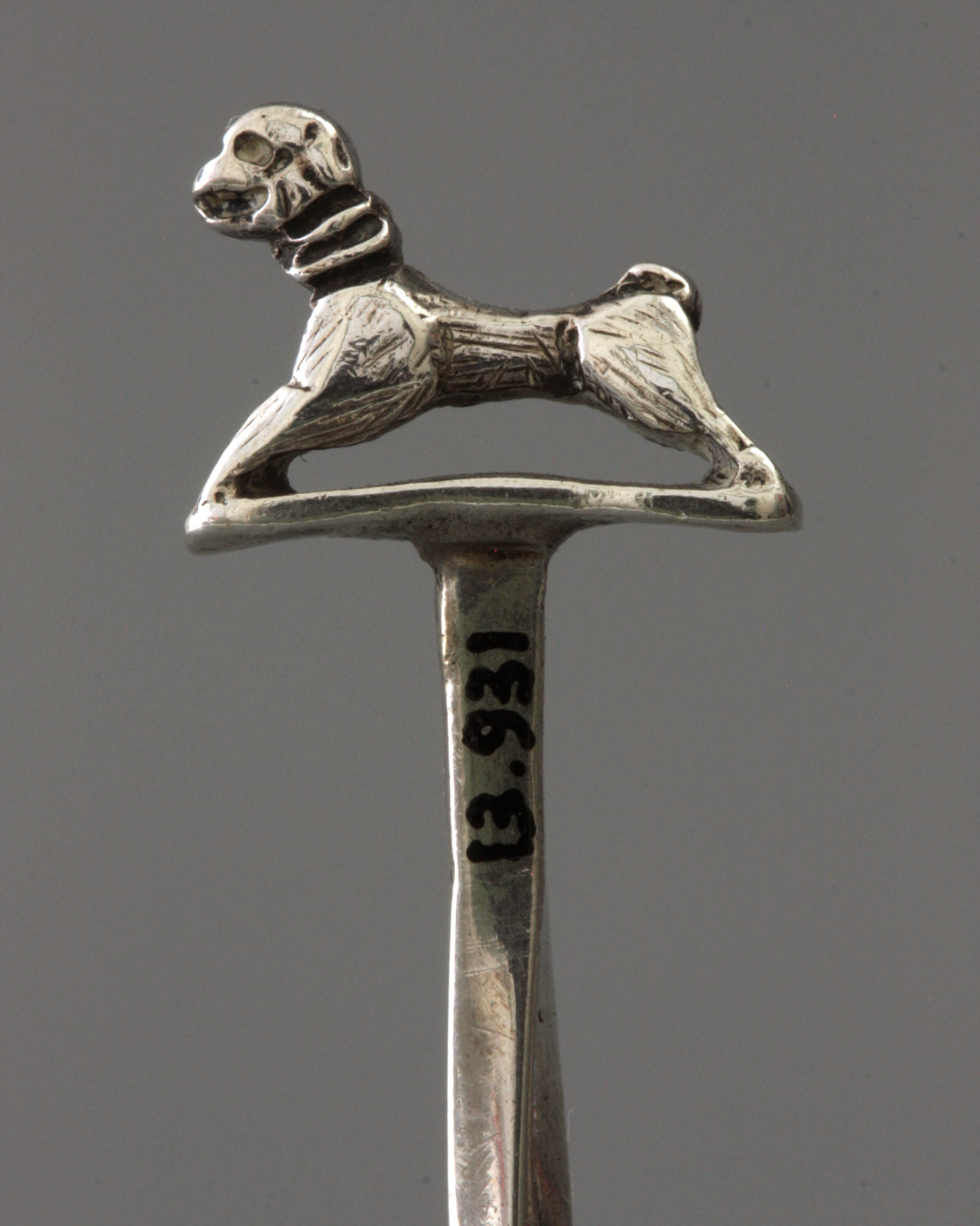
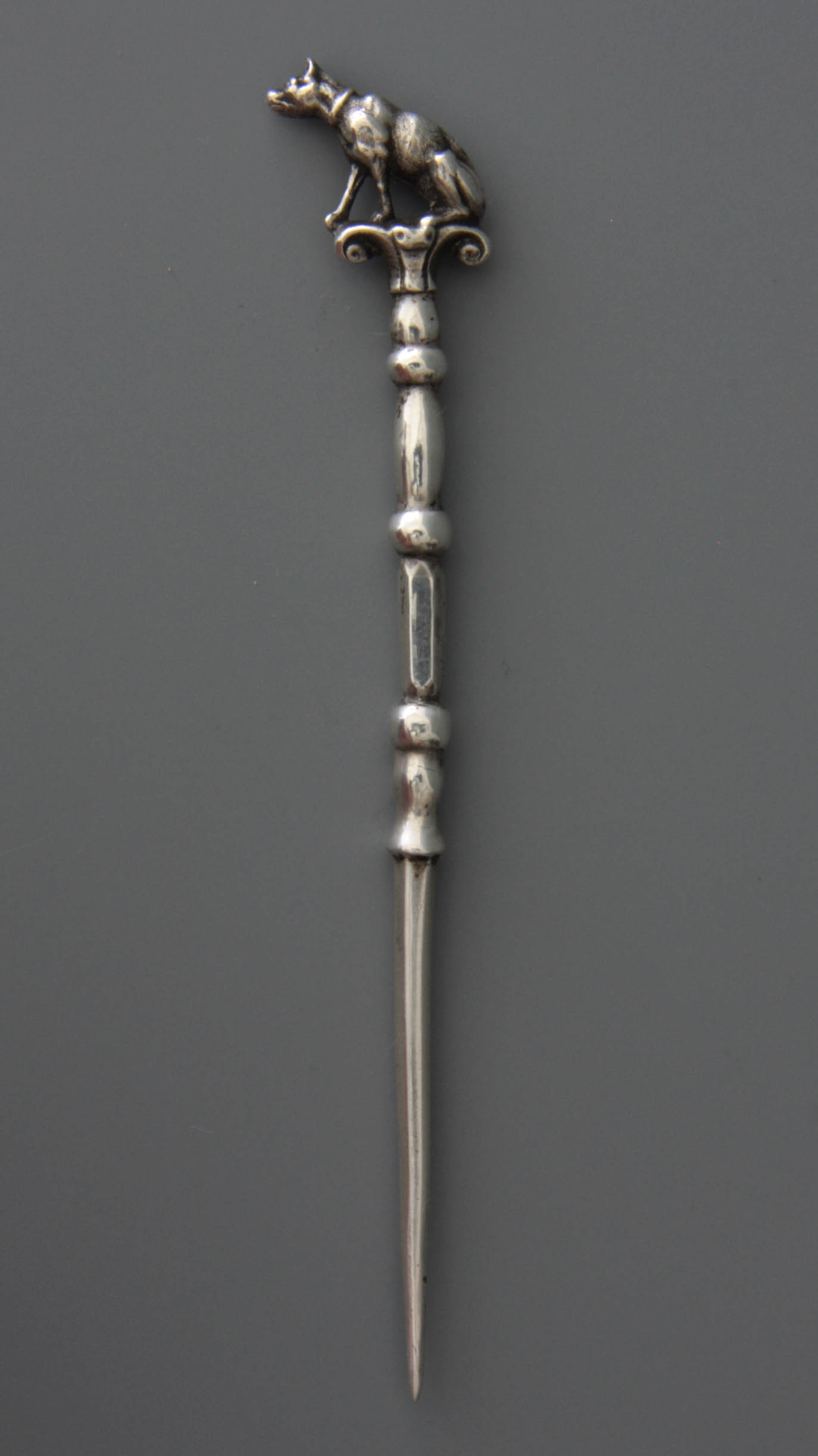
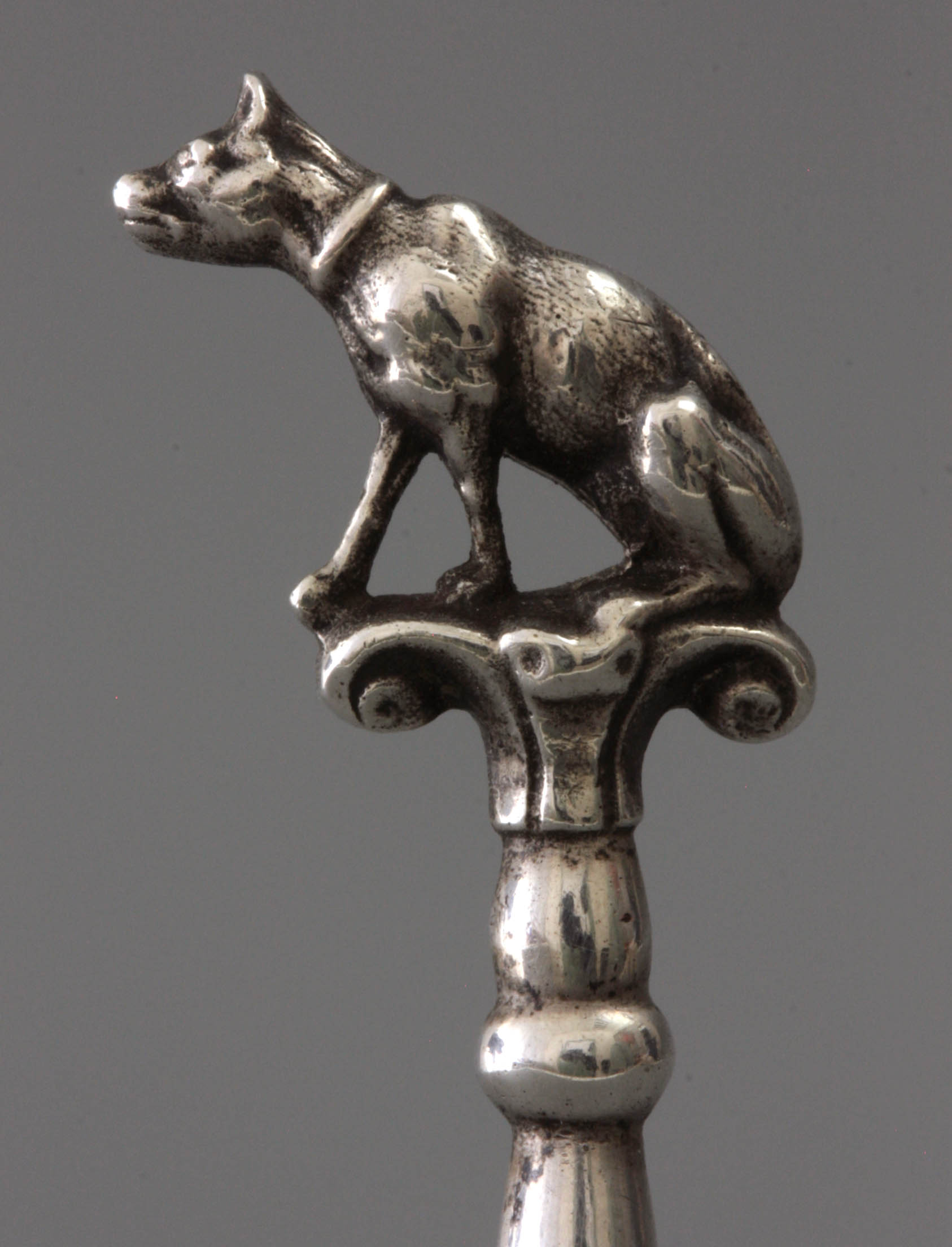
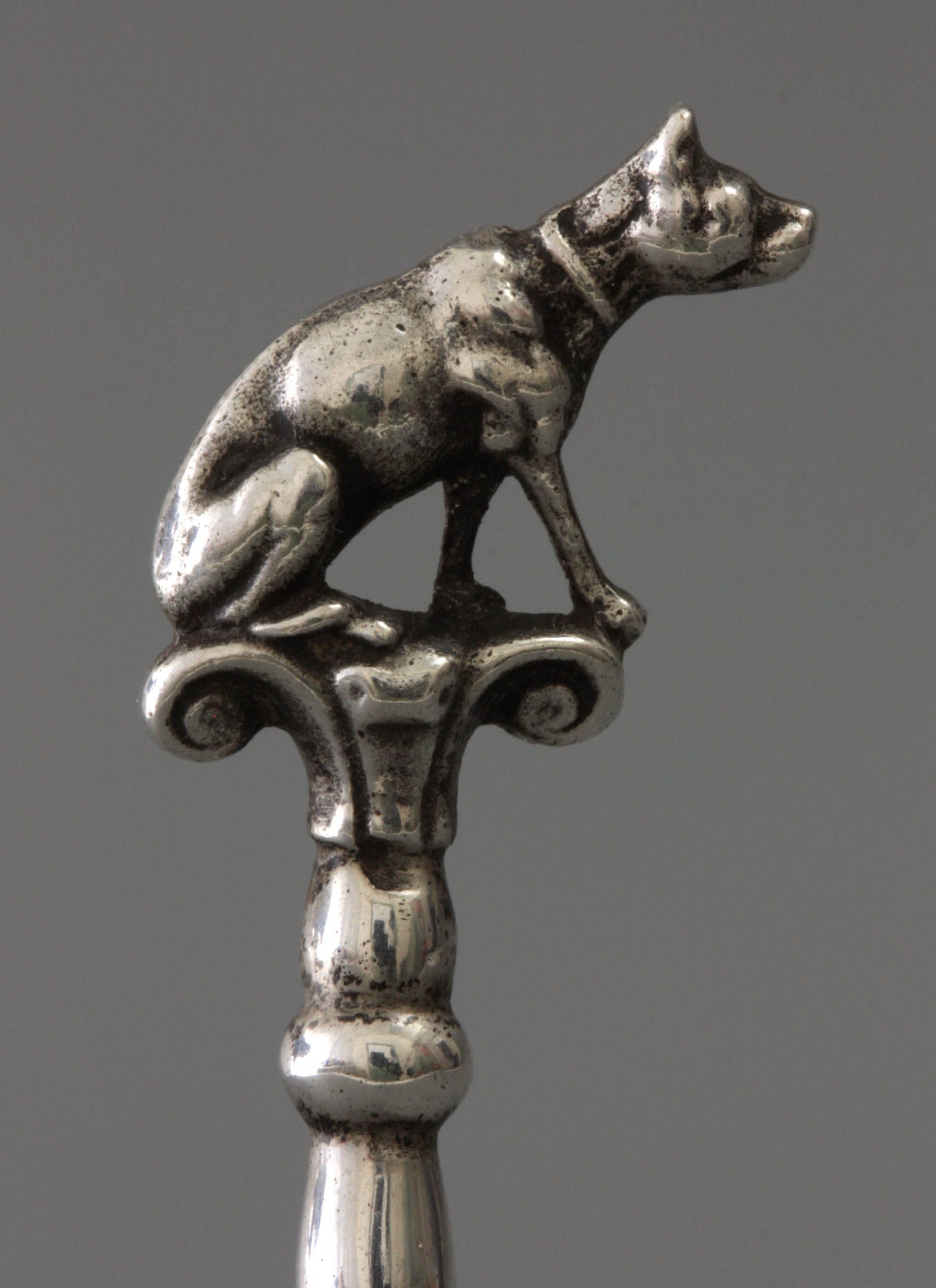
The shape development of the cleaner pin runs from a simple, slightly twisted pin to stronger articulated spikes, in which the step-by-step transition to the handle gets more and more attention. That the silver cleaner follows the folk-art wooden and bone examples is proven by the moving ball between struts. The development is finished when the handle of the cleaner shows three to four steps. Of course, in addition to the multiple stacked up motives, the single pins remain. After 1880, the pipe cleaner loses its significance and no new pin varieties will arise. Silversmiths copy existing examples from that moment on.
A beautiful, relatively modern cleaner is an exception to this rule due to its new design (Fig. 17). Here the transition to the crowning is marked by a capital like the end of a column, while the pin shows an elongated hexagonal part between nodes. The end piece is tapered, not round in diameter as usual but also hexagonal. The capital and the hexagonal pin are both new elements, in addition to an unusual rhythm in the object. Finally, the crowning has been designed beautifully.
Handle
The most eye-catching part of the cleaner is the top or handle. The decorative depiction and its execution, together with the articulation of the pin determine the total look of the object and thus the retail price. Obviously the price of the object is the resultant of the work done and the desire to possess it provoked from the buyer. The range of depictions is more limited than one would expect and can roughly be divided into people, animals and objects.
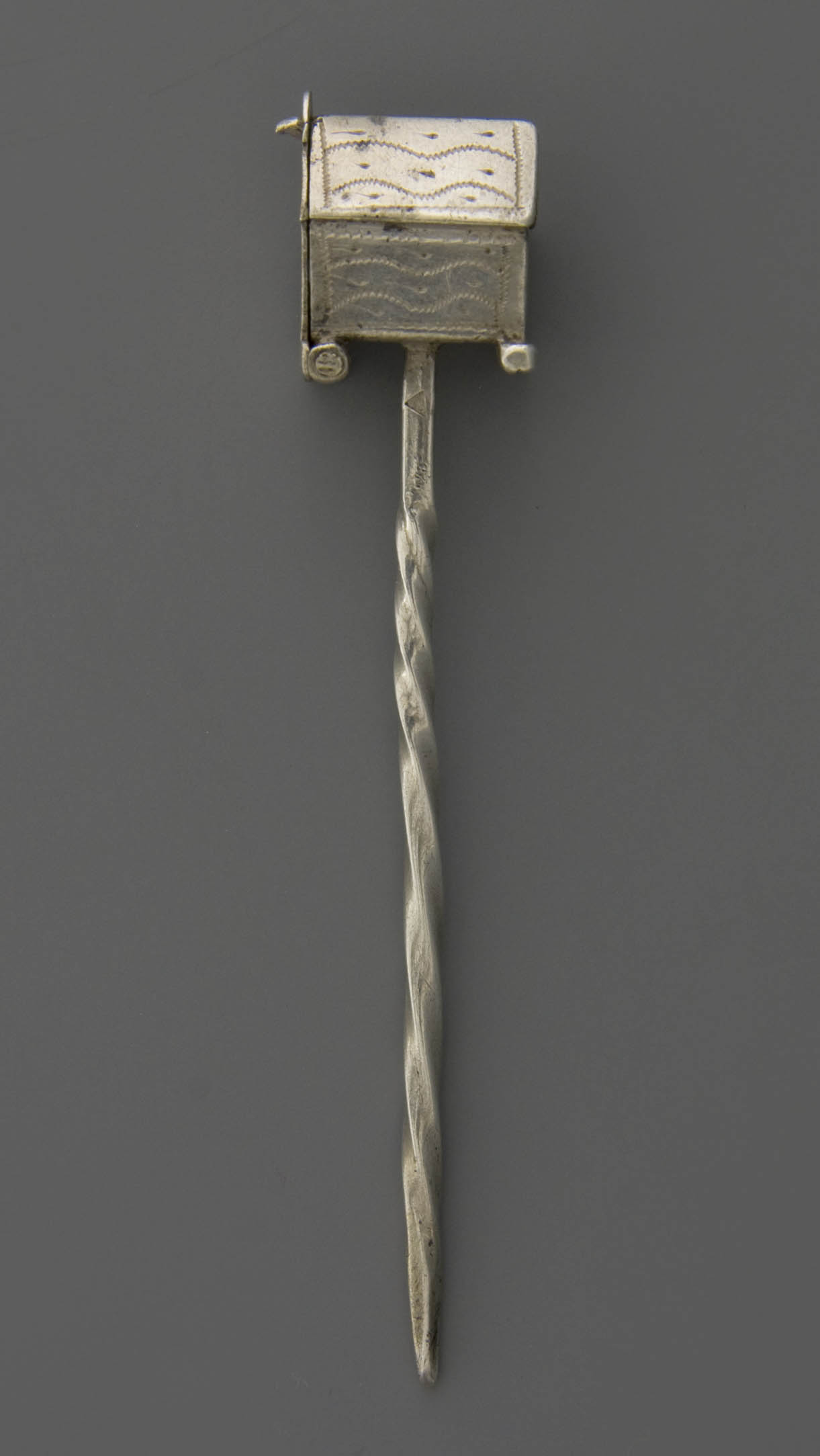
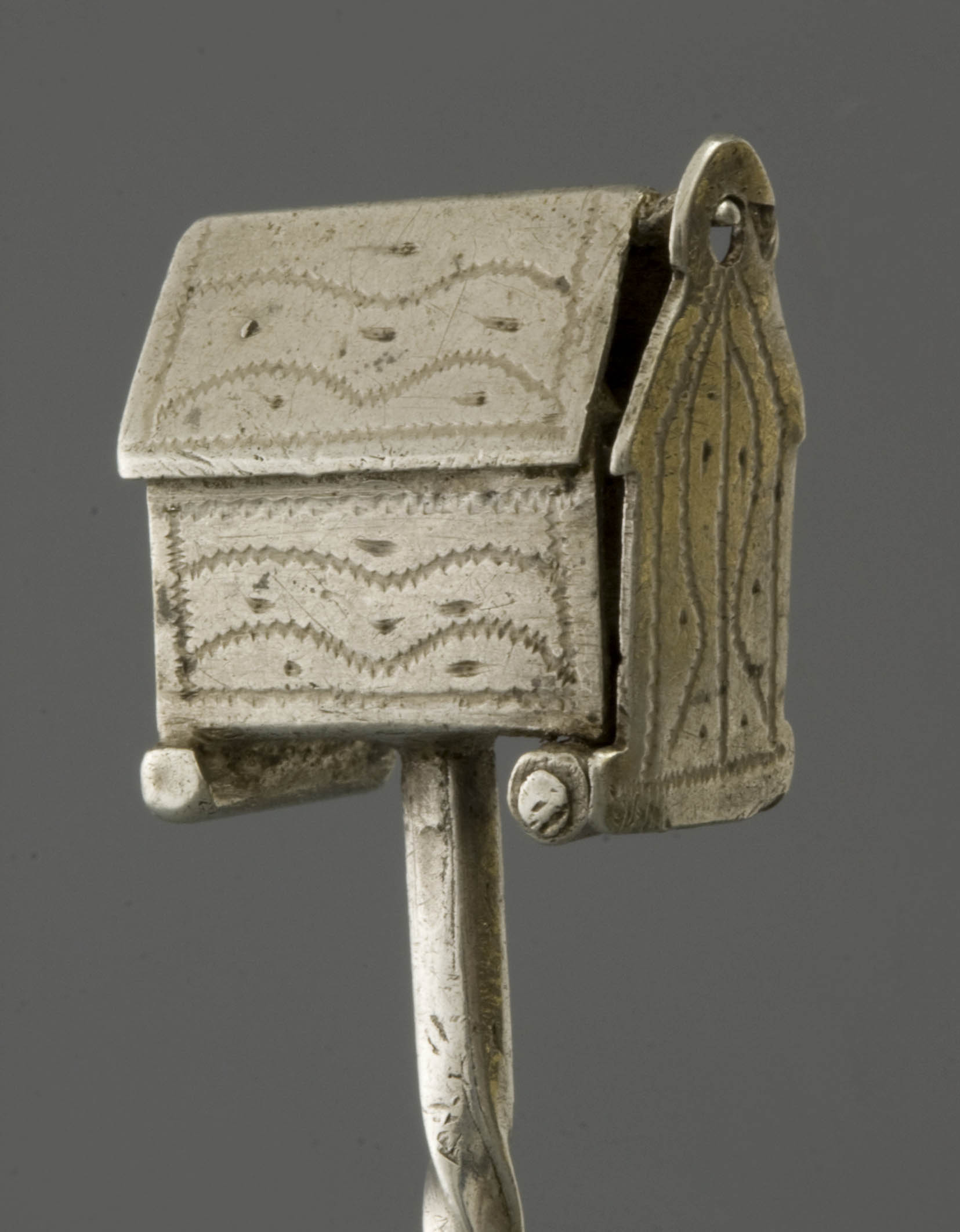
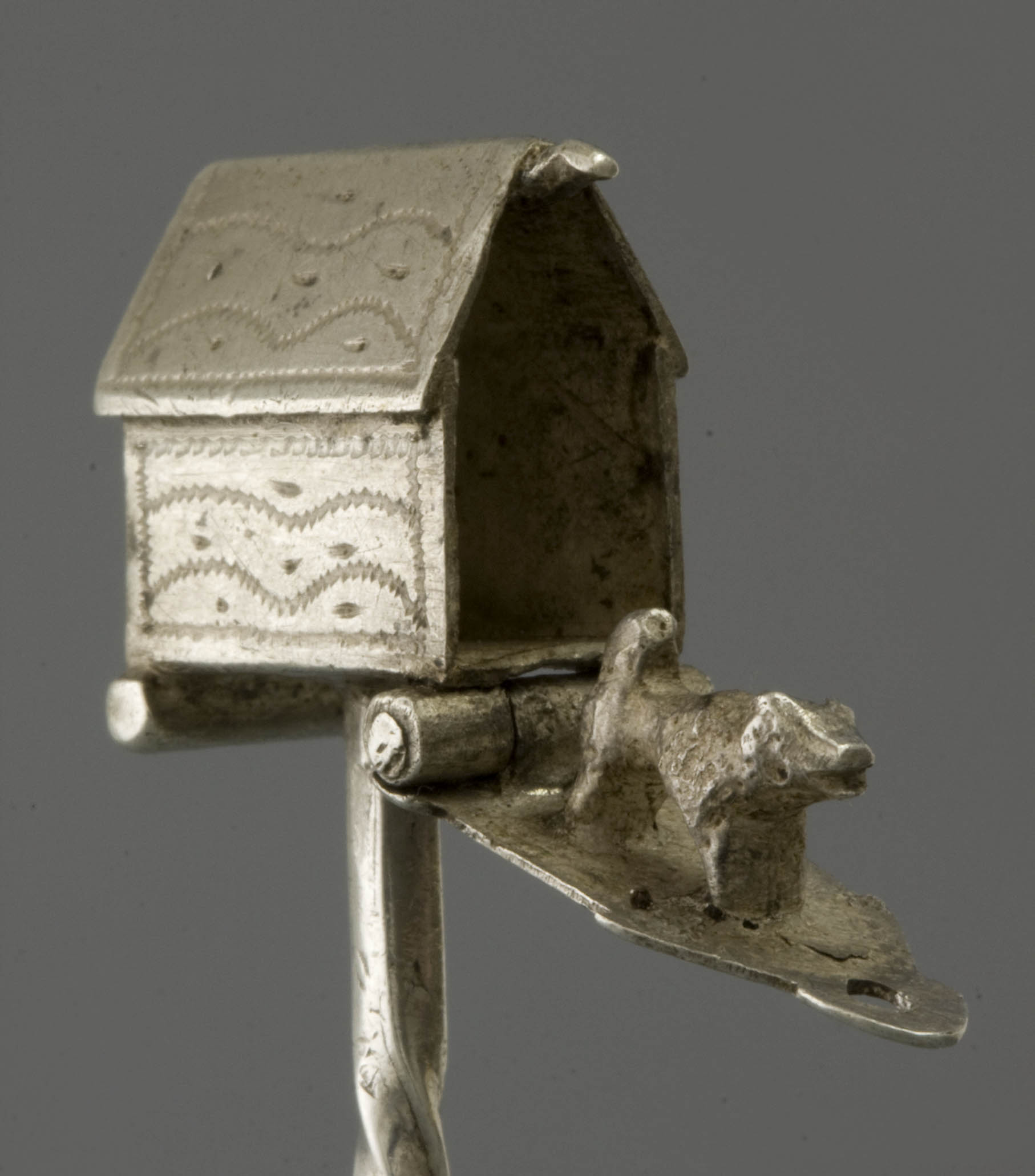
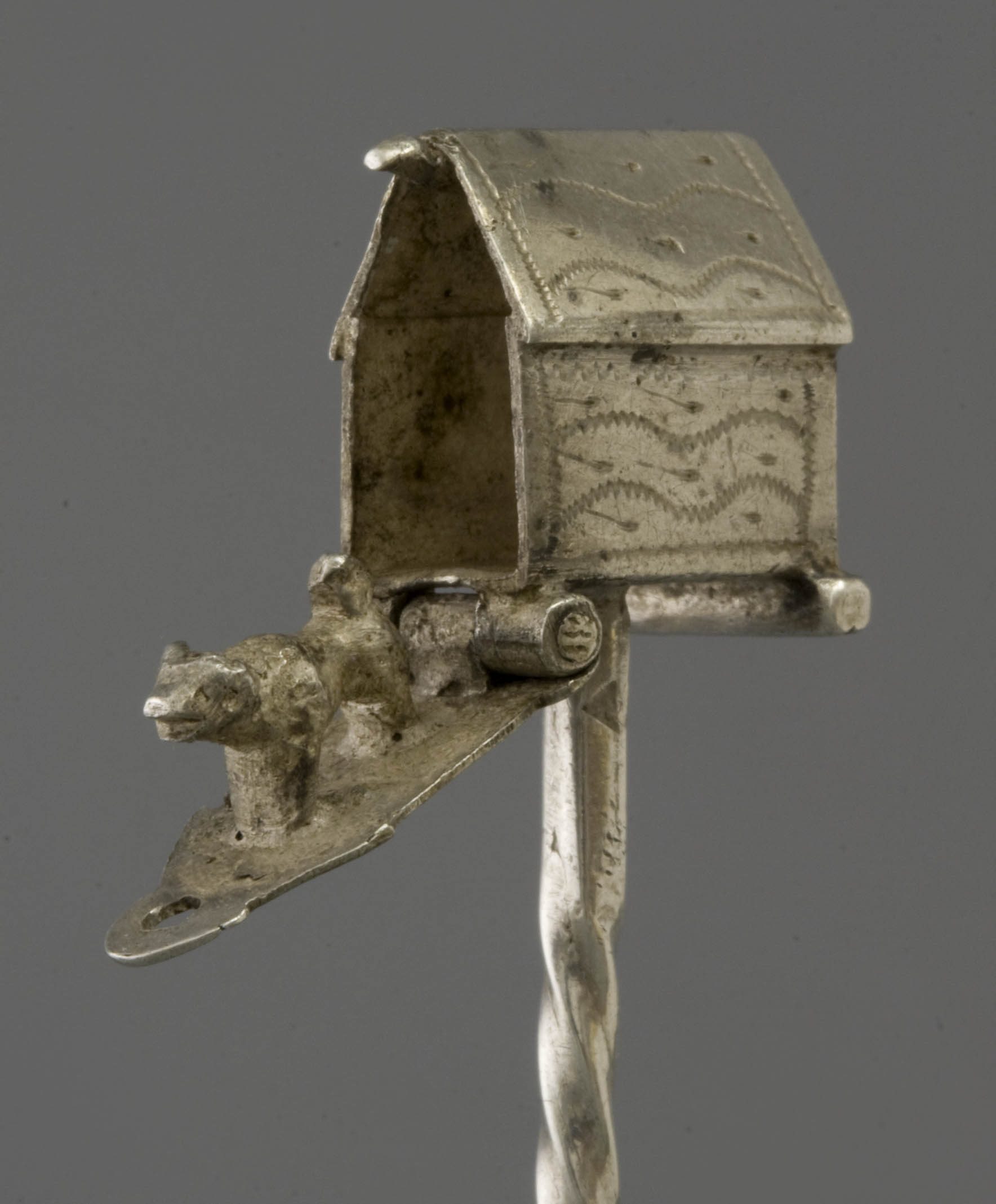
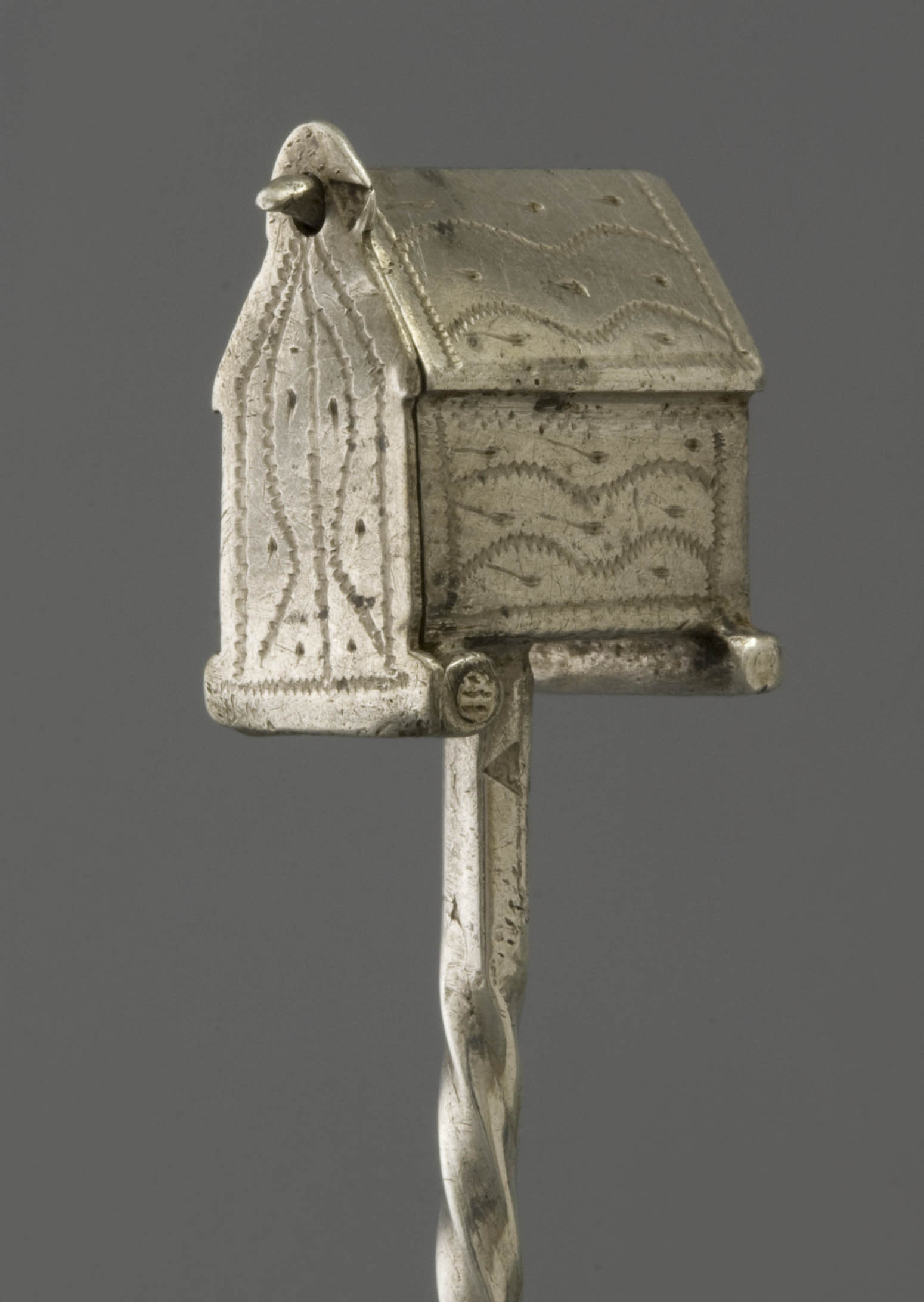
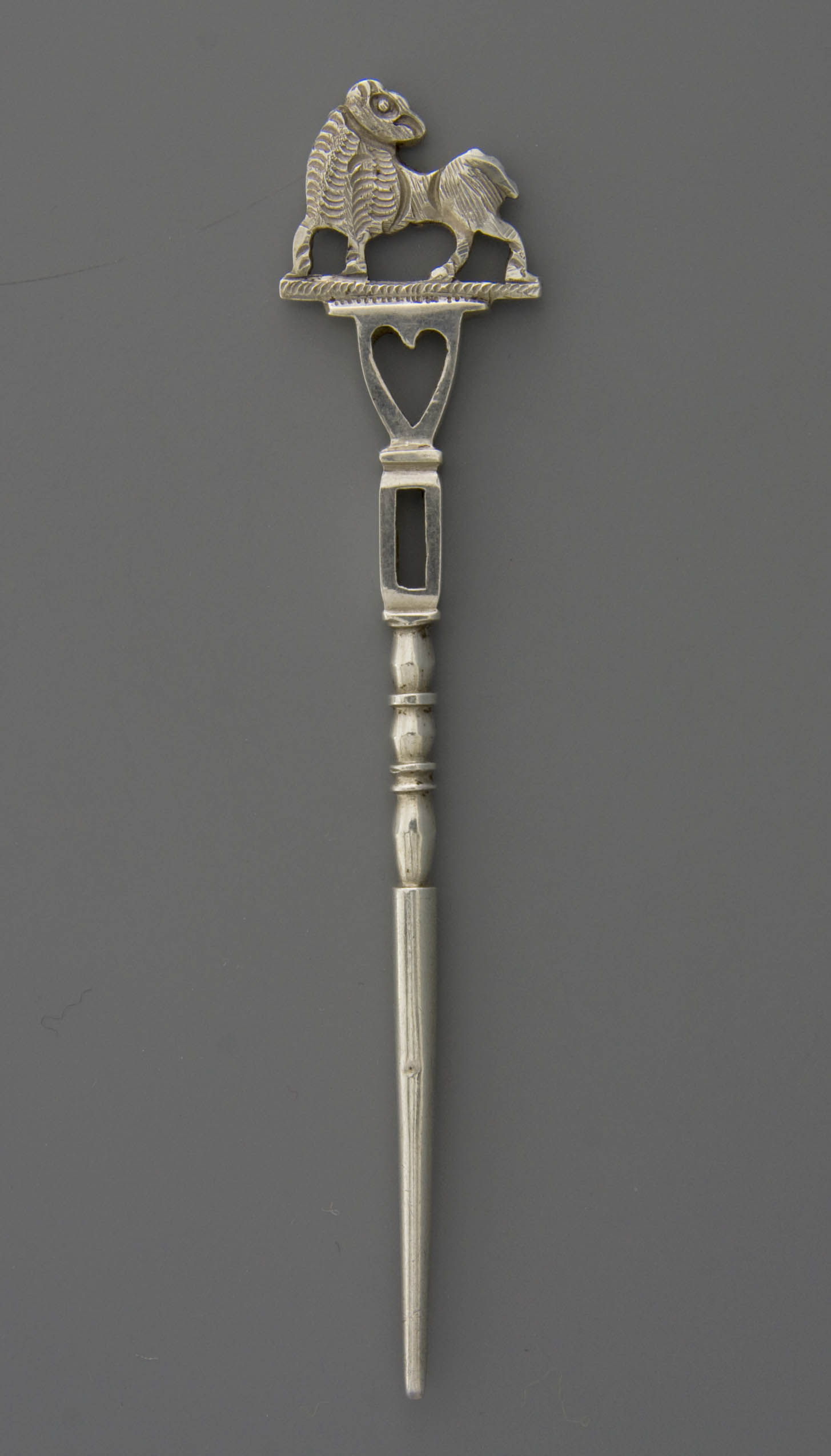
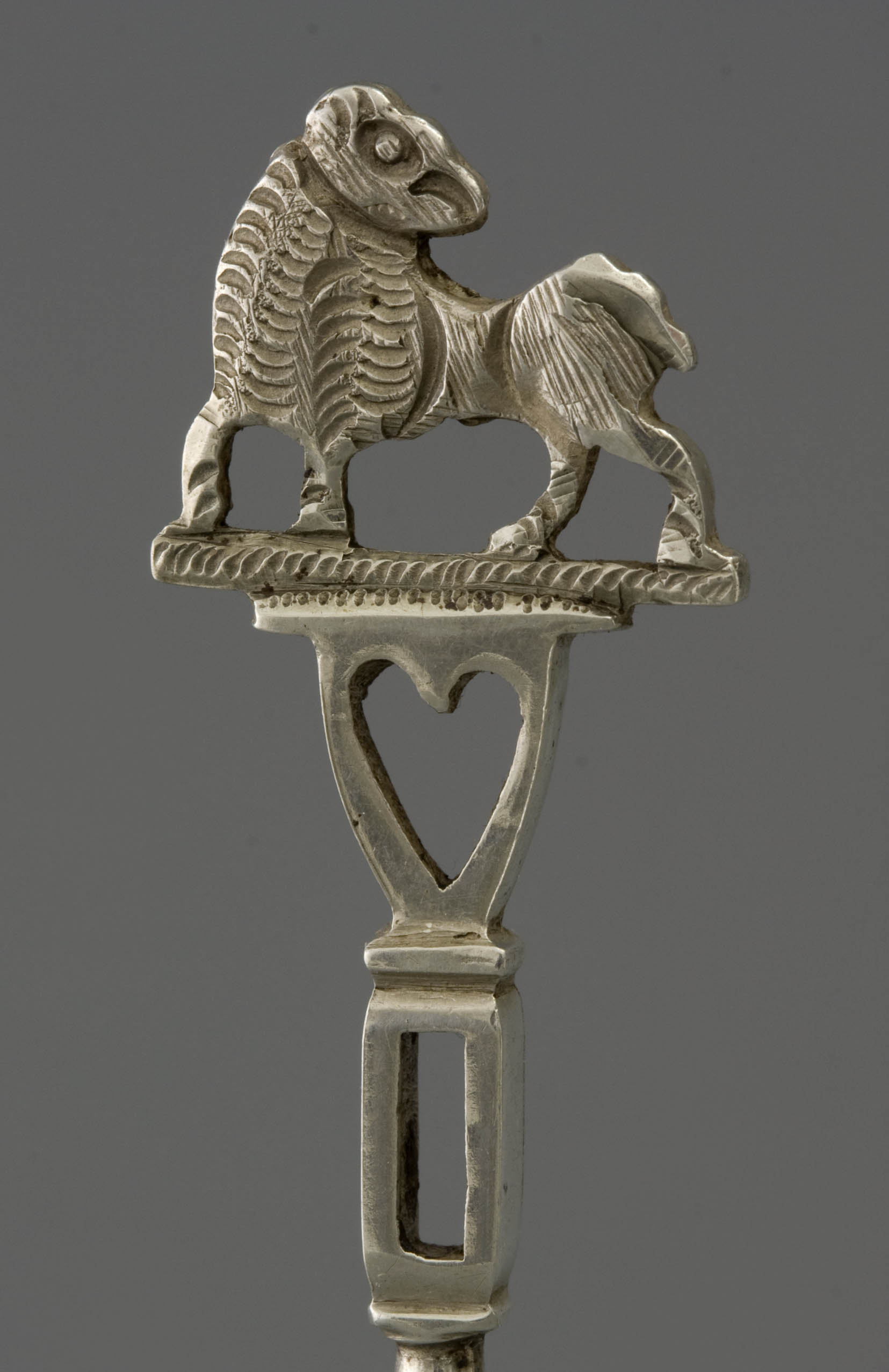
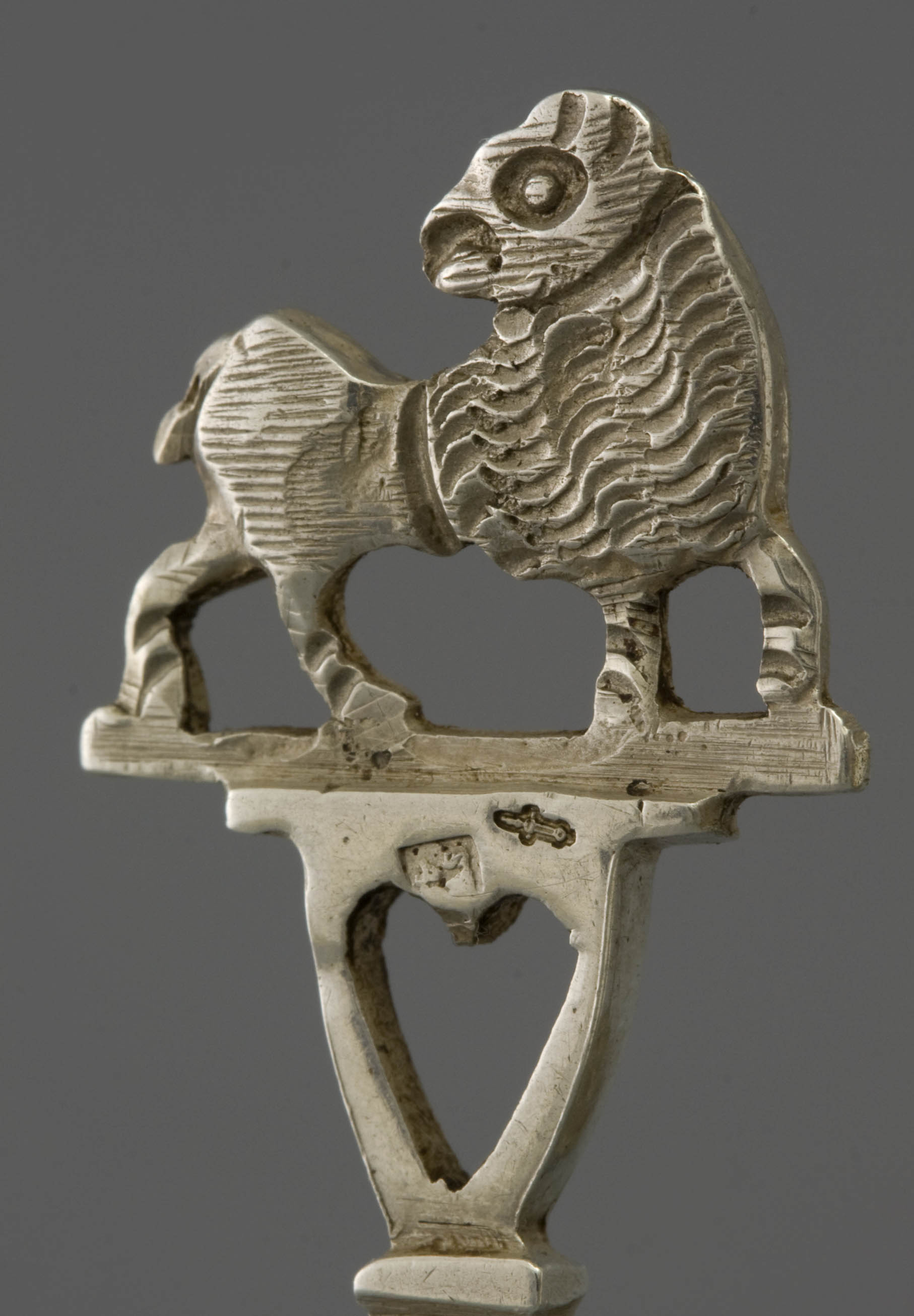
Animals are the most common, among which horses gain in popularity (Figs. 4-8). The standing horse is made in large variations. In realistic examples, the breed characteristics are sometimes even visible, such as the truncated tail (Figs. 4, 5, 7). Horses are often represented as dressage horses in the familiar stud posture with the foreleg bent (Figs. 4-6). Some show a horseman (Figs. 9-10). Yet they are not always successful, the worst example being a horse with sagging back (Fig. 8). It seems that the file of the silversmith stayed too long in the same place. Especially with the horse, meant for the peasantry, the handle has sometimes grown considerably, emphasizing the show function (Fig. 4).
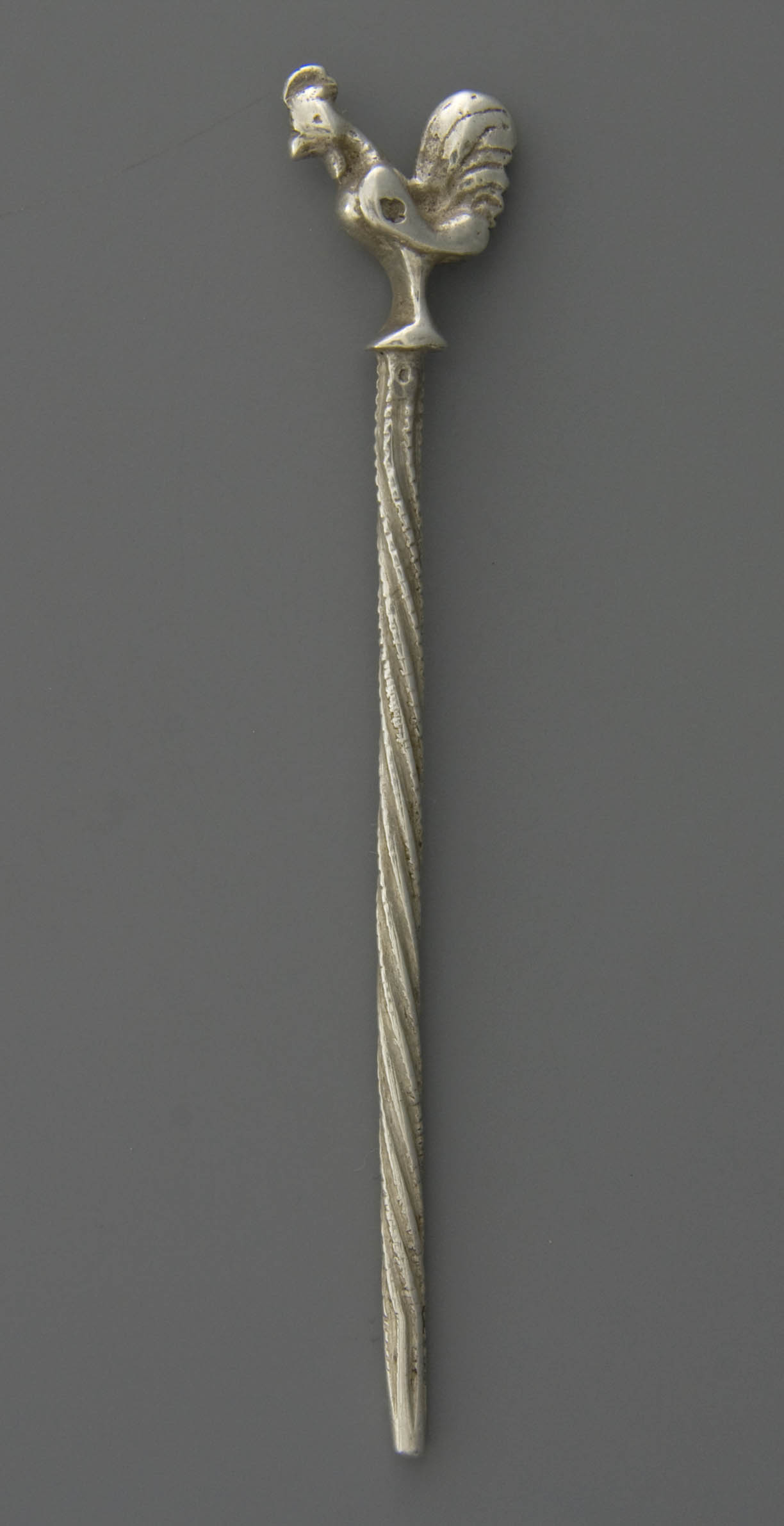
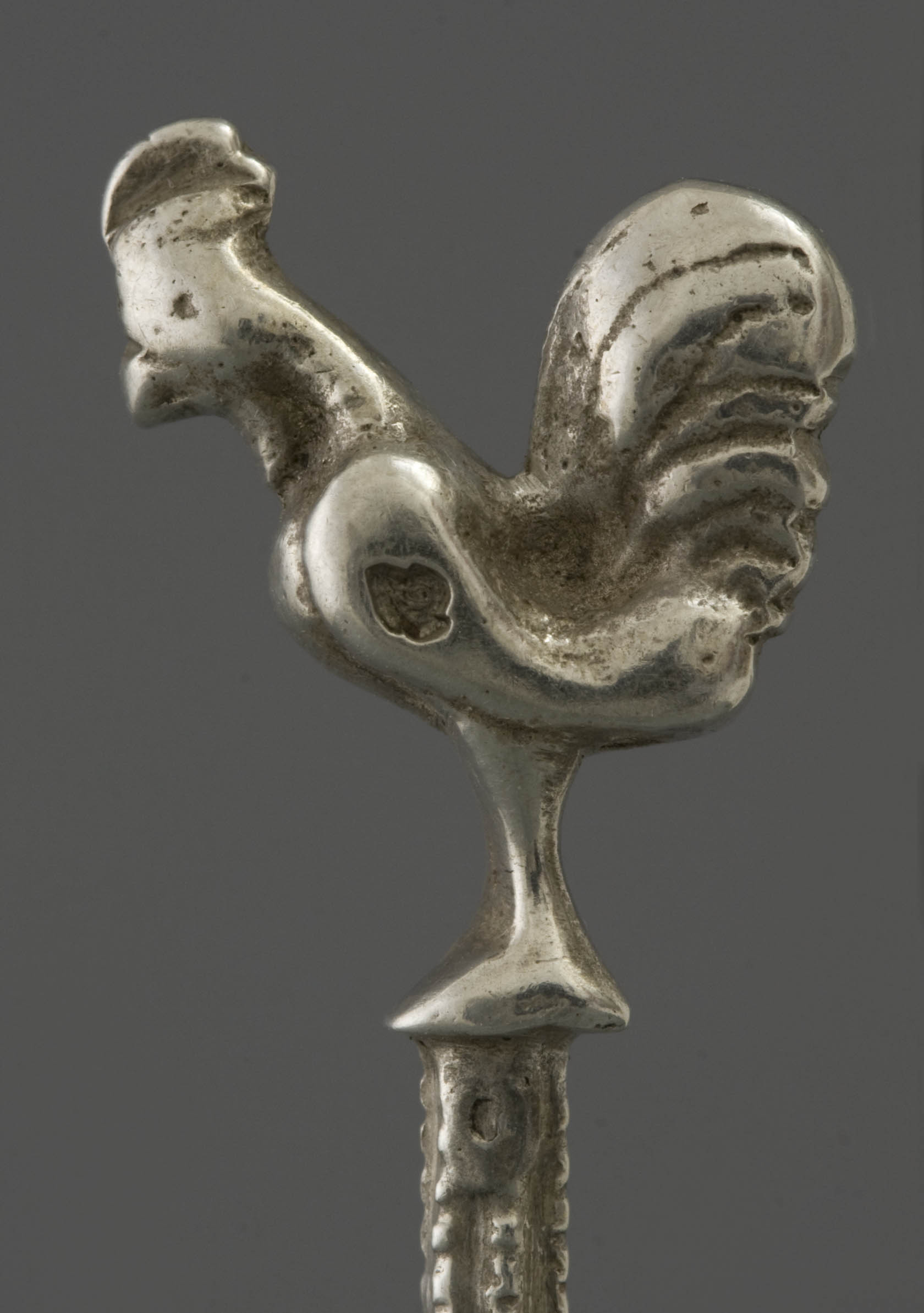

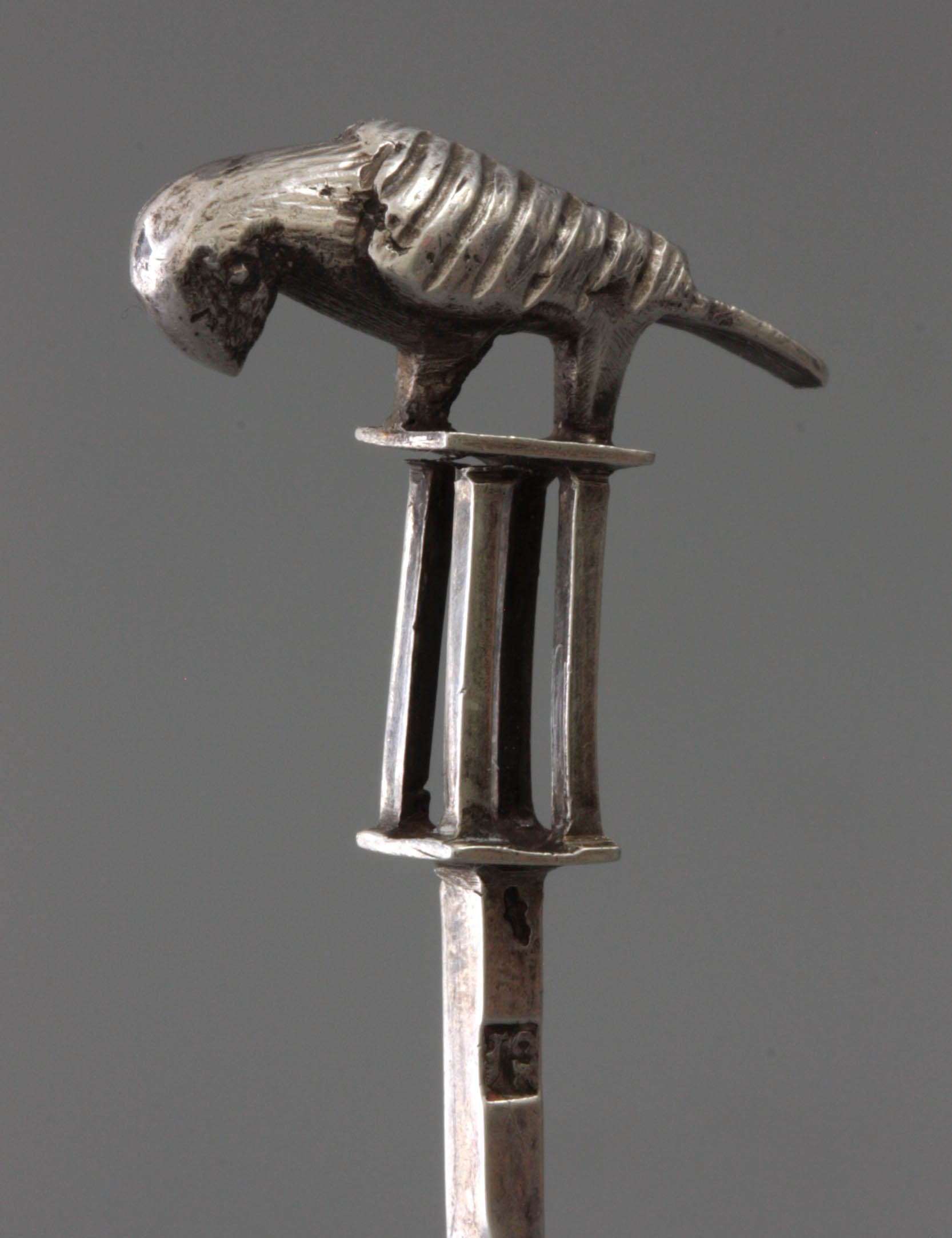
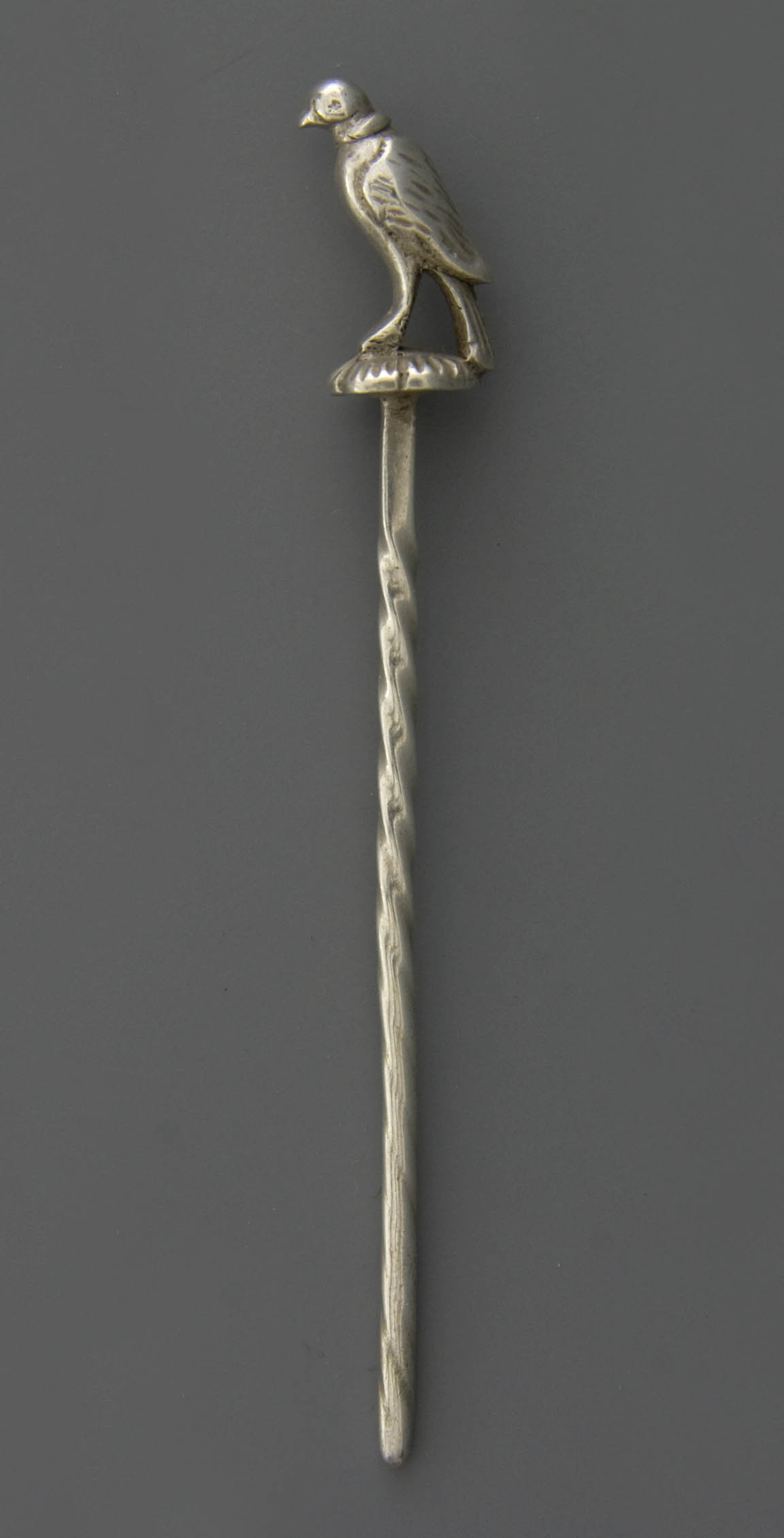
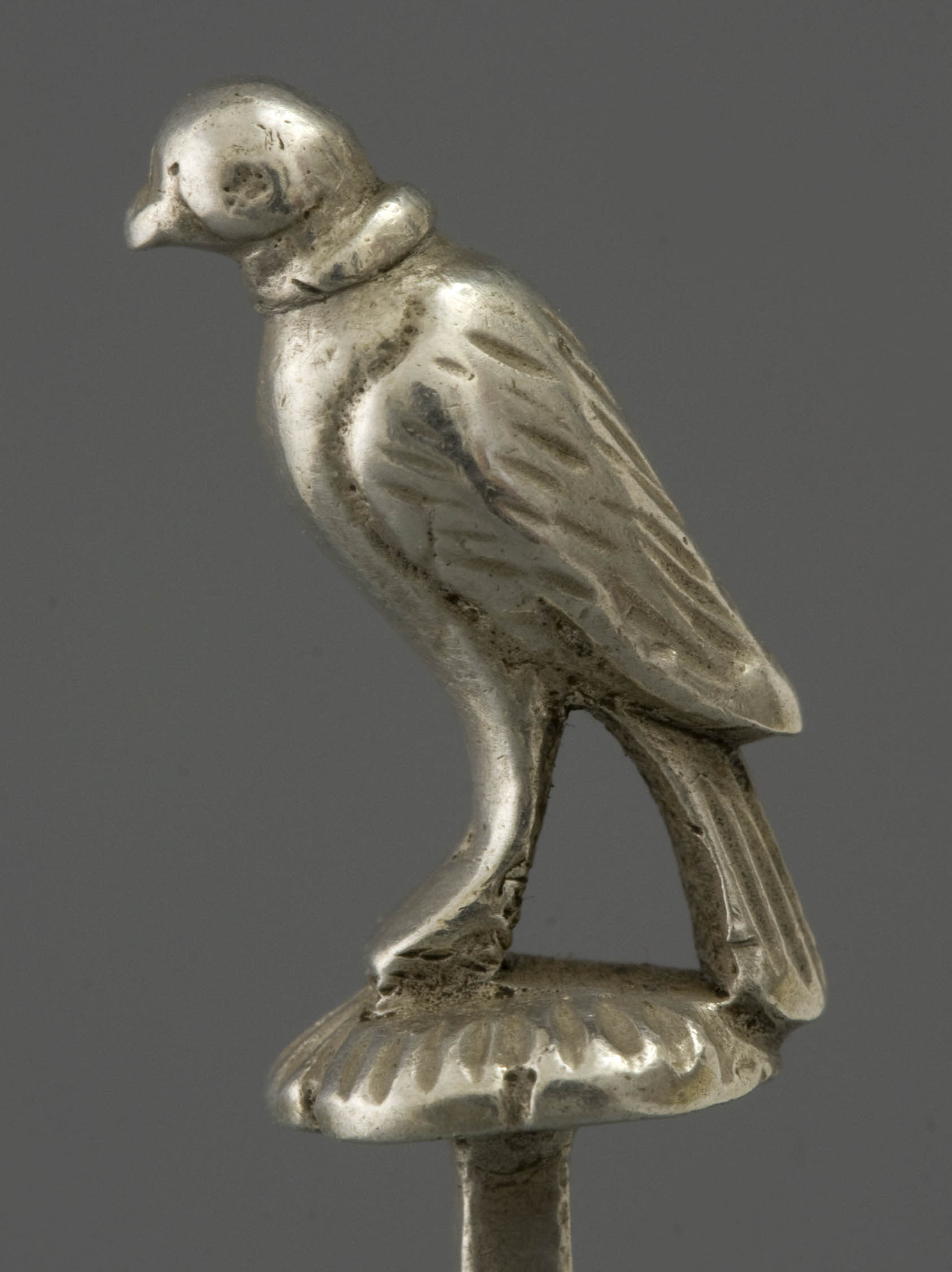

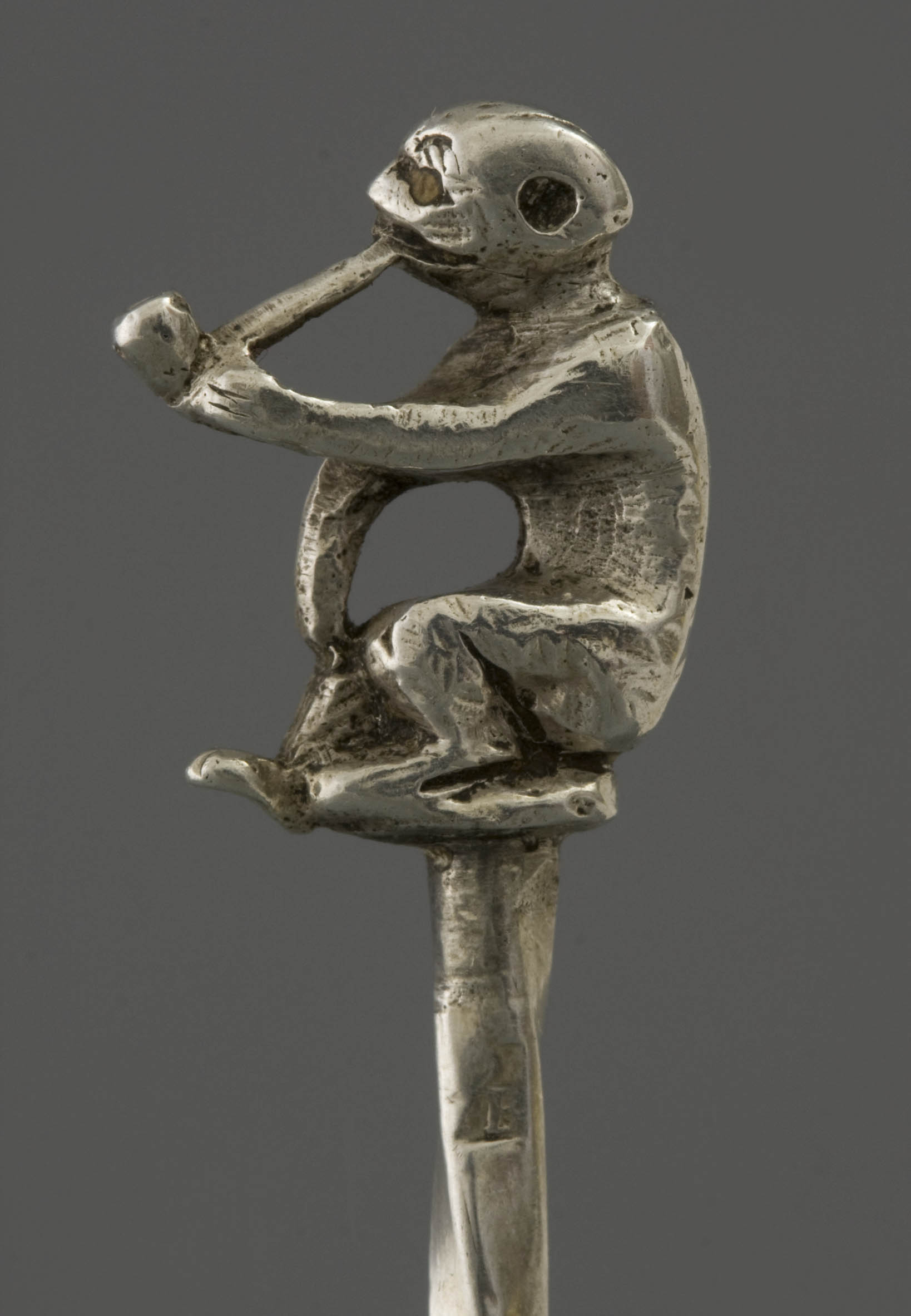

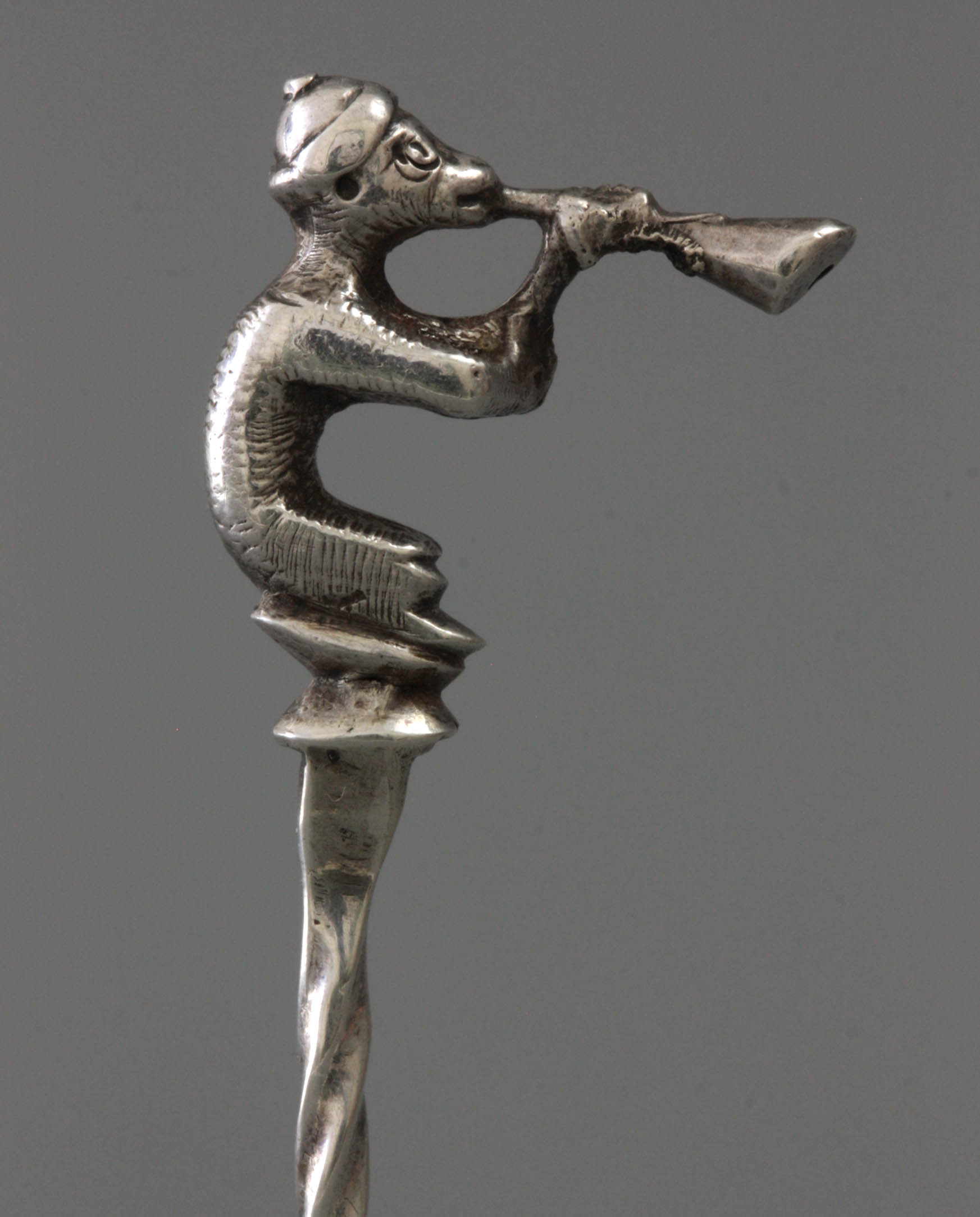
In addition, we see other animals such as recumbent (Fig. 11) and standing cows or bulls (Figs. 12-13), quadrupeds that are hard to identify (Figs. 14-16), but also the sitting dog (Fig. 17) or spitz (Figs. 18-19). There is also a standing rooster (Fig. 20) or a swimming swan. Birds also exist in variations, sketchy and undefined or a more specific species such as the parrot (Fig. 21) or the falcon (Fig. 22). Amusing is the monkey, often smoking (Fig. 23), another time with a trumpet (Fig. 24). Unexpected is a dolphin with an attractively curled tail (Fig. 25). The heraldic lion does not specifically belong to the animal kingdom, usually with a shield (Figs. 26-27), on which rarely a coat of arms is represented.
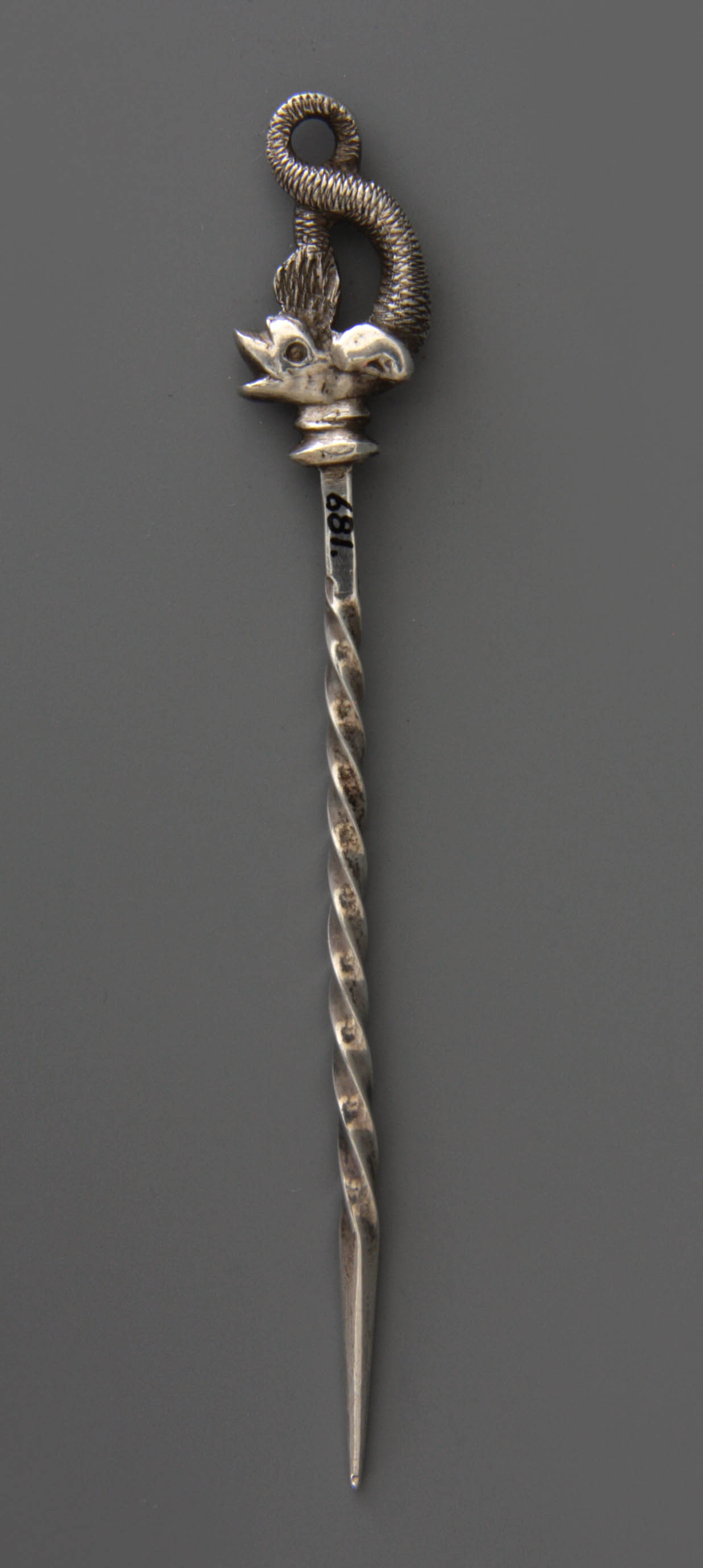
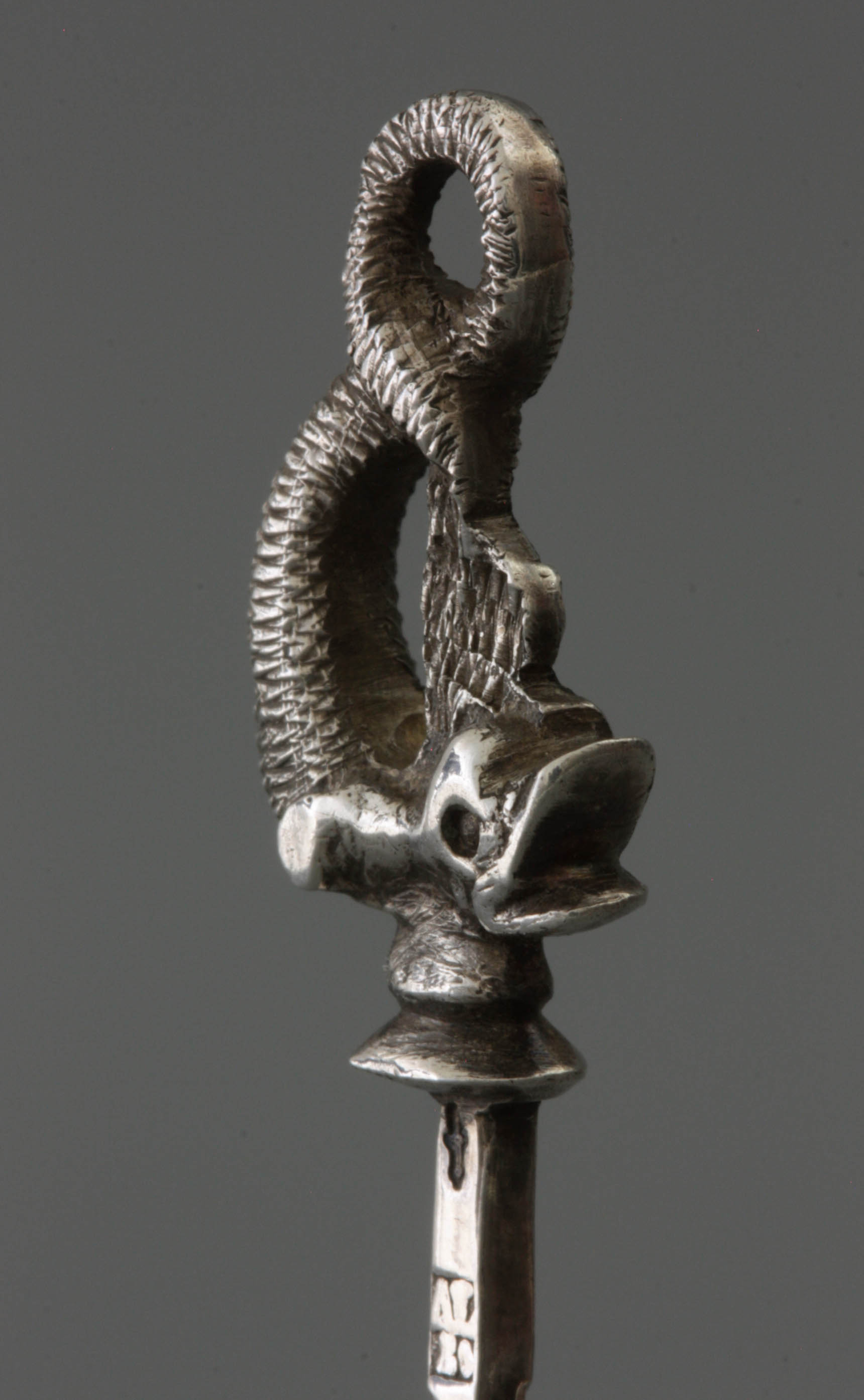
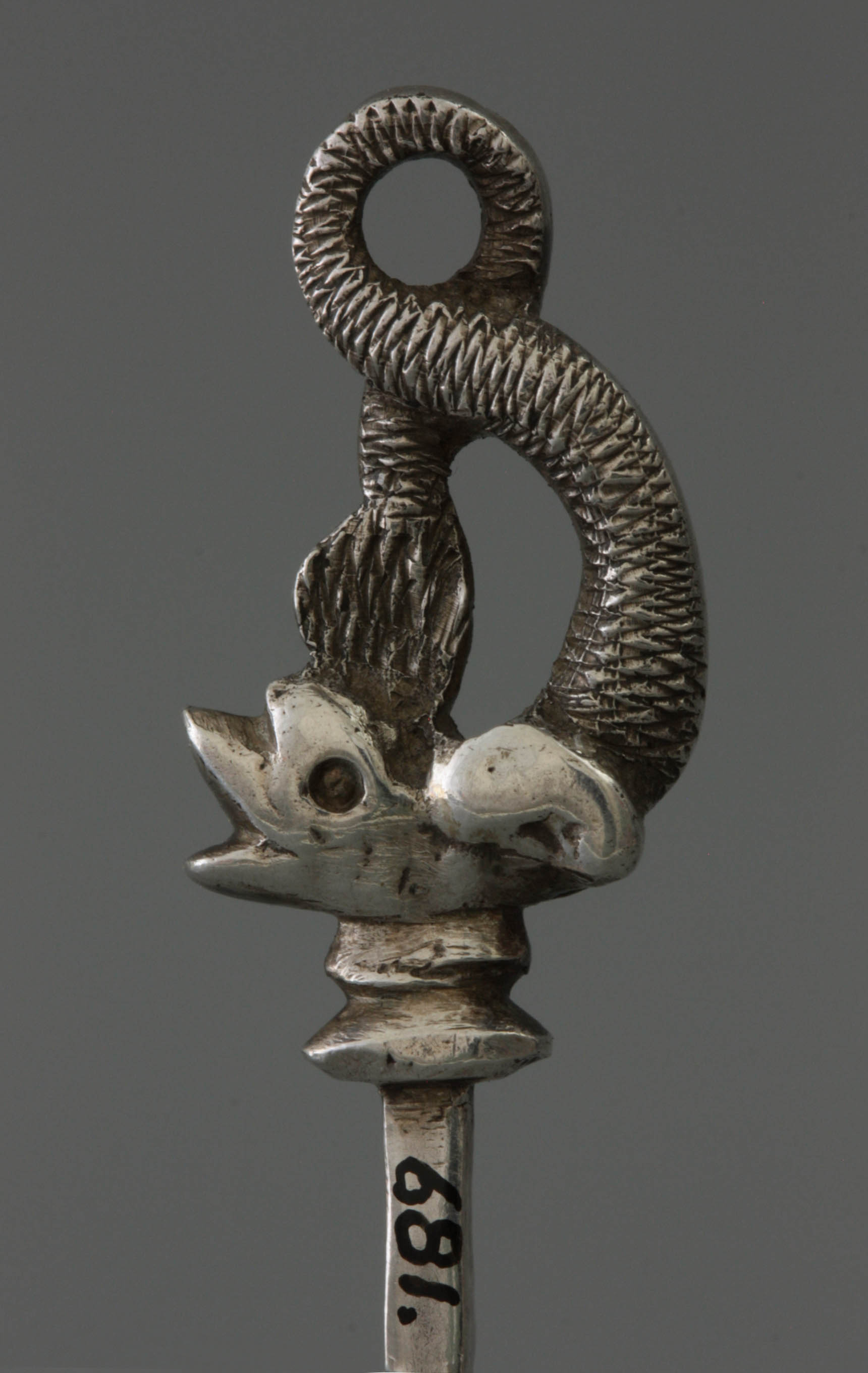
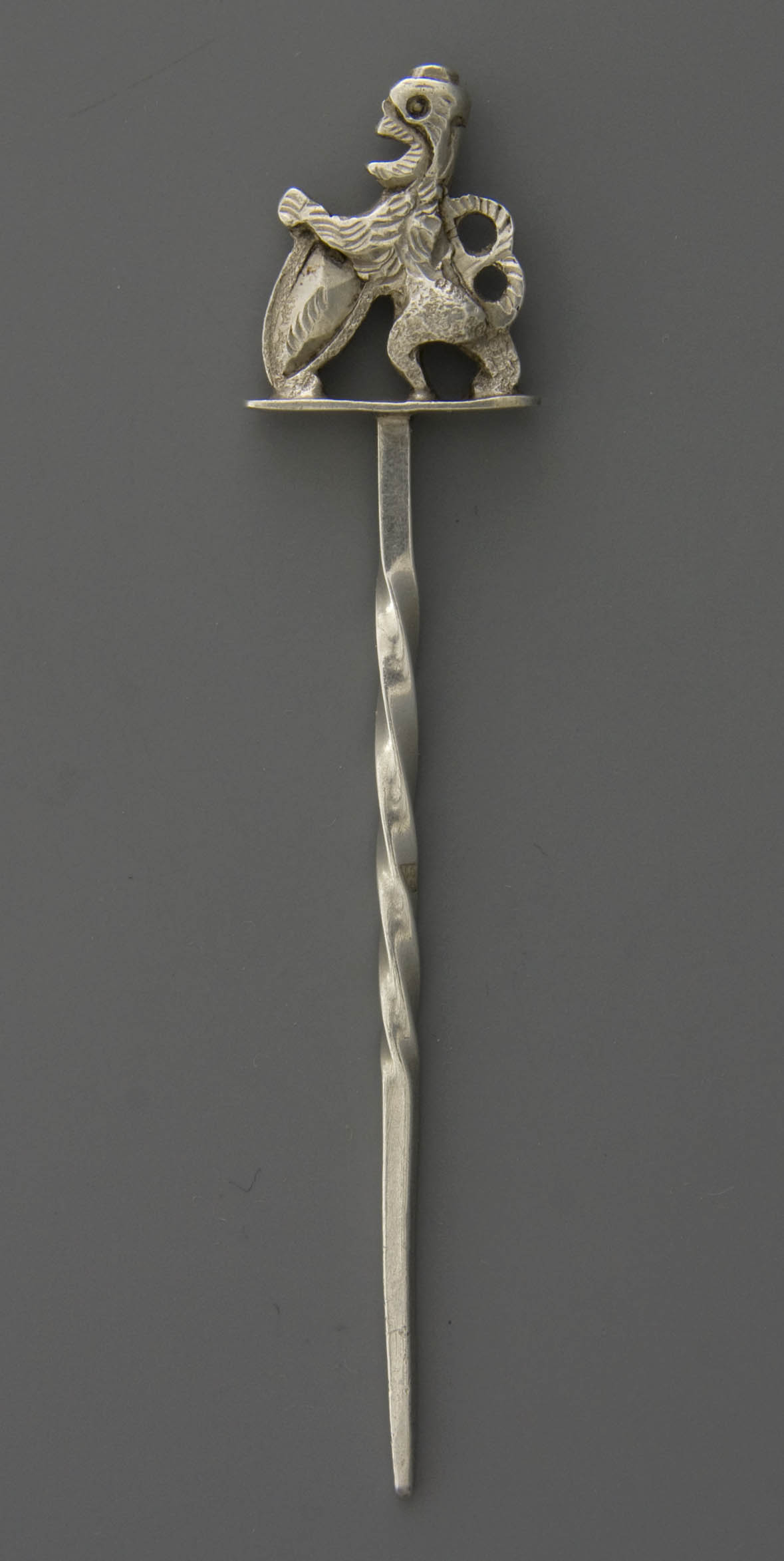
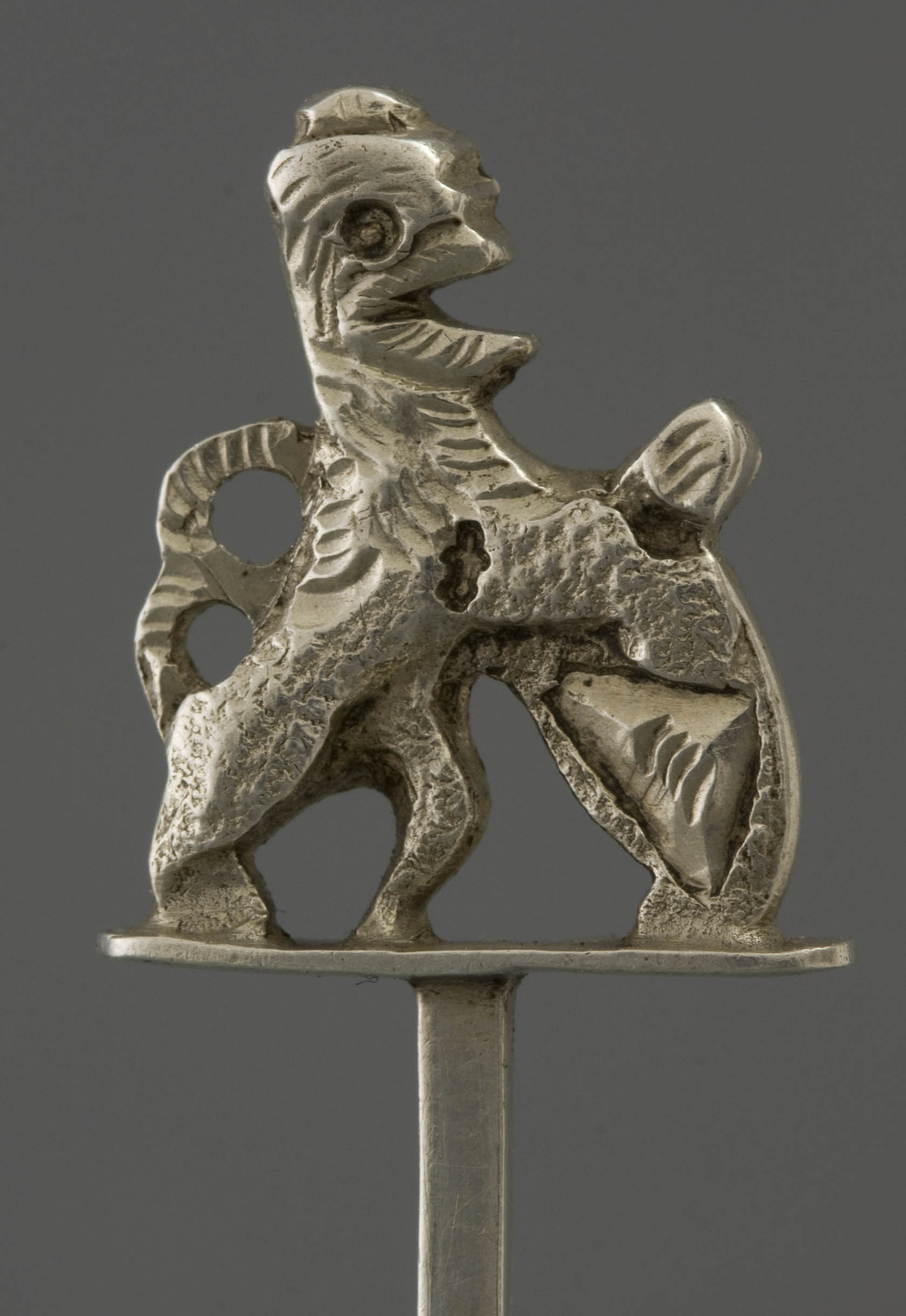

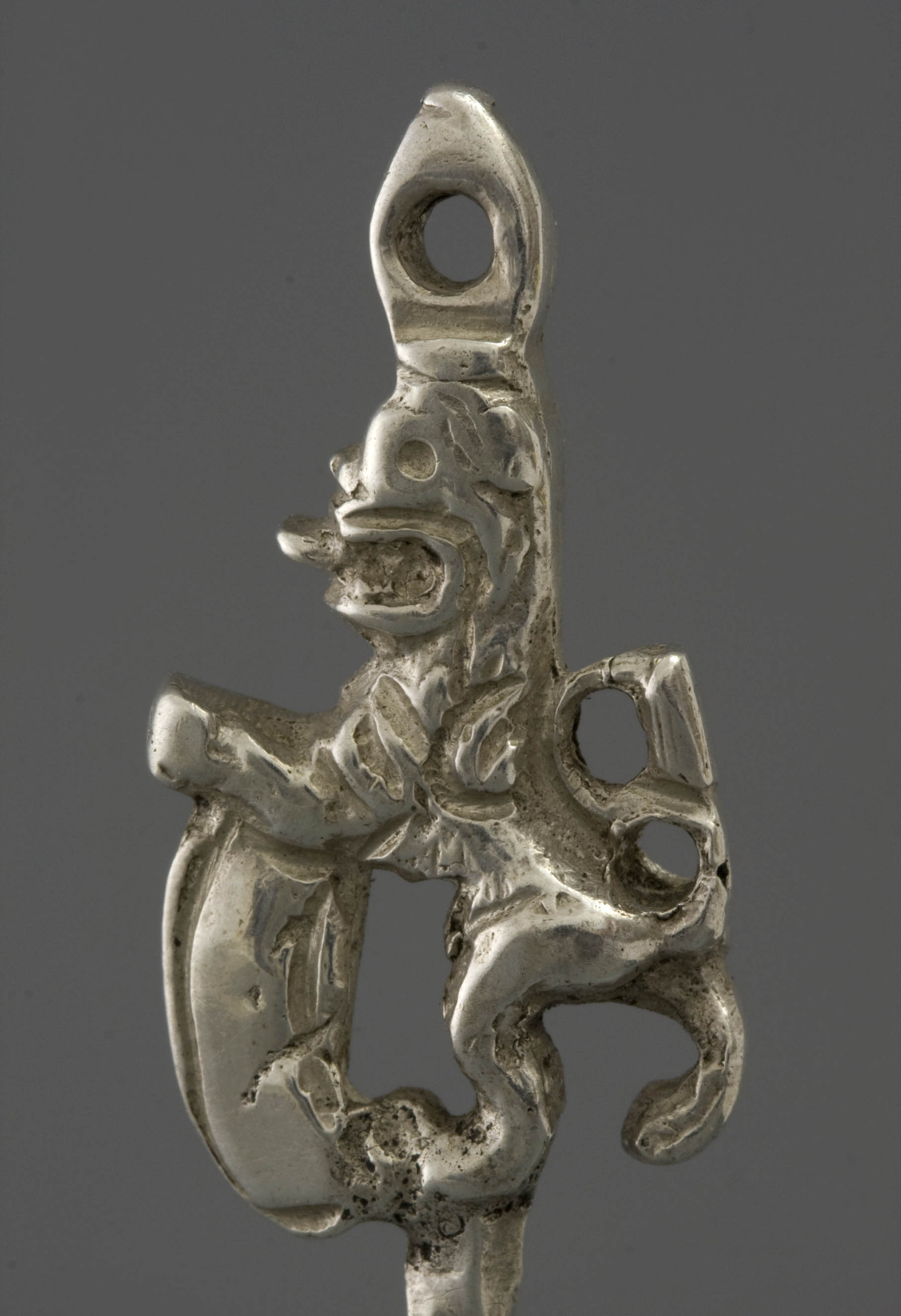
People are in second place as a pipe cleaners top. Those that represent a profession are most recognizable, such as the cooper (Fig. 28) or the shooter (Figs. 29-30). A standing male (Fig. 31), sometimes with a tobacco pipe (Fig. 32) or another attribute we cannot identify and may be called general illustrations. More specific representations are a figure with cornucopia (Fig. 33), a cupid or a harlequin (Fig. 34). Saints are known, such as Esaias with a saw (Fig. 35). Noteworthy is the representation of King William II (Fig. 36) and his fellow statesmen Frederick the Great (Fig. 37) and Napoleon (Fig. 38). These last three seem to have been made for the more politically interested smoker.
In addition to people and animals, professionally related items are carpenter's tools: a planer (Fig. 39) or a draft saw speaks for itself (Fig. 40). Almost ornamental is an anvil on a ball (Fig. 42). The most extensive is a cleaner with a blacksmith bench, anvil and bellows together (Fig. 41). Others are the bricklayer's trowel or sling hammer. A specific representation forms a stacked group of tools that evokes the association with freemasonry (Fig. 43). Other handles show more general things like a mule (Fig. 44), a clog or even a pair of clogs.
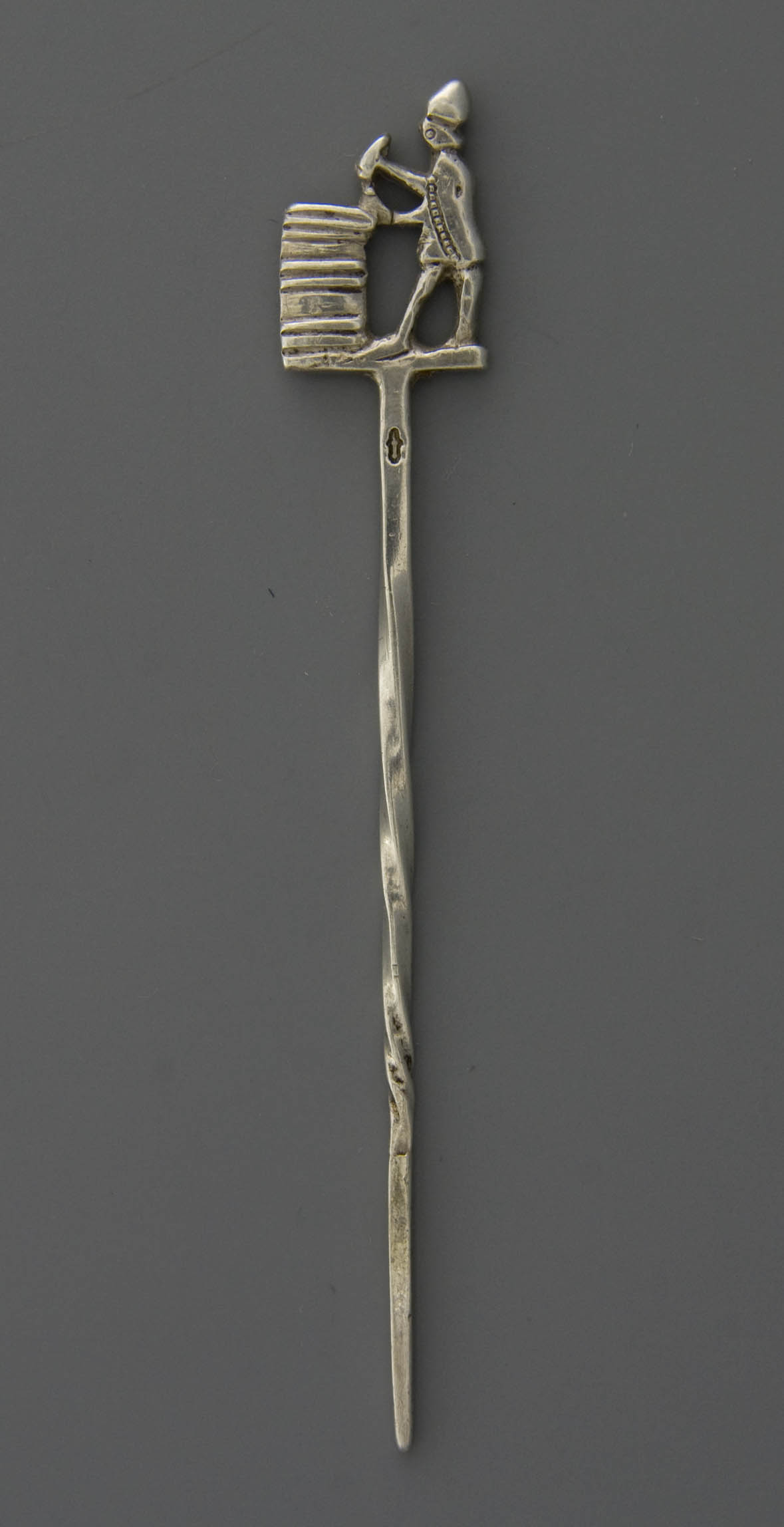
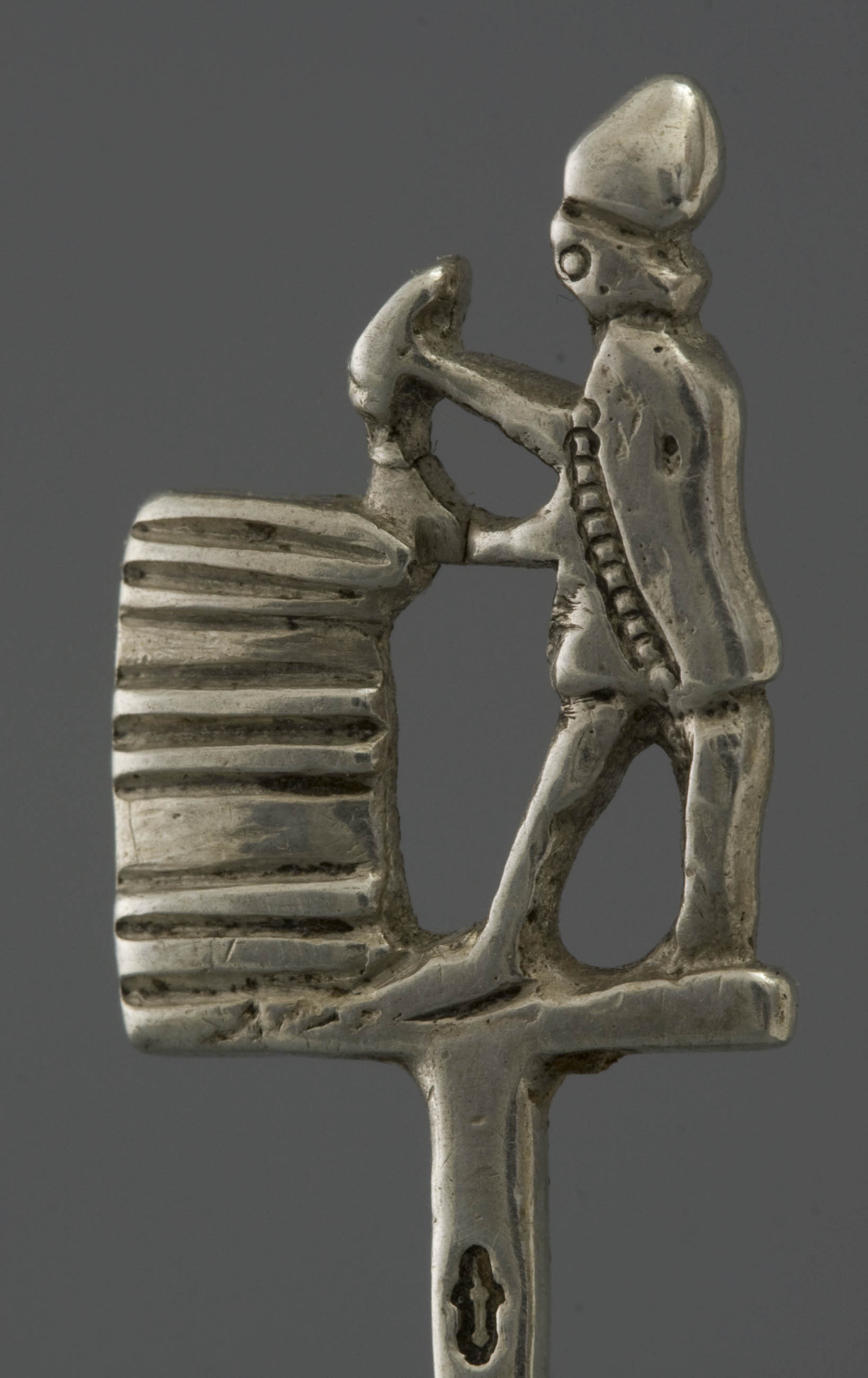
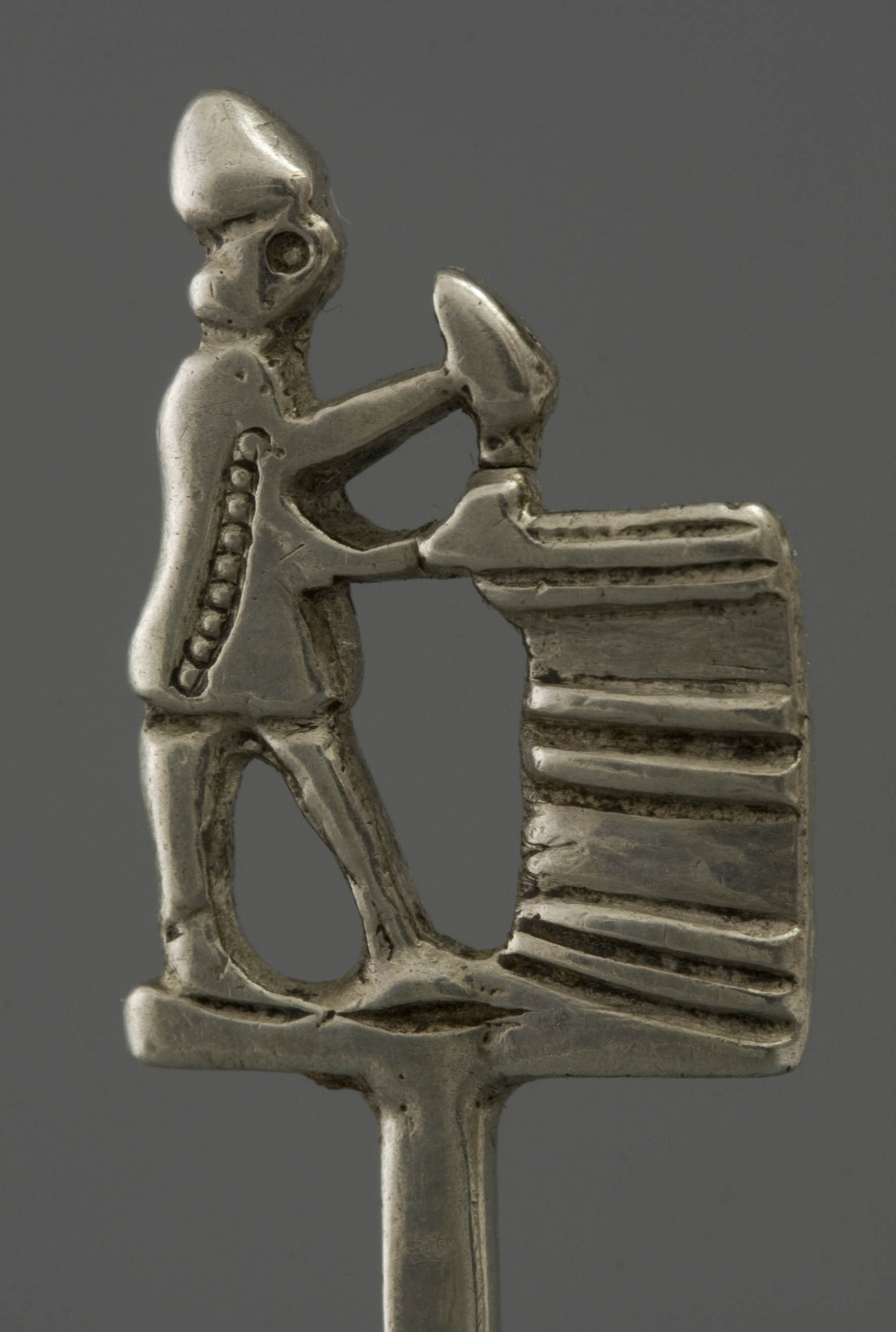
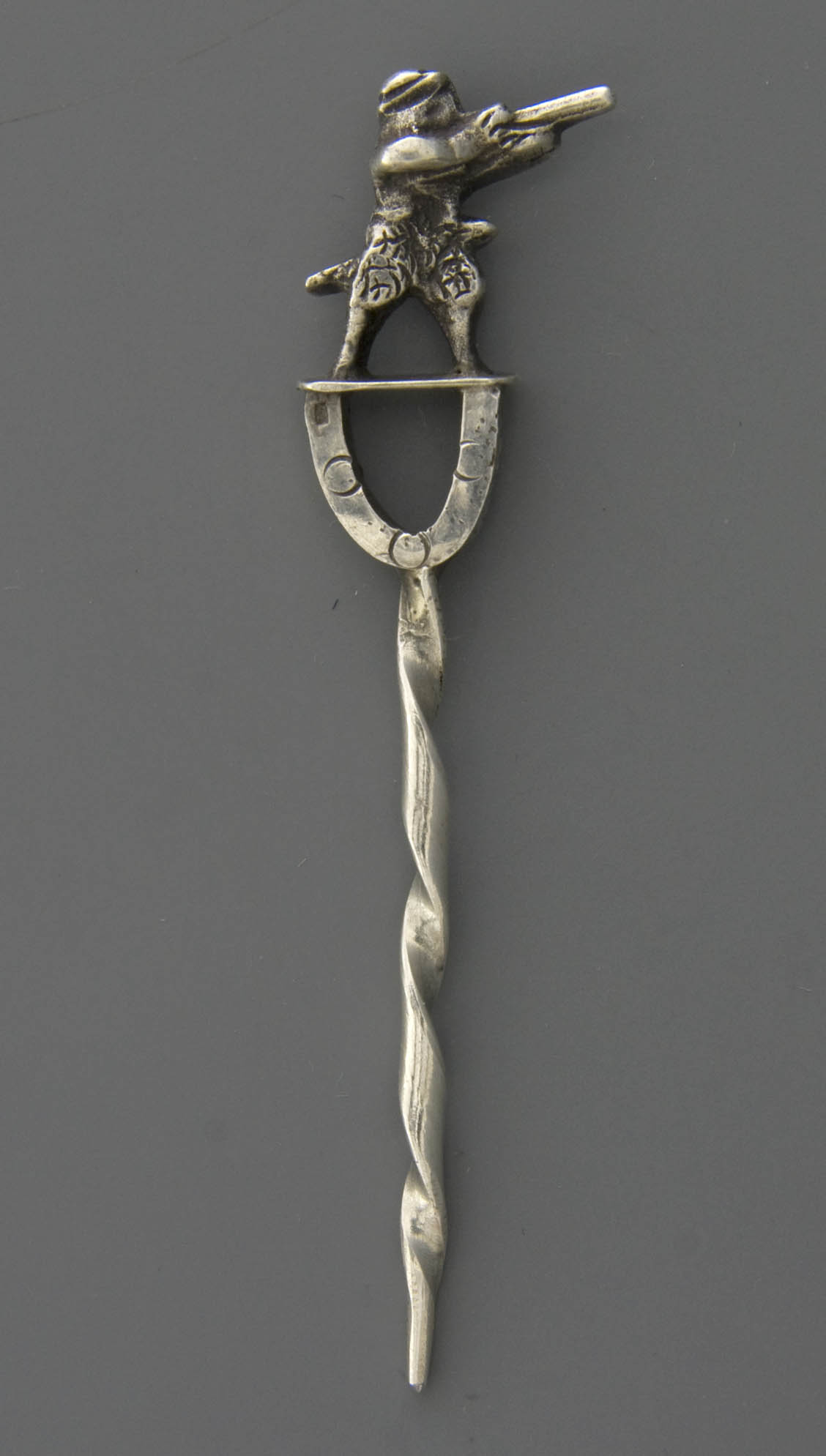
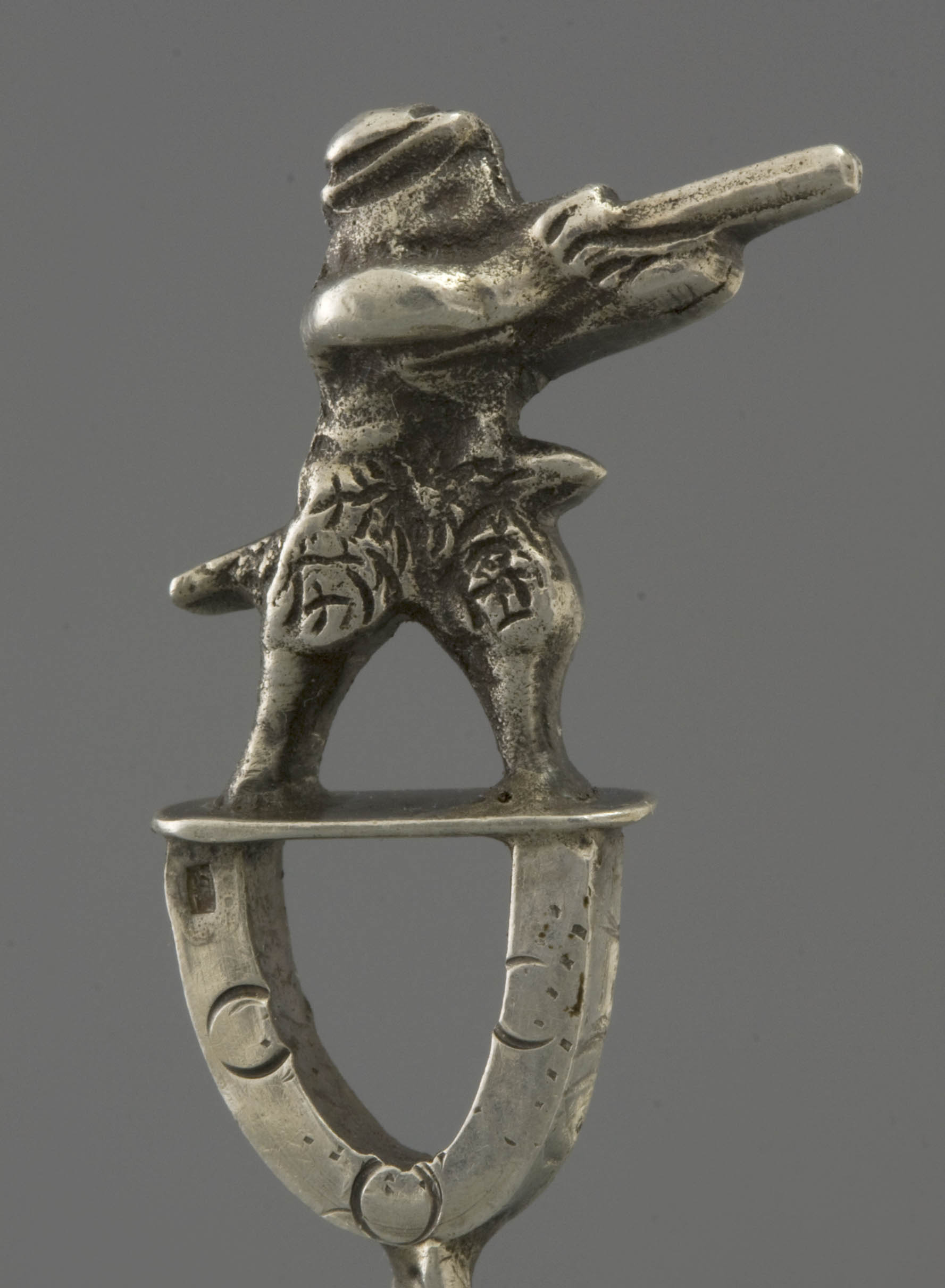
Common is the pipe cleaner crowned by a ship or three-master (Figs. 45-49) or a variant on it. Over time we see various meritorious specimen that emphasize the popularity of this topic over a long period. There is even a copy where the traditional sailing ship has been provided with paddles to look like a pedal steamer connecting with modern times (Fig. 49). Such tops can point to a specific clientele.

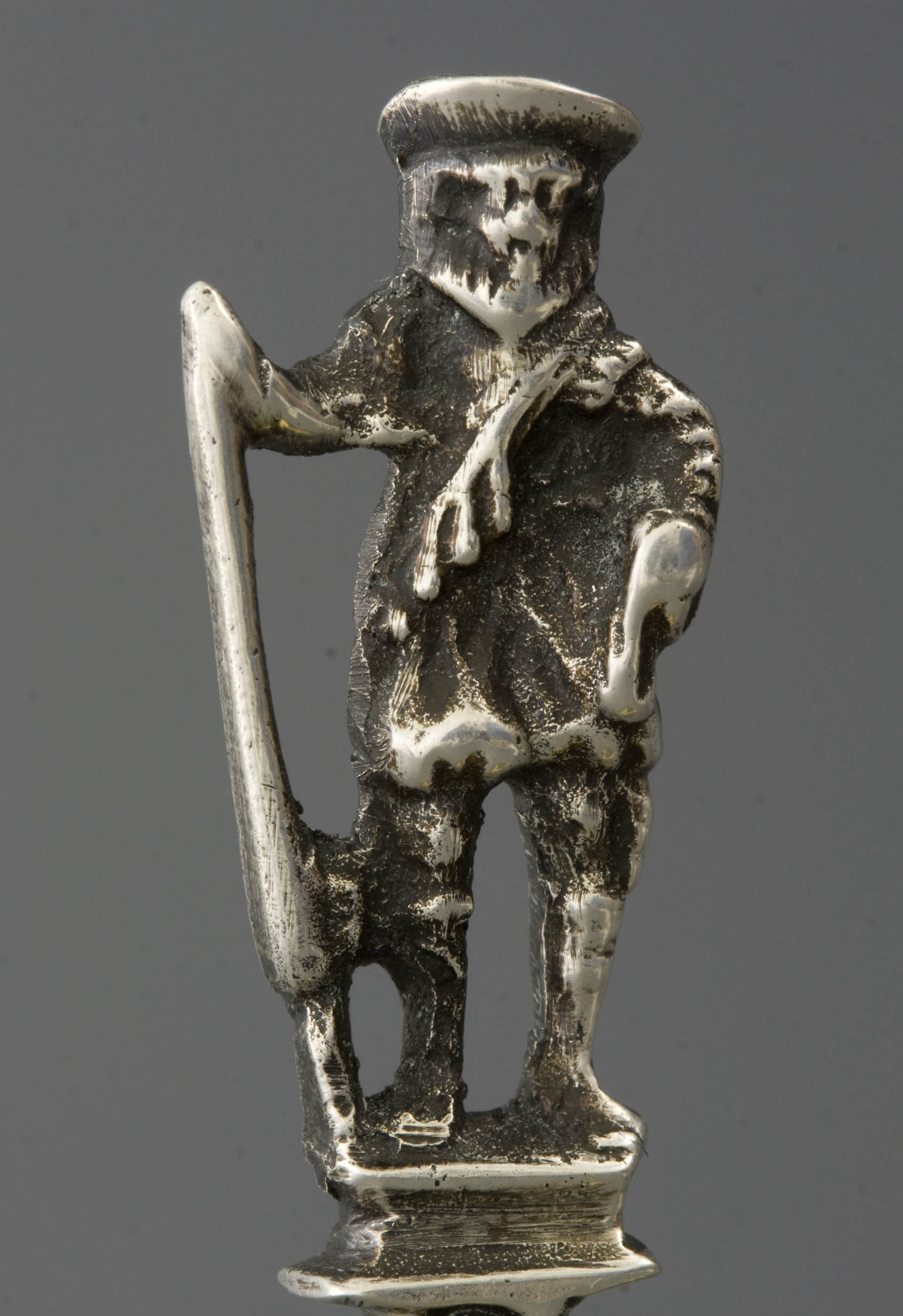
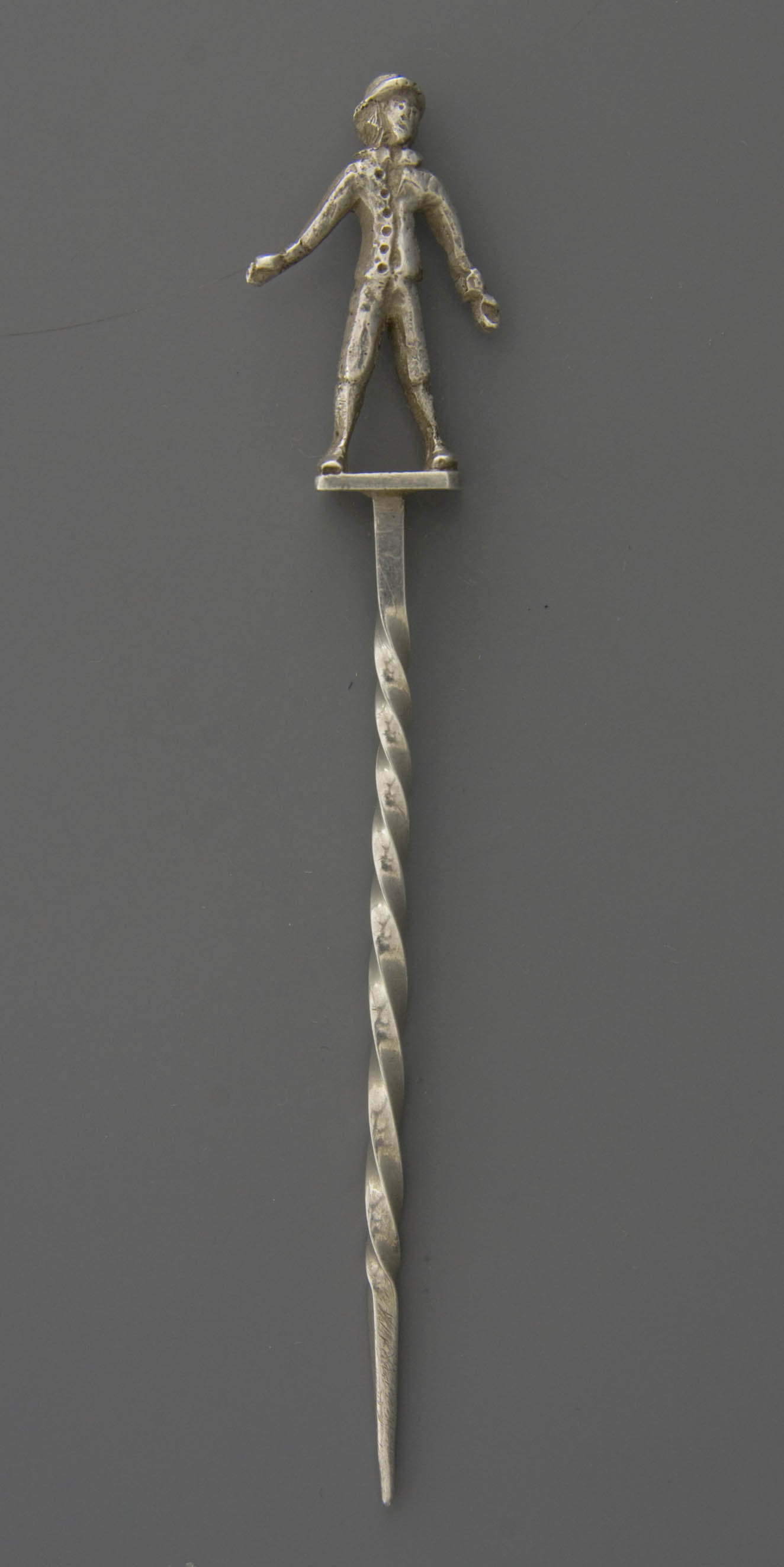
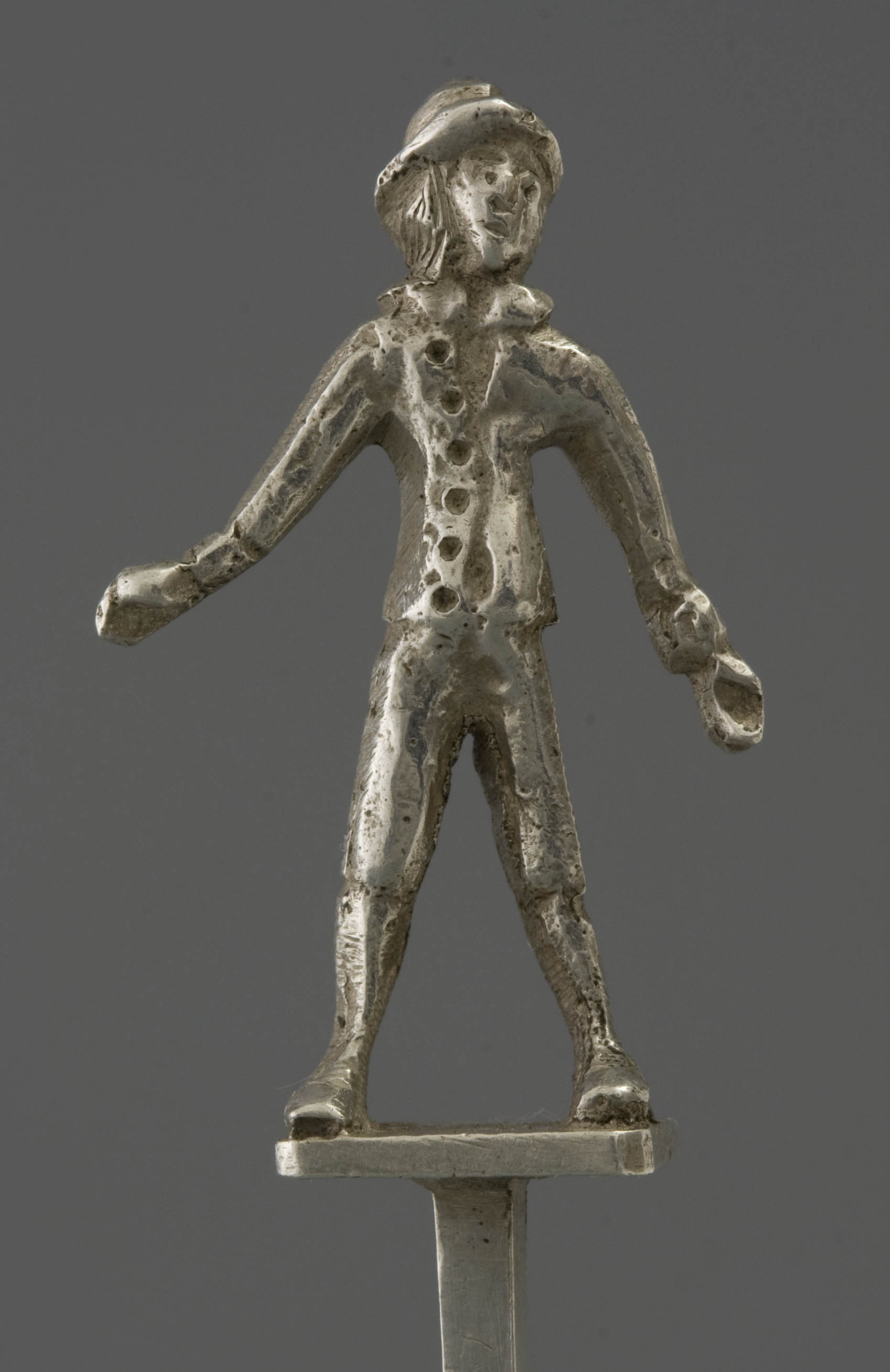
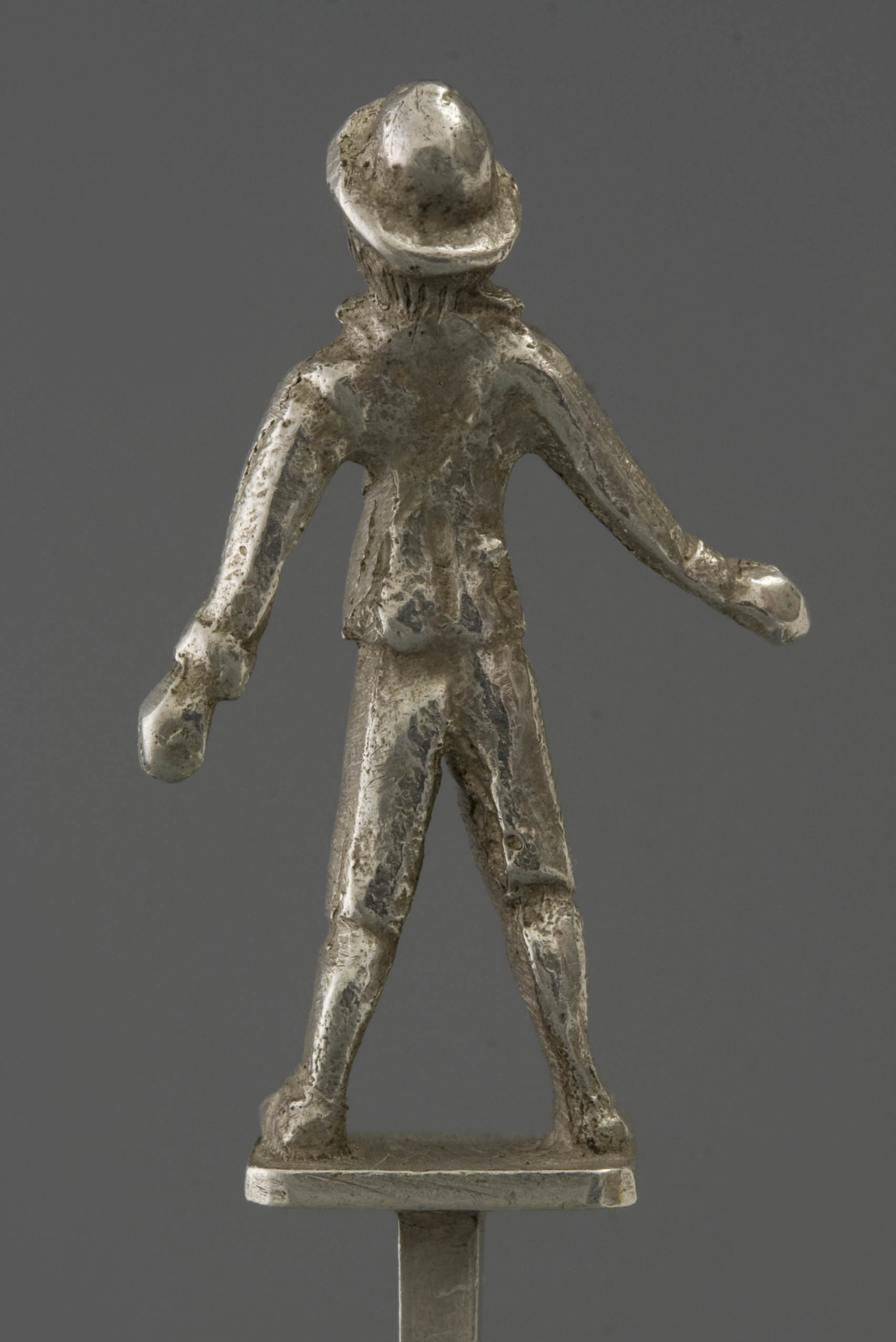
Finally, there is a remaining group with decorative ornament work, such as a neo-Louis XIV motif of stacked sheet metal (Fig. 50) or a bundle of ears of corn (Fig. 51). However varied the subjects may seem, all kinds of obvious representations do not occur. City arms and provincial arms but also portraits are not or only rarely made. Birth-spoons have the same kind of decorated tops, but exactly the same ornaments rarely occur on pipe cleaners. The mill only comes into being in the twentieth century when the silver pipe cleaner changes from traditional tool to more souvenir-article. In the style of Dutch folklore we would also expect the Volendam fisherman and the milkmaid, which doesn’t exist. Only in the 1950s, such traditional Dutch depictions were sold as snacks prickets and no longer as a pipe tool.
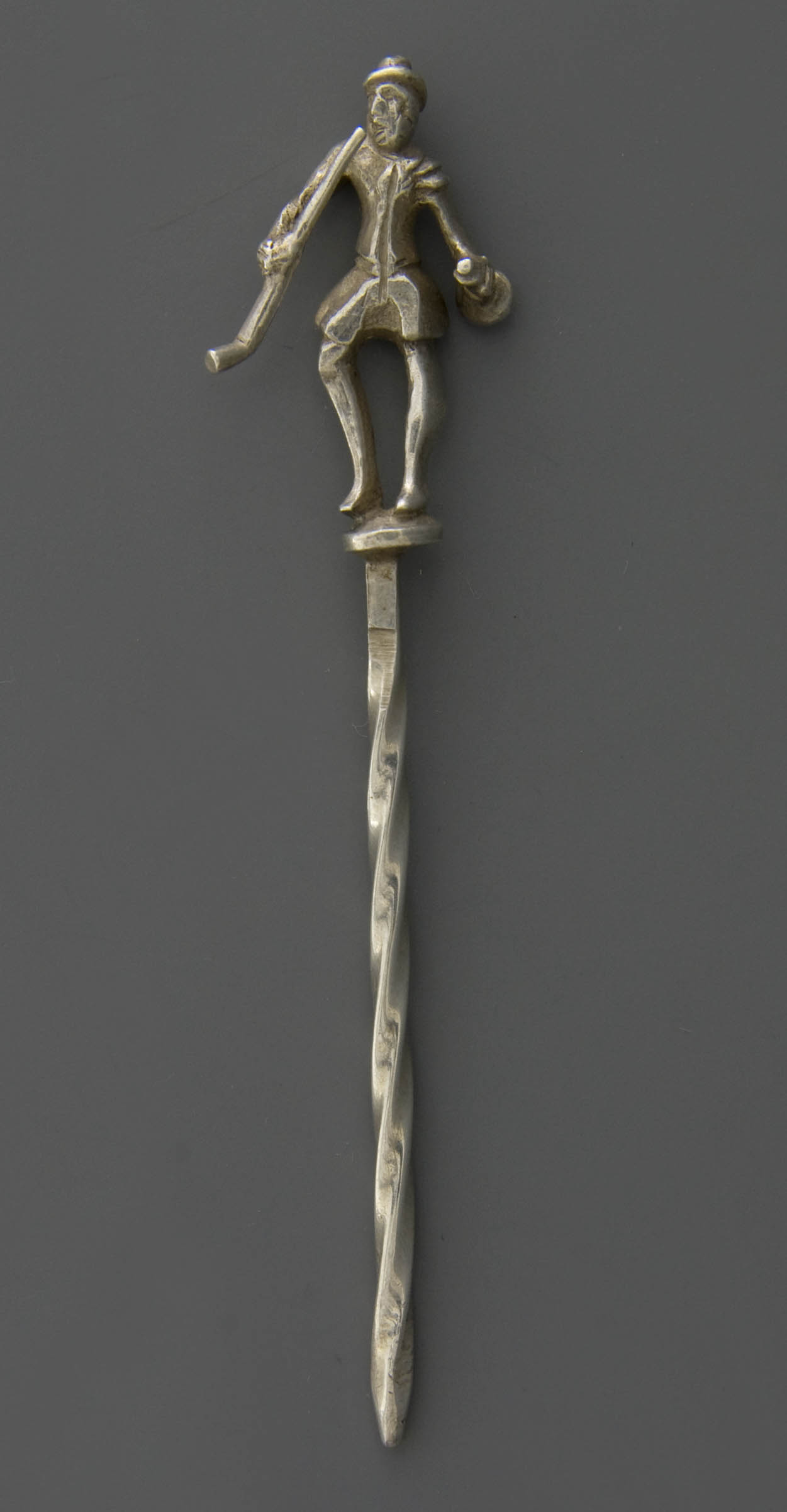
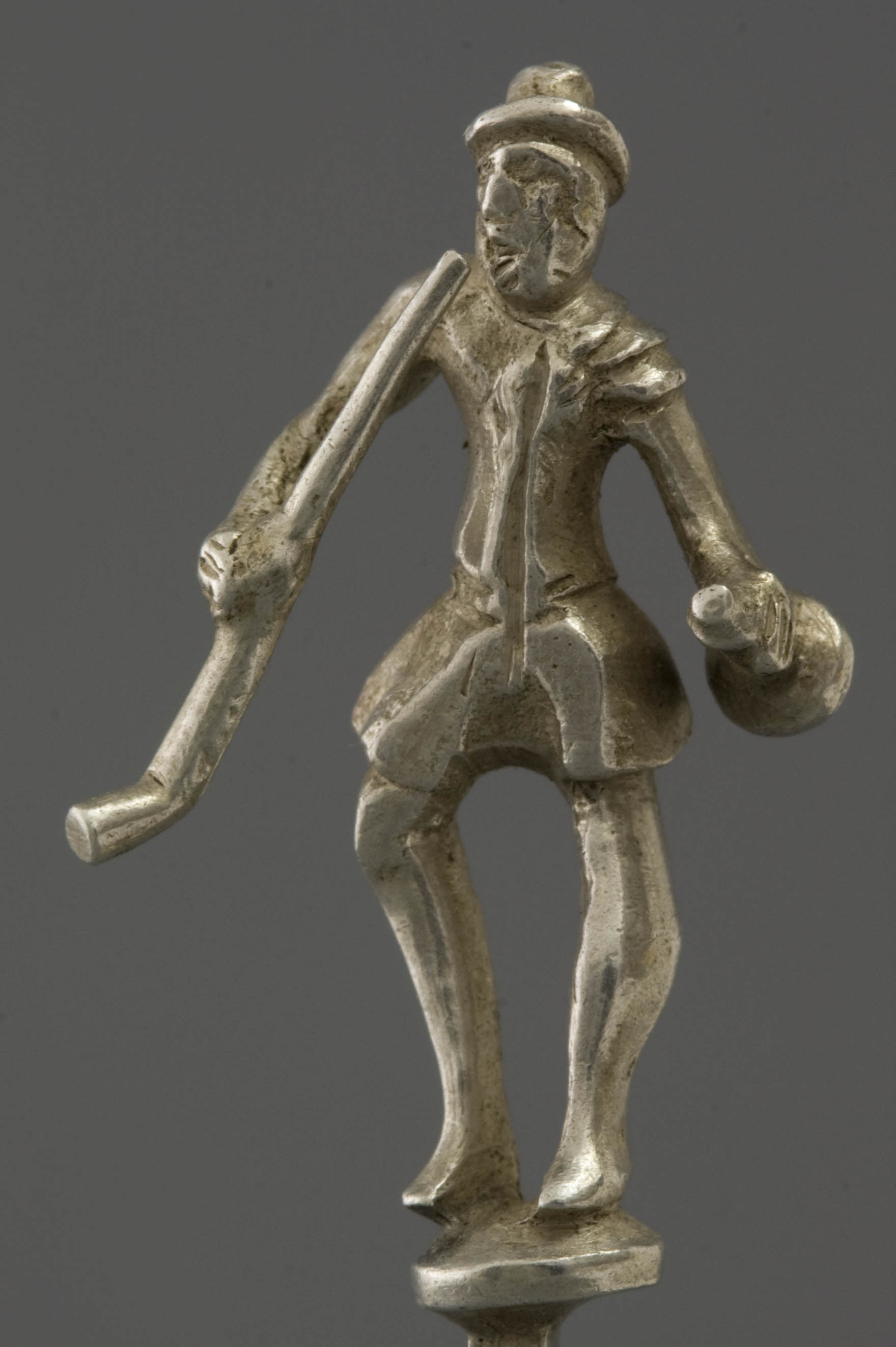
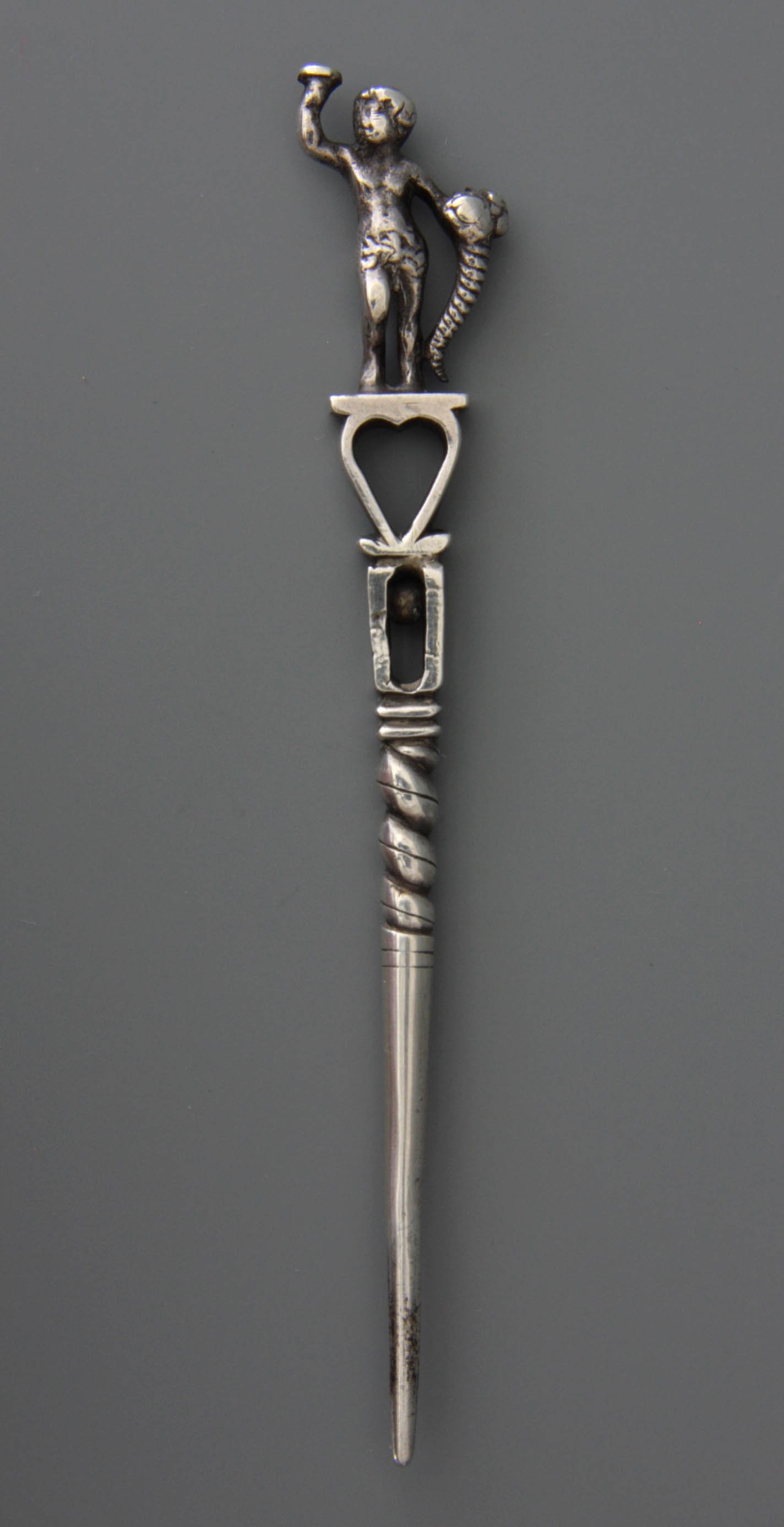

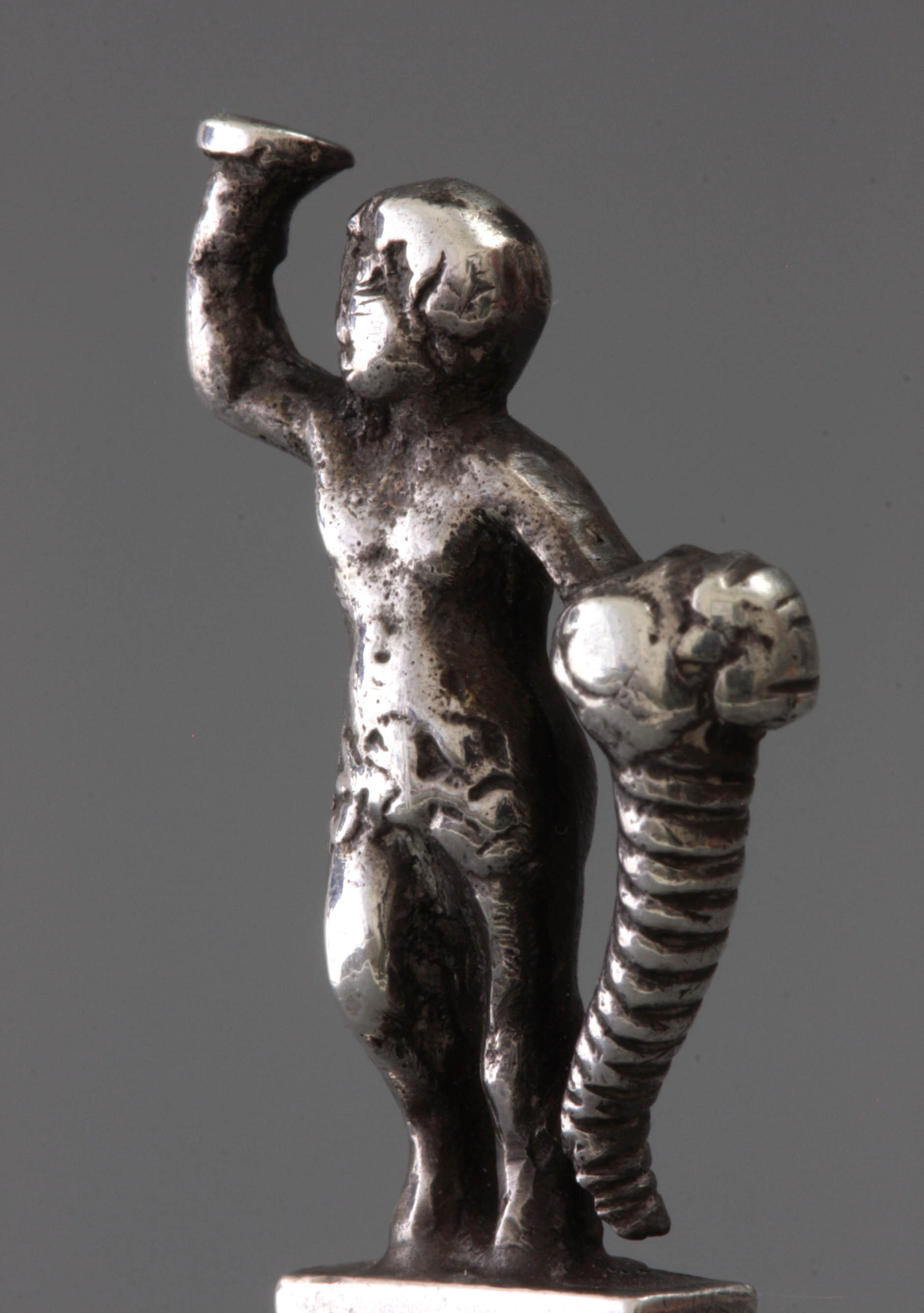
All in all, the pipe cleaner is a traditional artefact in which, especially since 1880, much has been repeated. By no means it is always imitation, often it is about keeping the tradition alive. For example, many spitz dogs, the nickname for the Patriots, were made throughout the nineteenth century as a symbol of the political quarrels a century earlier. The more developed smoker will have referred to this history when he shows his pipe cleaner. In our time, among collectors these examples are often easily dated much older, despite their later time of manufacture. Doing so, their prestige and thus also the value for the collector increases.
Cleaners more closely examined
In general, pipe cleaners show limited originality. They are an ordinary serial manufactured, though handmade product for a specific, rather simple bourgeois target group. The user was generally part of the lower middle class for whom such a small silver object as a great luxury. The upper class could afford a decent piece of silver and were hardly interested in a curiosity like a silver pipe cleaner. Unsurprisingly, the largest popularity of the pipe cleaner coincides with the fashion of the cigar, which was mainly esteemed in the higher class. The ordinary smoker remained loyal to the tobacco pipe and by consequence continued the use of the cleaner. Over all, a tradition established itself that reveals all sorts of unexpected things if looked at in detail. In this section some more special aspects will be discussed.
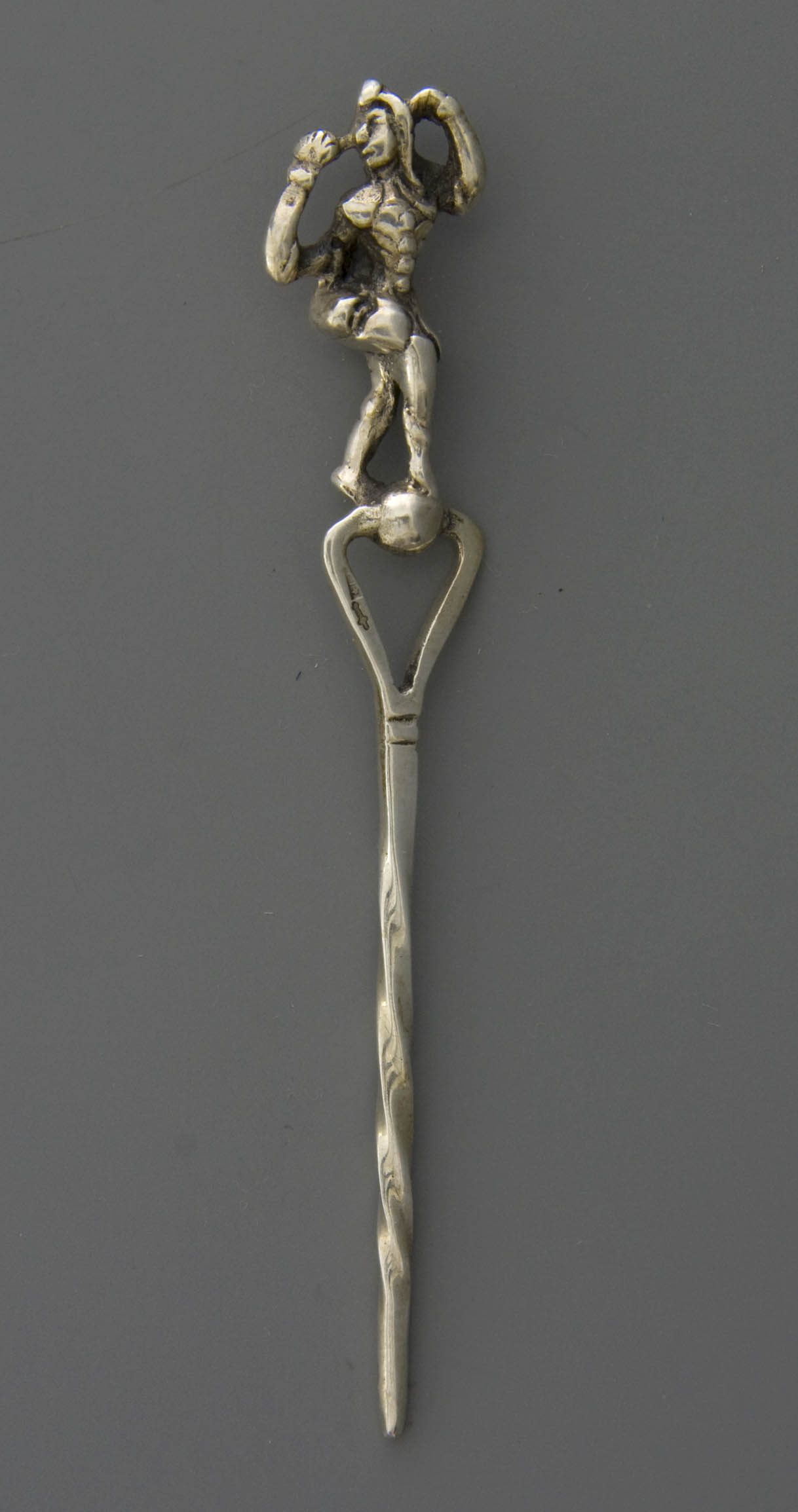
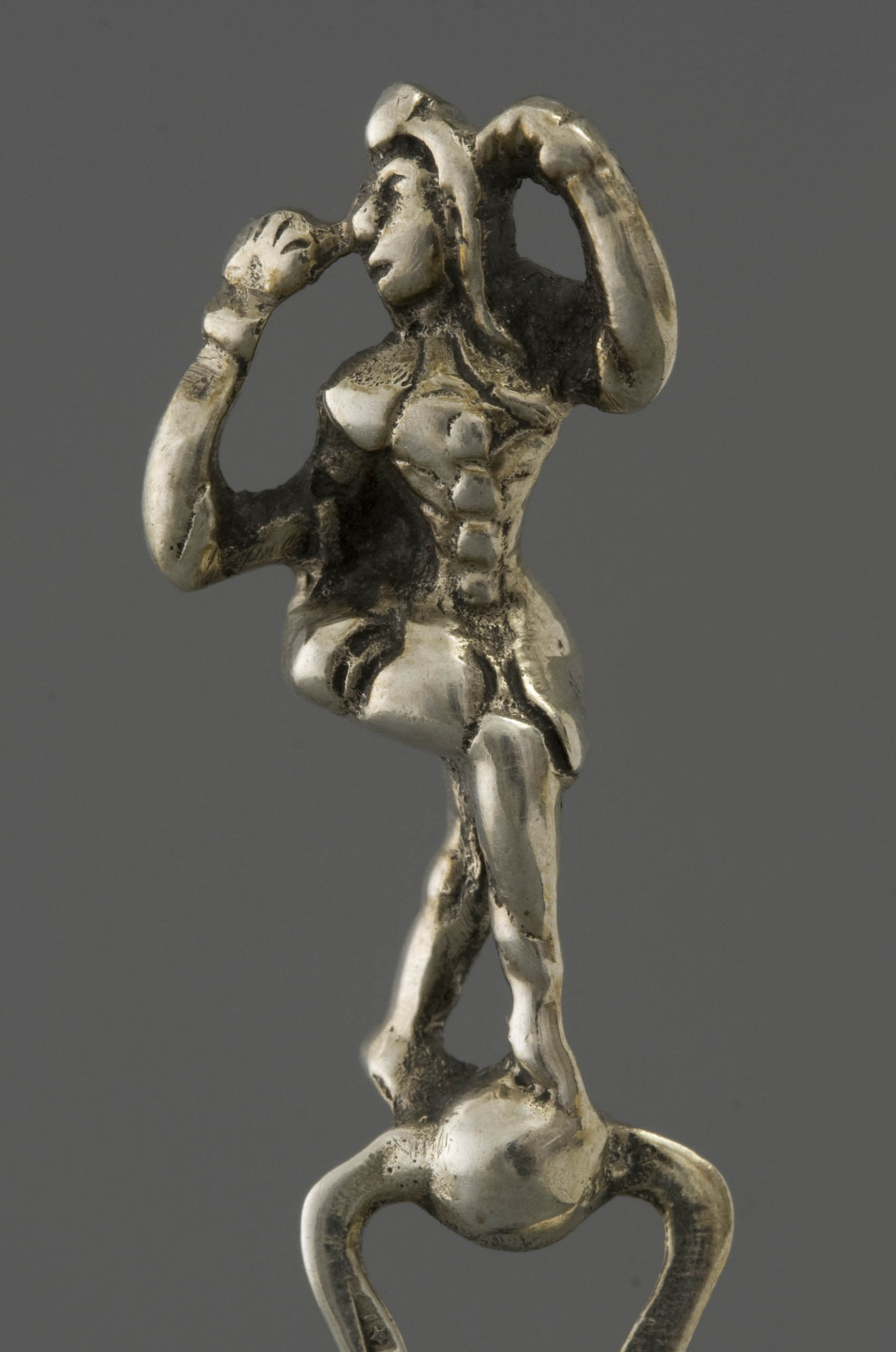
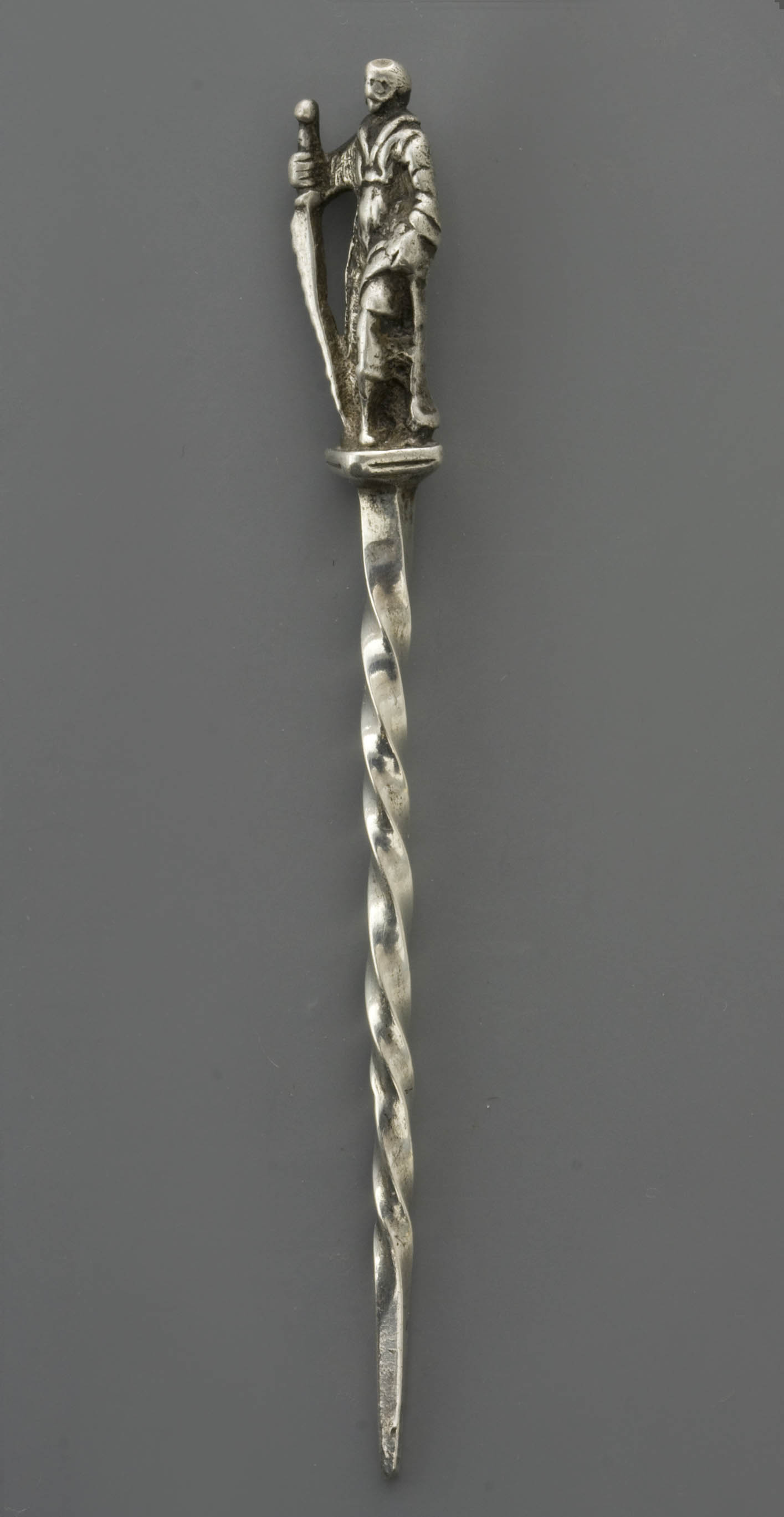

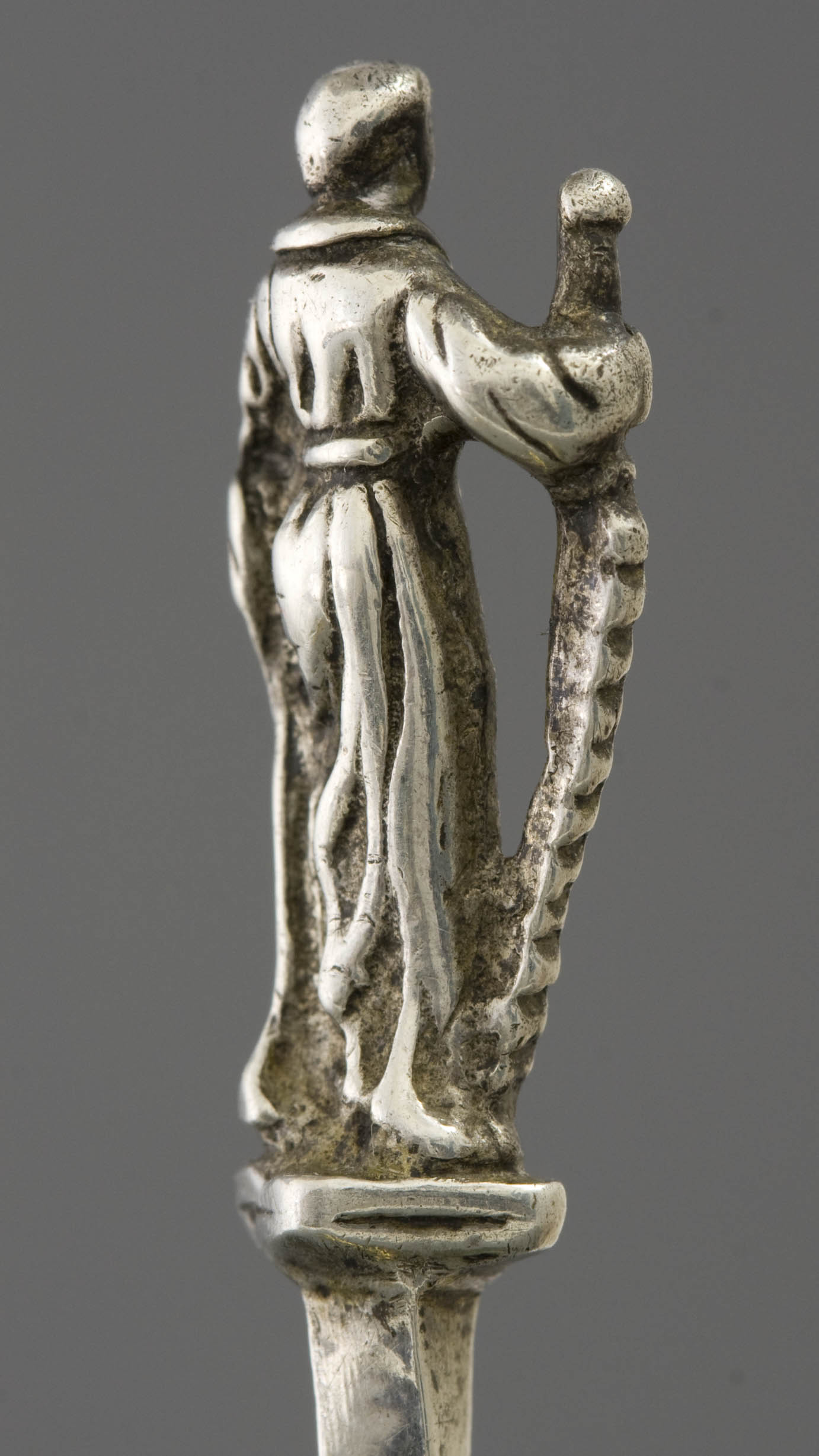
A most serene, well-affected representation of a standing cooper that strikes a barrel is the simplicity itself (Fig. 28). After sawing the full image of the top, the staves were filed in the barrel and the row of buttons was punched in the jacket. Altogether a very easy way of working. This cleaner is strongly two-dimensional, but nevertheless giving a very striking image. Even the twisted stem is modest. This sleek, simplified version looks like eighteenth century, but that is not the case, given the silver hall mark. We can imagine how the tradition of silver pipe cleaners started with such specimens.

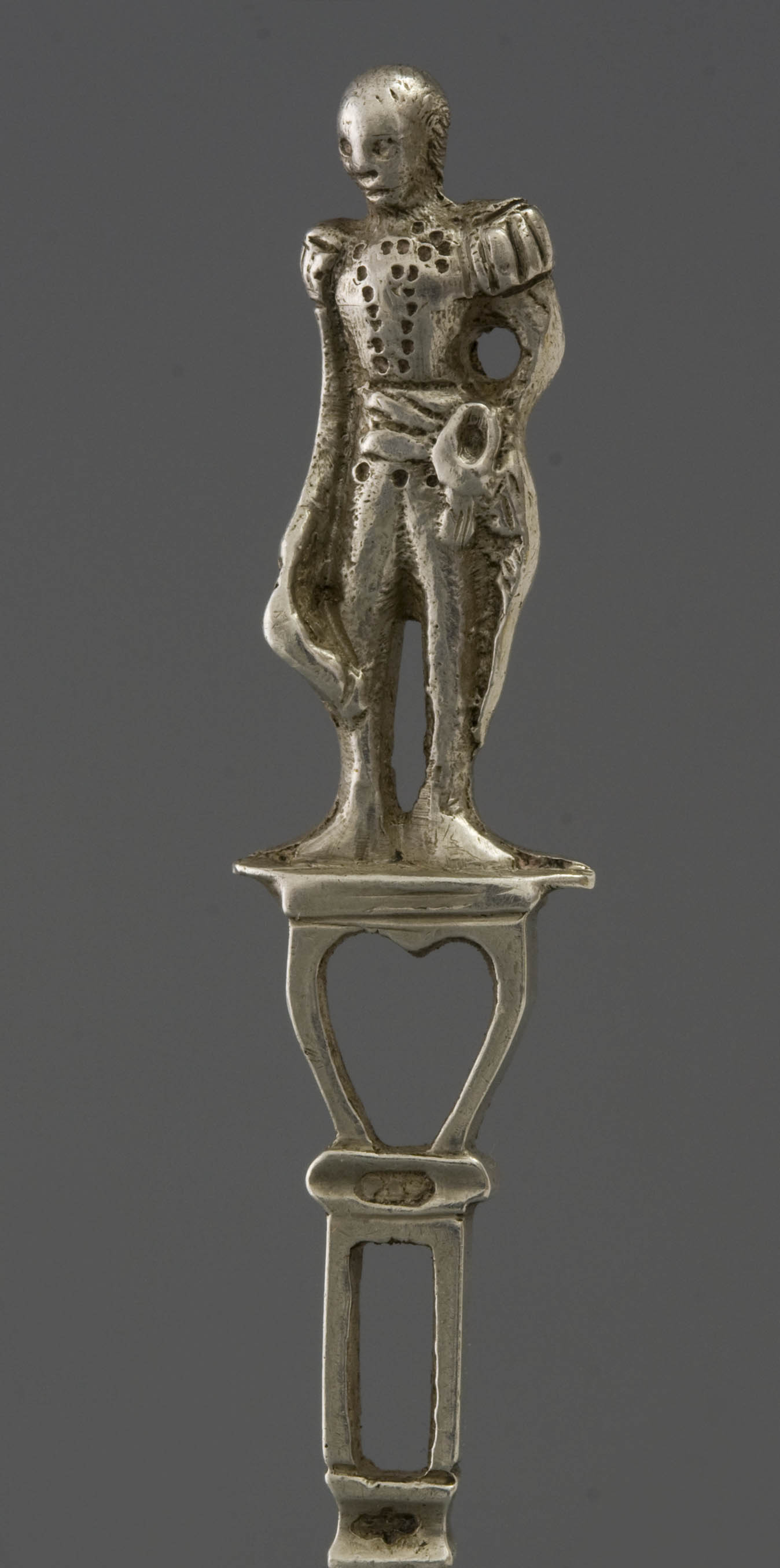
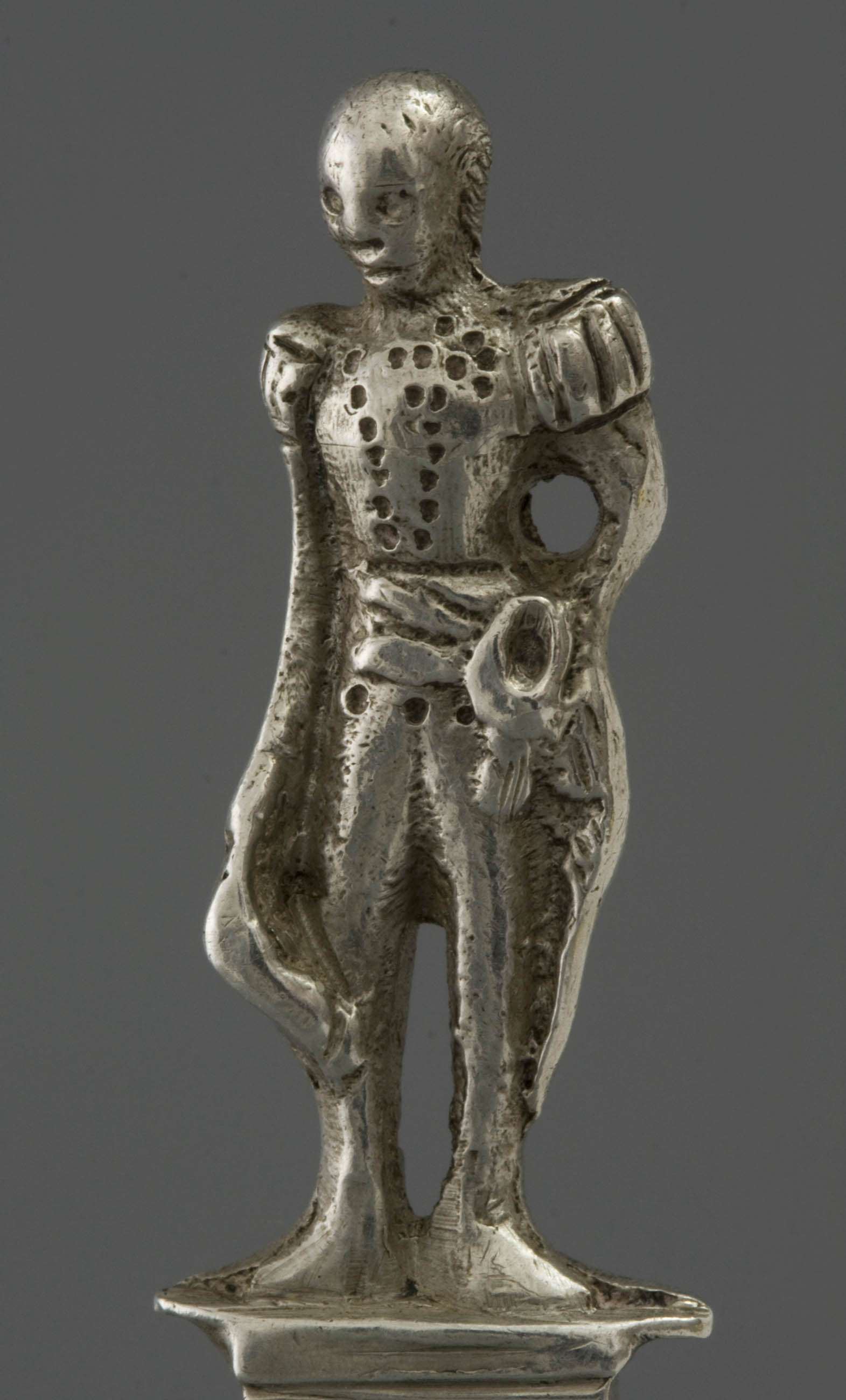
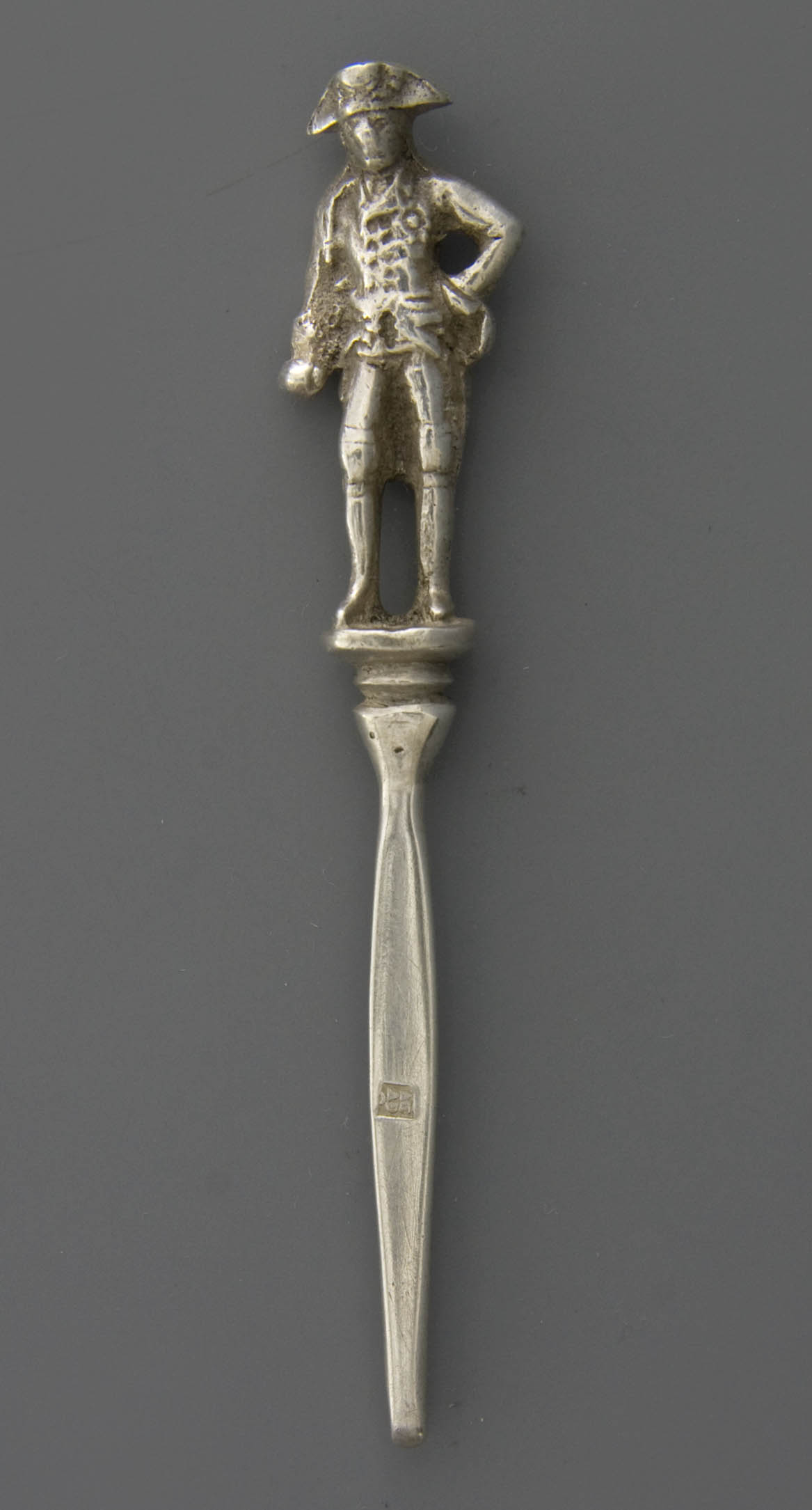
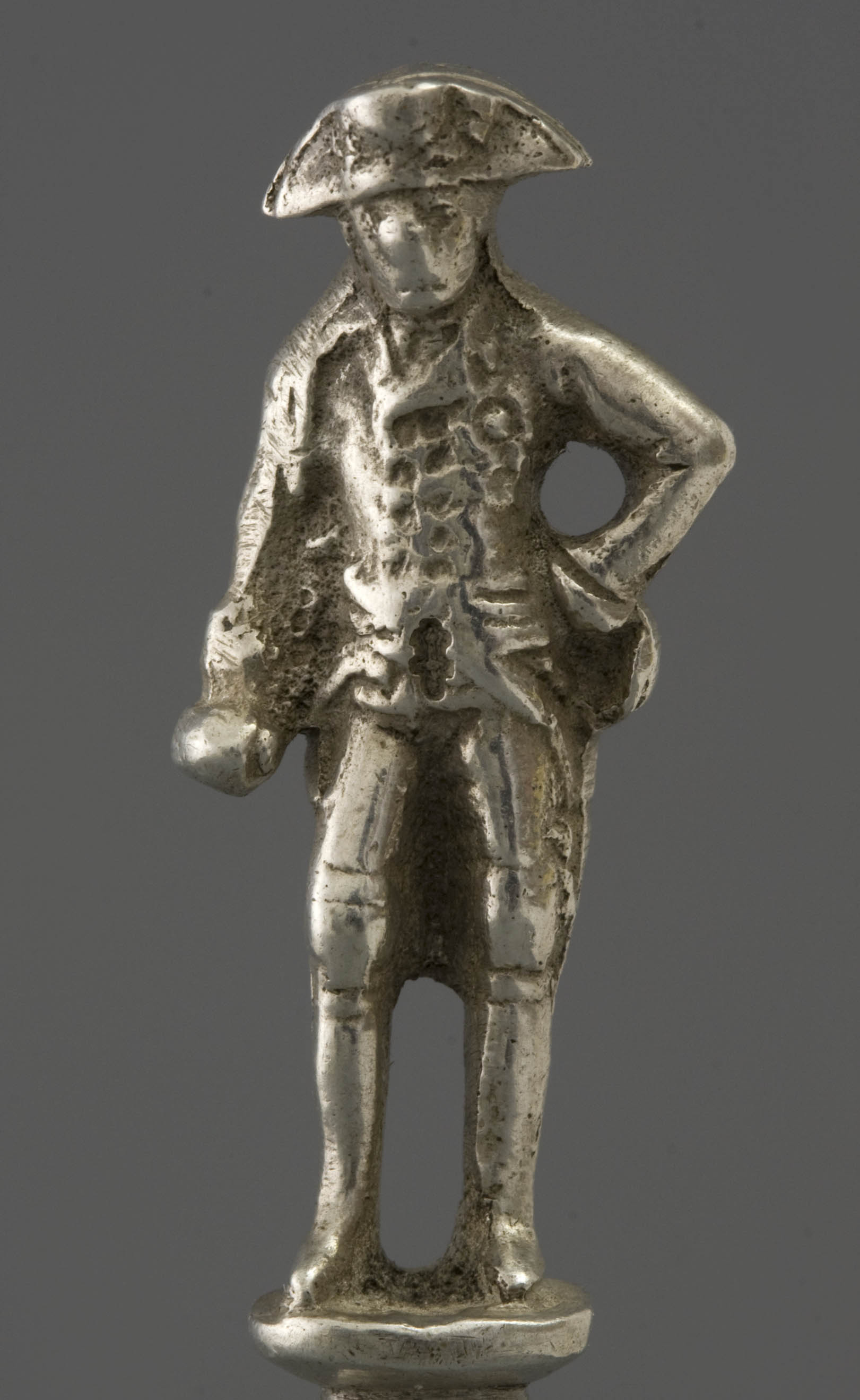
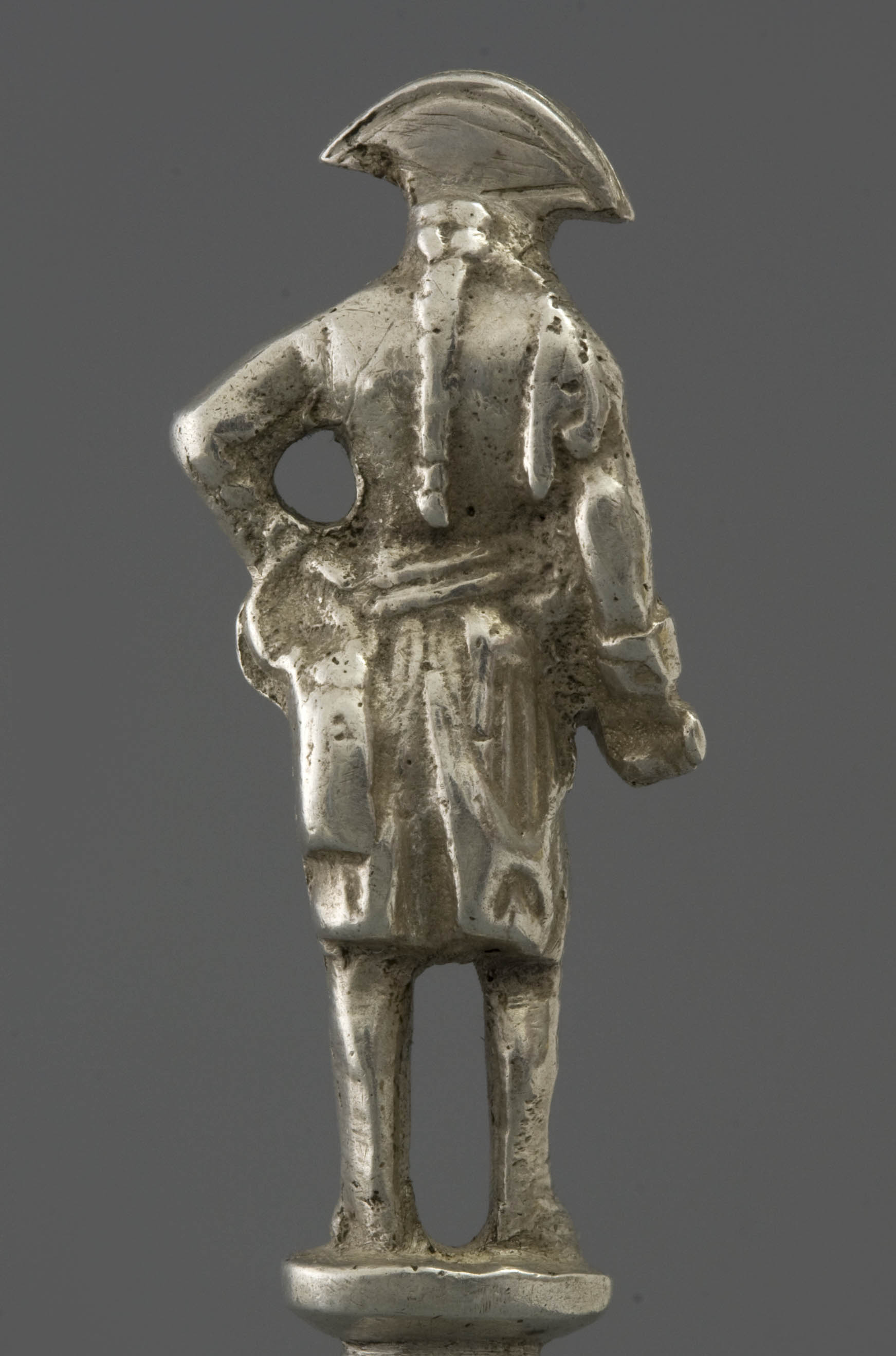
At about the same time, shortly before 1820, the Amsterdam silversmith Oepkes made a lot of work out of a ship cleaner (Fig. 45). He did not twist the pricker by turning it mechanically, but by filing, generating a more massive result. By the way, his Amsterdam colleague Van Heezel made the same pins at the same time (Fig. 33). The columns with the ball certainly demonstrate commitment of the maker, although the effect can be more convincing. In this three-mast vessel, the silversmith imitated a profiled ship's hull with circles that suggest the gun holes, on which square masts with fluttering flags. Both the masts and the flags bear pressed patterns. This sawn skeleton was dressed with three triangular smooth sails, which were soldered at right angles to the hull. A bit redundant, little waves were engraved on the narrow ground. In spite of all the trouble, this highly three-dimensional ship hasn’t become totally natural. Primarily that has to do with the thick masts. However, the quality of the cleaner is in the daring choice for three-dimensionality in combination with the robust execution, certainly not in its realism. Positive is that the top forms a sturdy handle and not a fragile decoration.
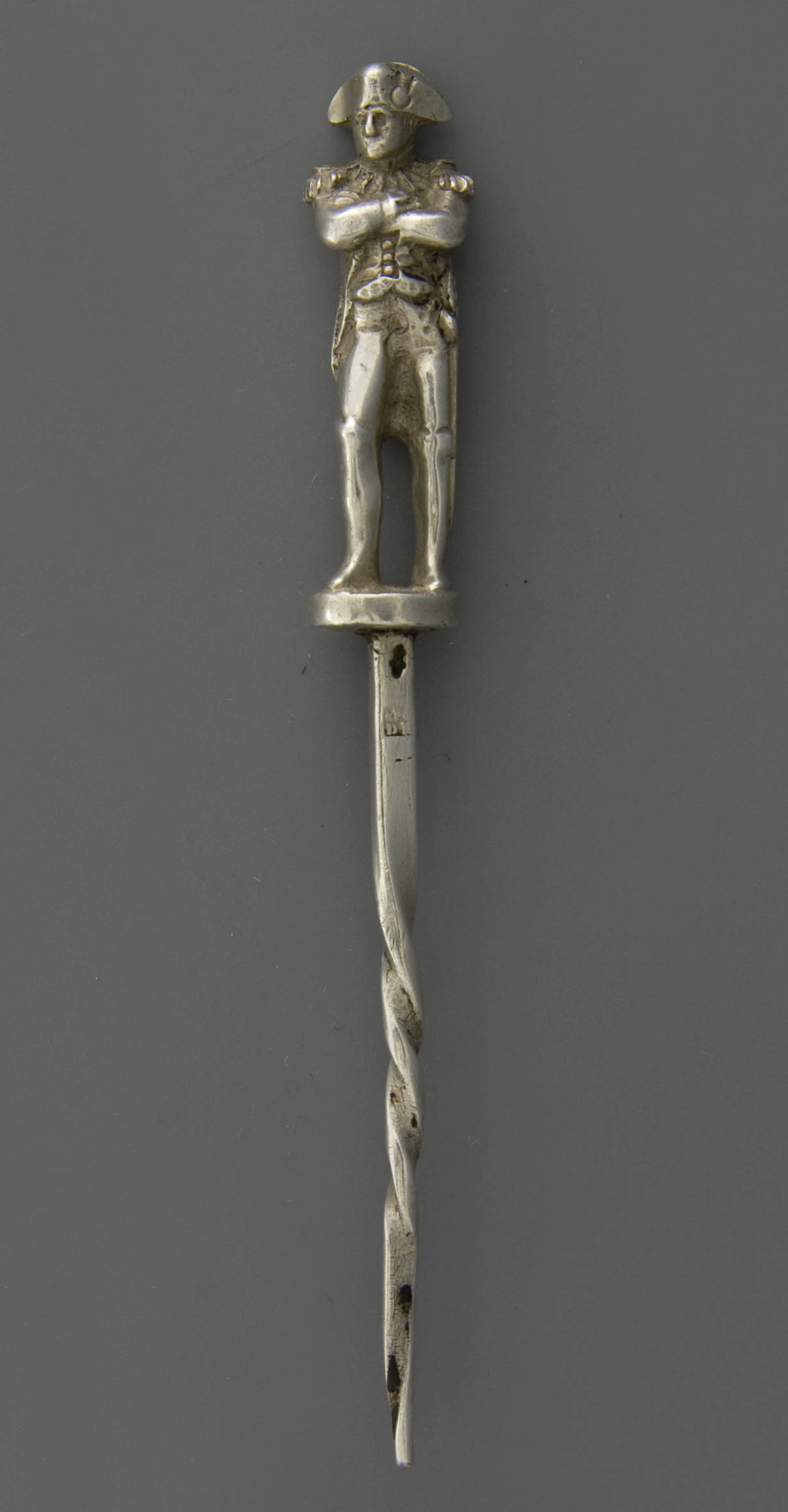
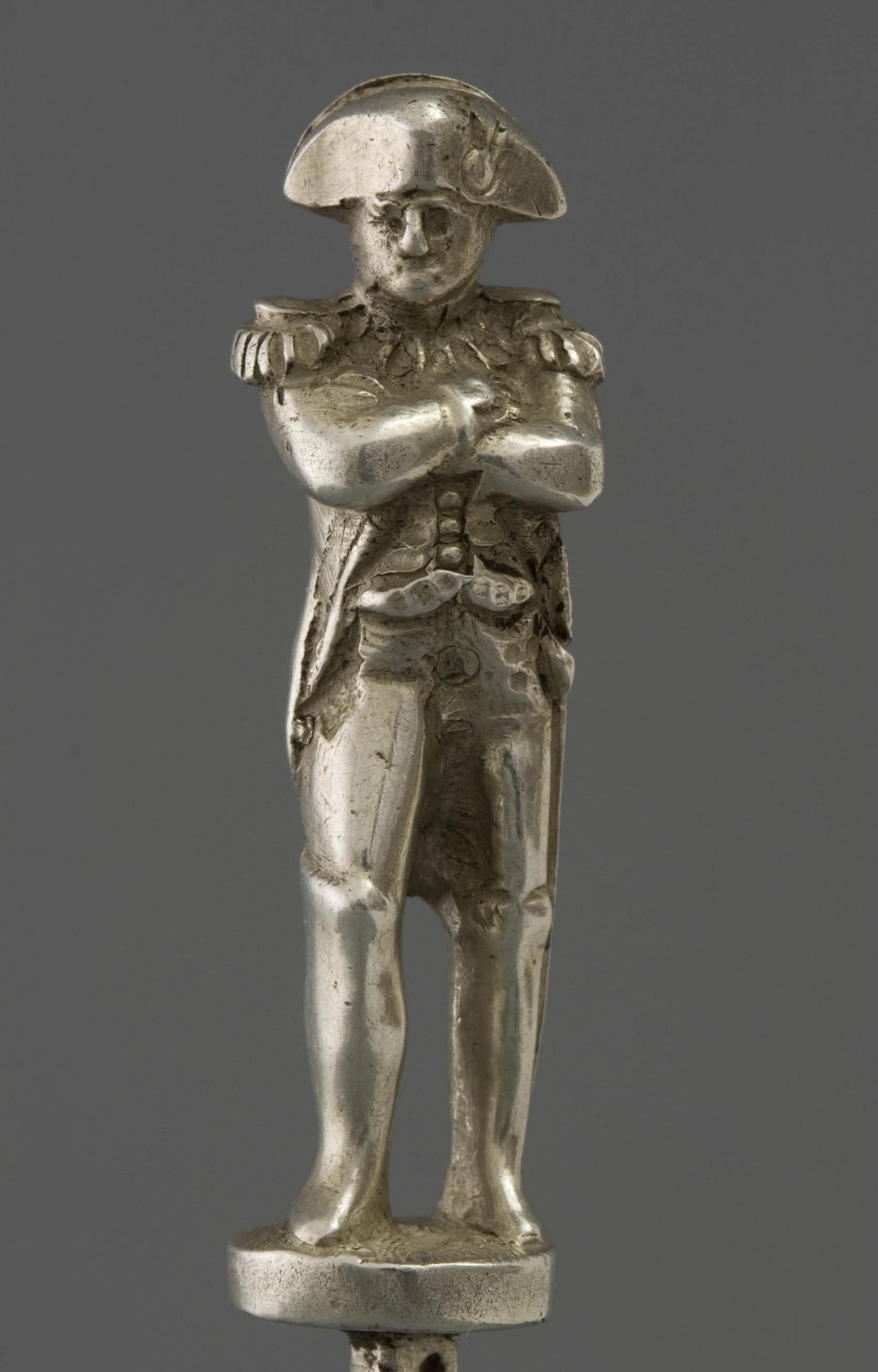
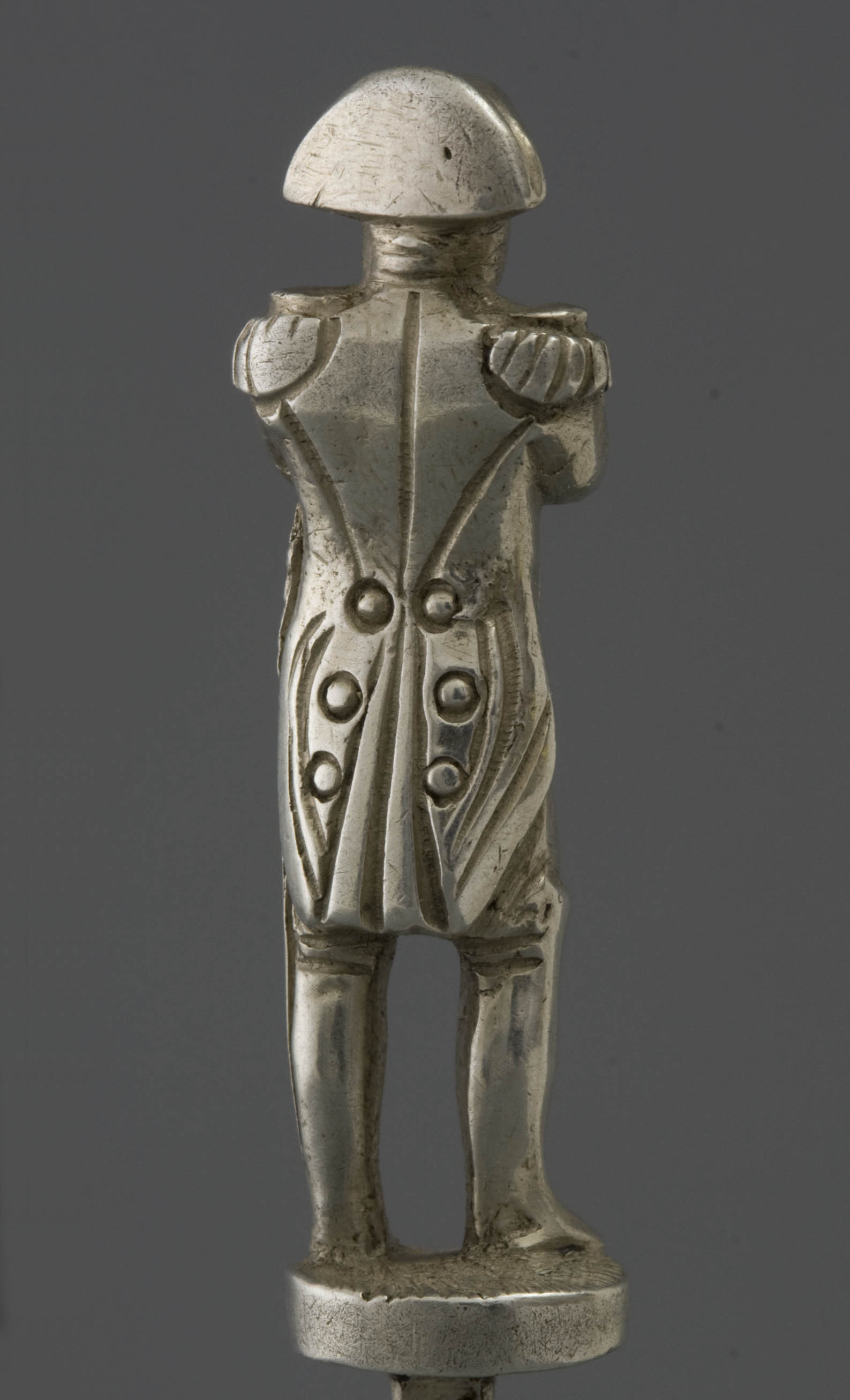
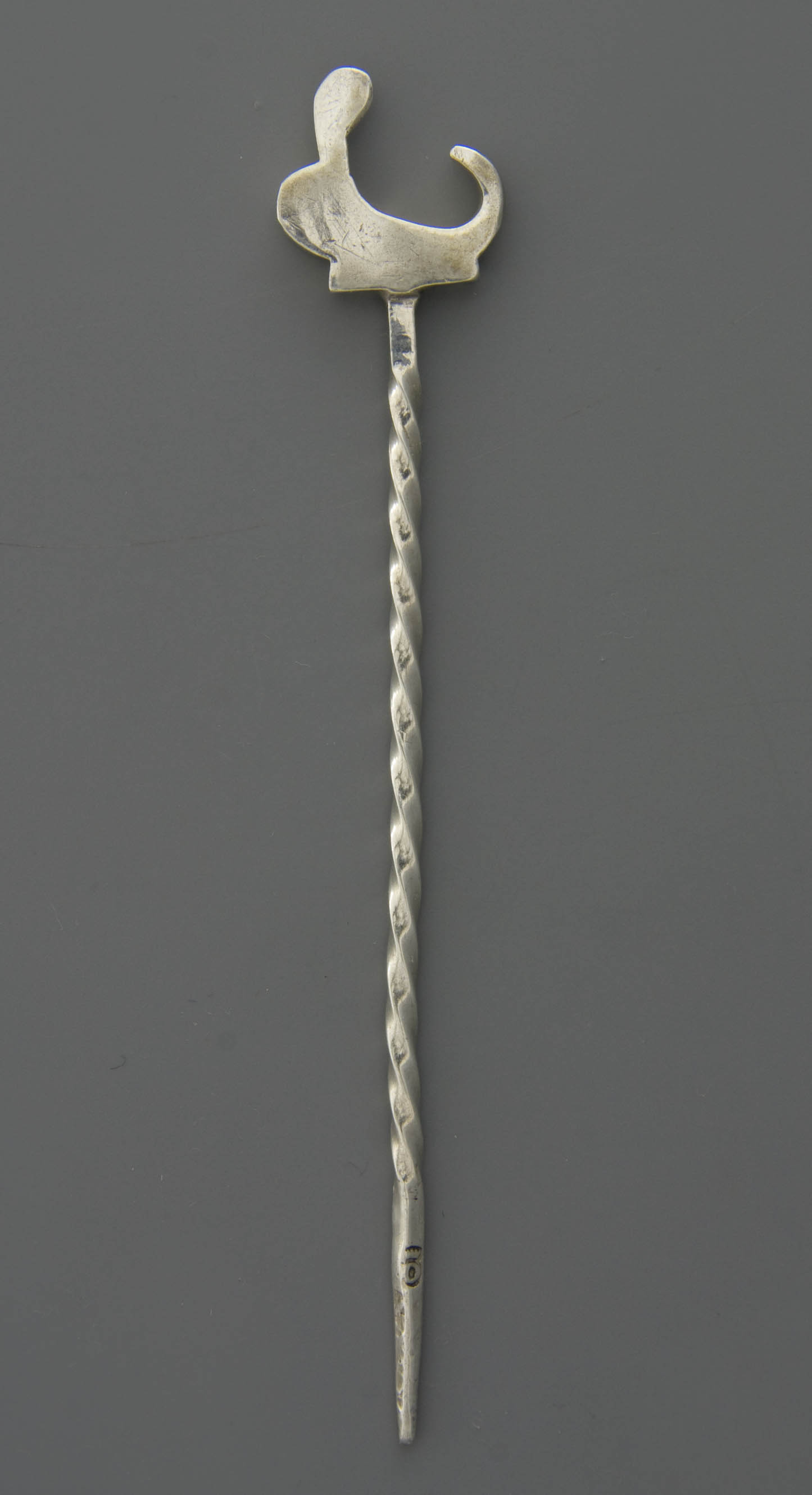
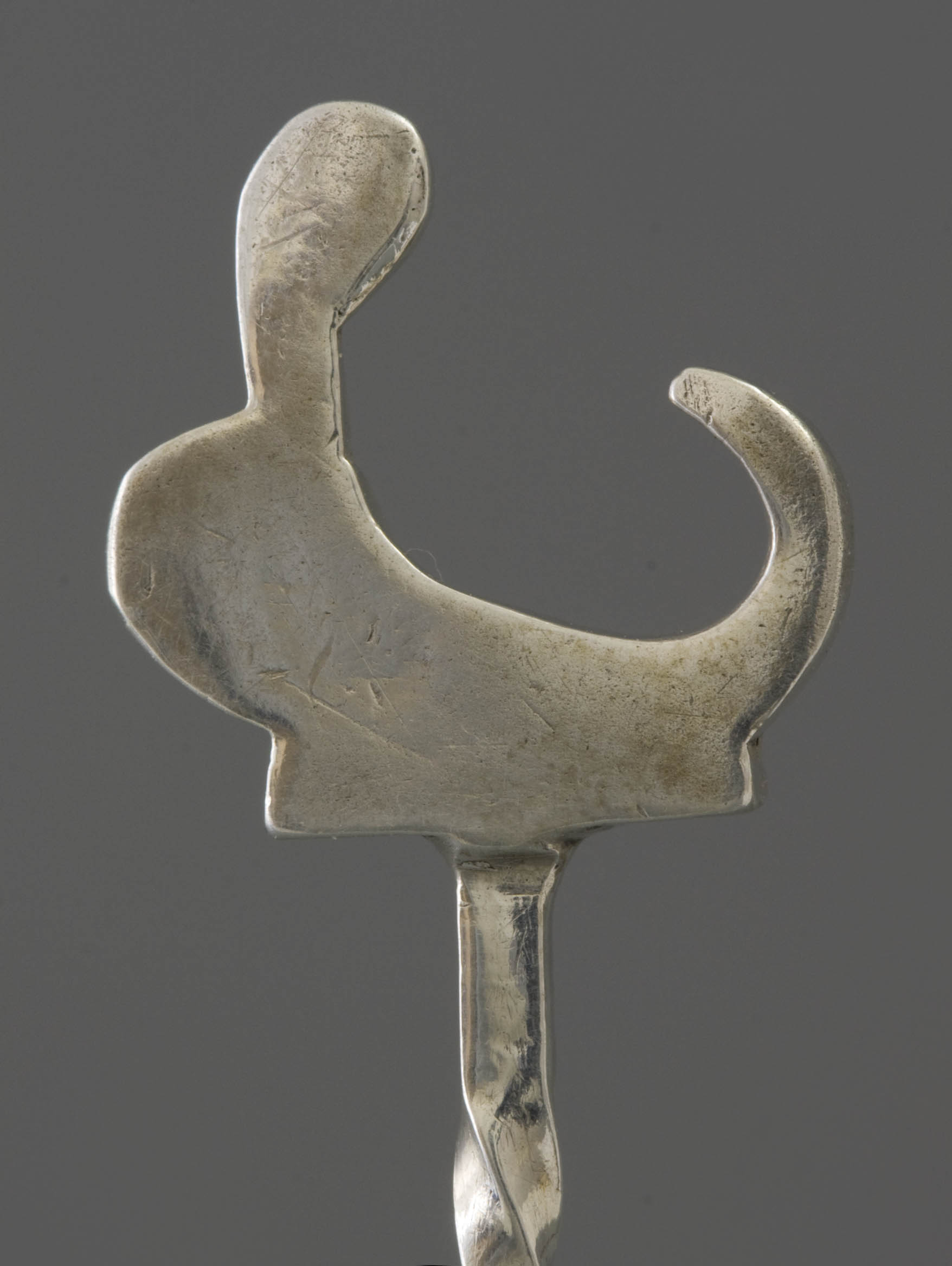
The two examples above prove that the execution of the pipe cleaner can vary greatly. Certainly half of the handles were cast and then chased before soldering on the pen. With many of these moulded figures the seam on the sides are still clearly visible since these were never completely smoothened. Apparently that didn’t matter at the time. Details are often accentuated with the burin for better expression. An interesting example breaks with the pattern of the common pin versus top and shows instead an accumulation of elements that run halfway up the pricker of the cleaner (Fig. 41). A blacksmith workbench with a hammer and a pair of pliers make the very top. Below is a T-shaped anvil with even further down the pin a bellows. This resulted in an interesting silhouette consisting of three connected elements.
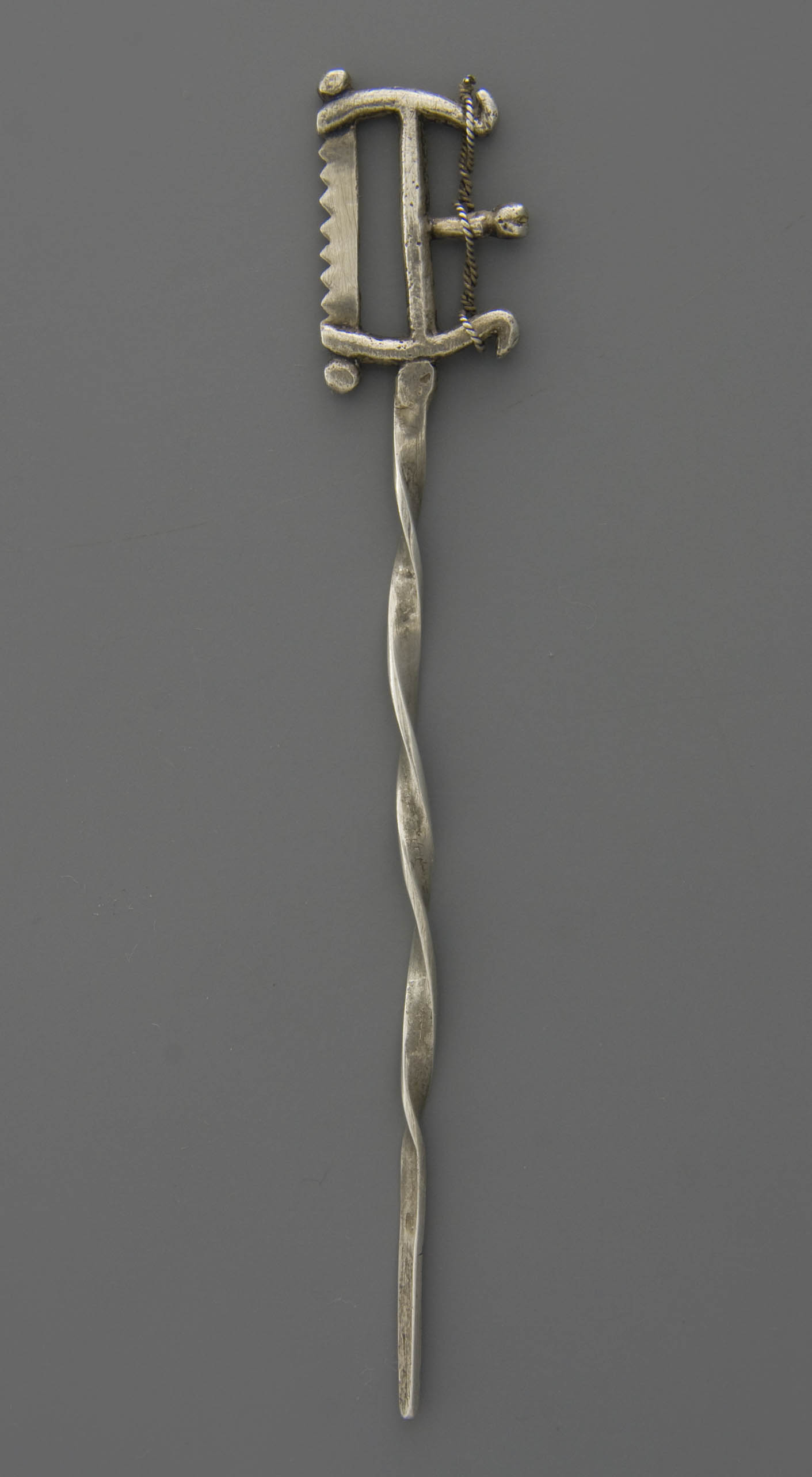
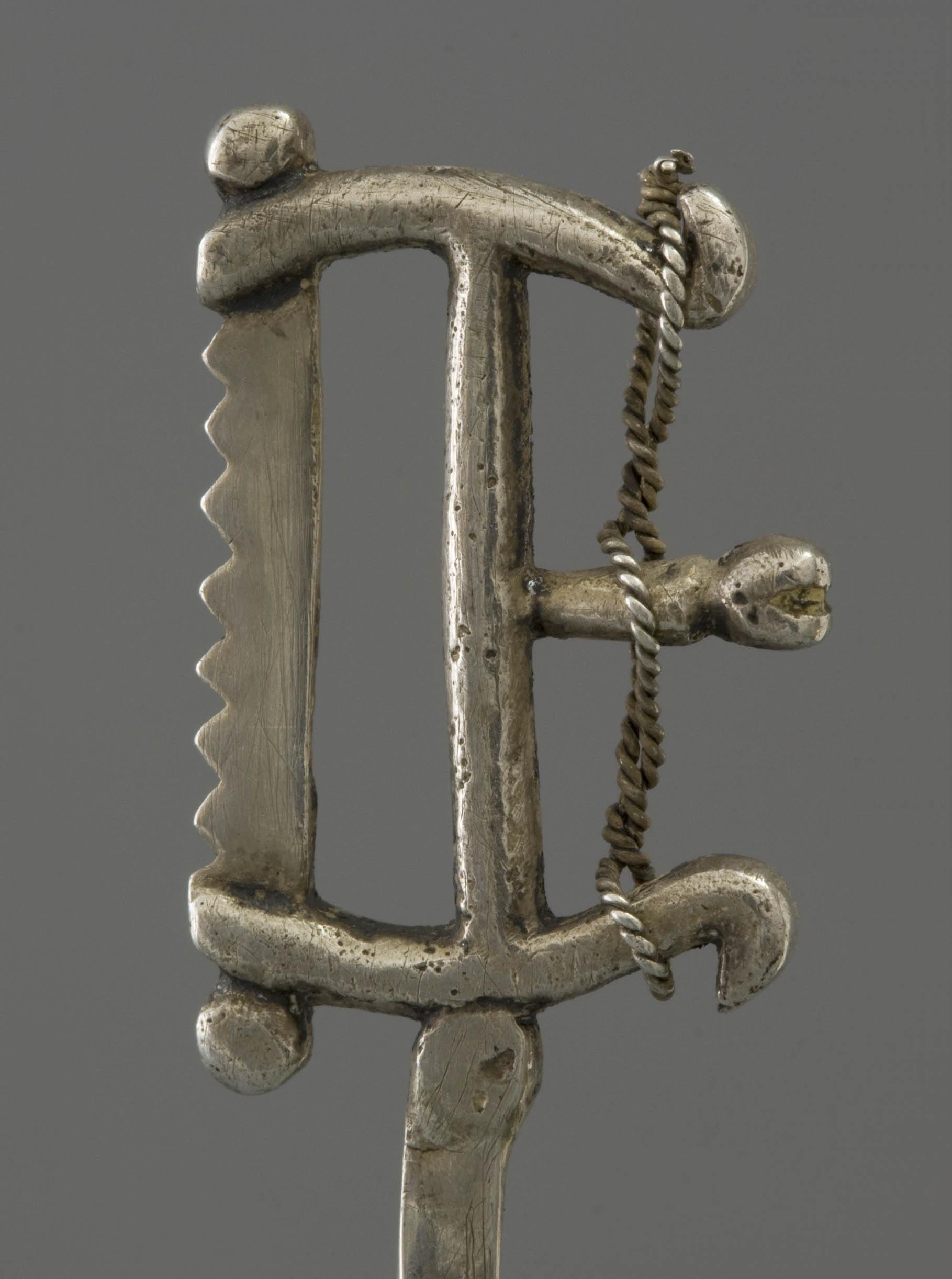
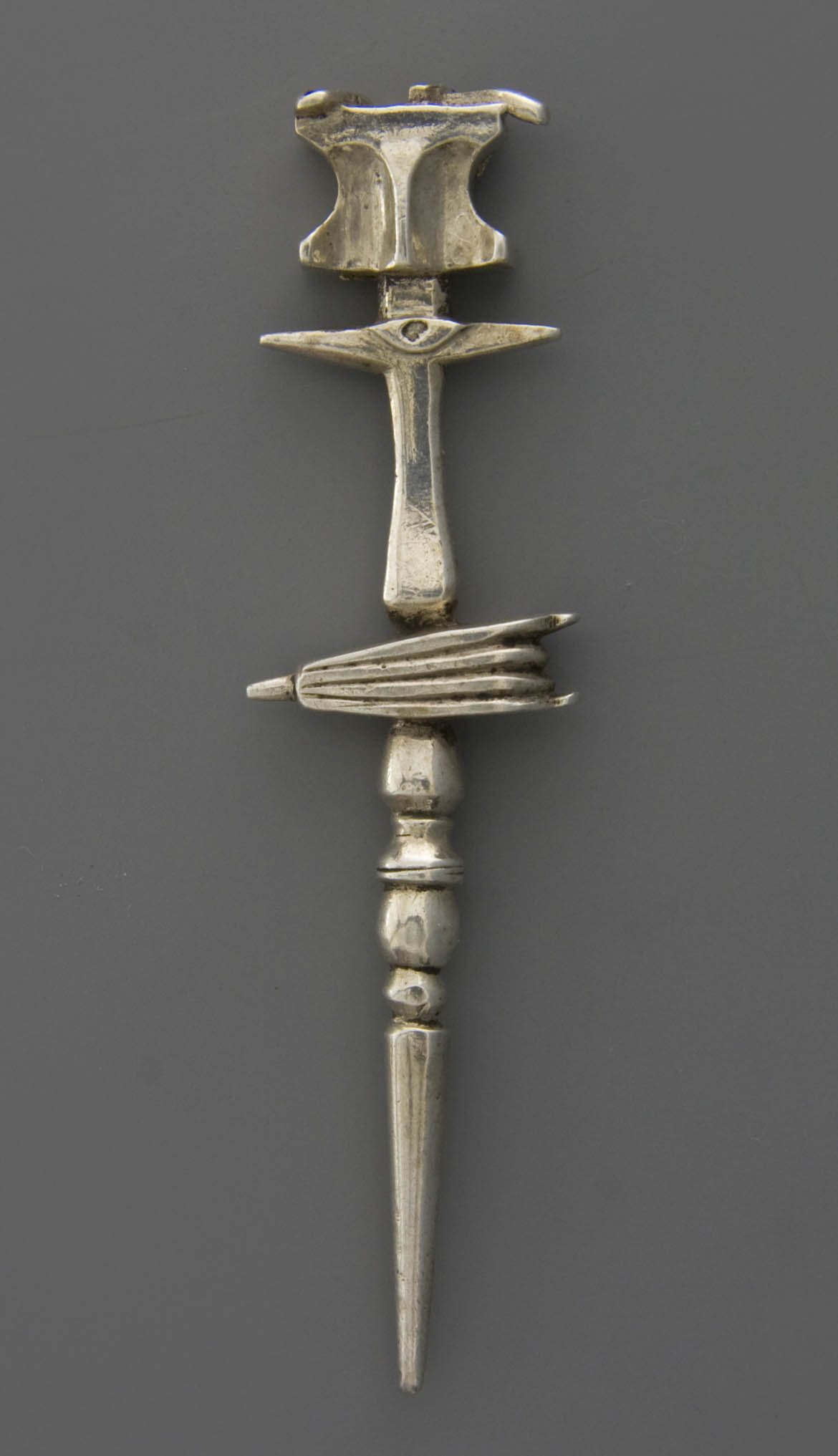

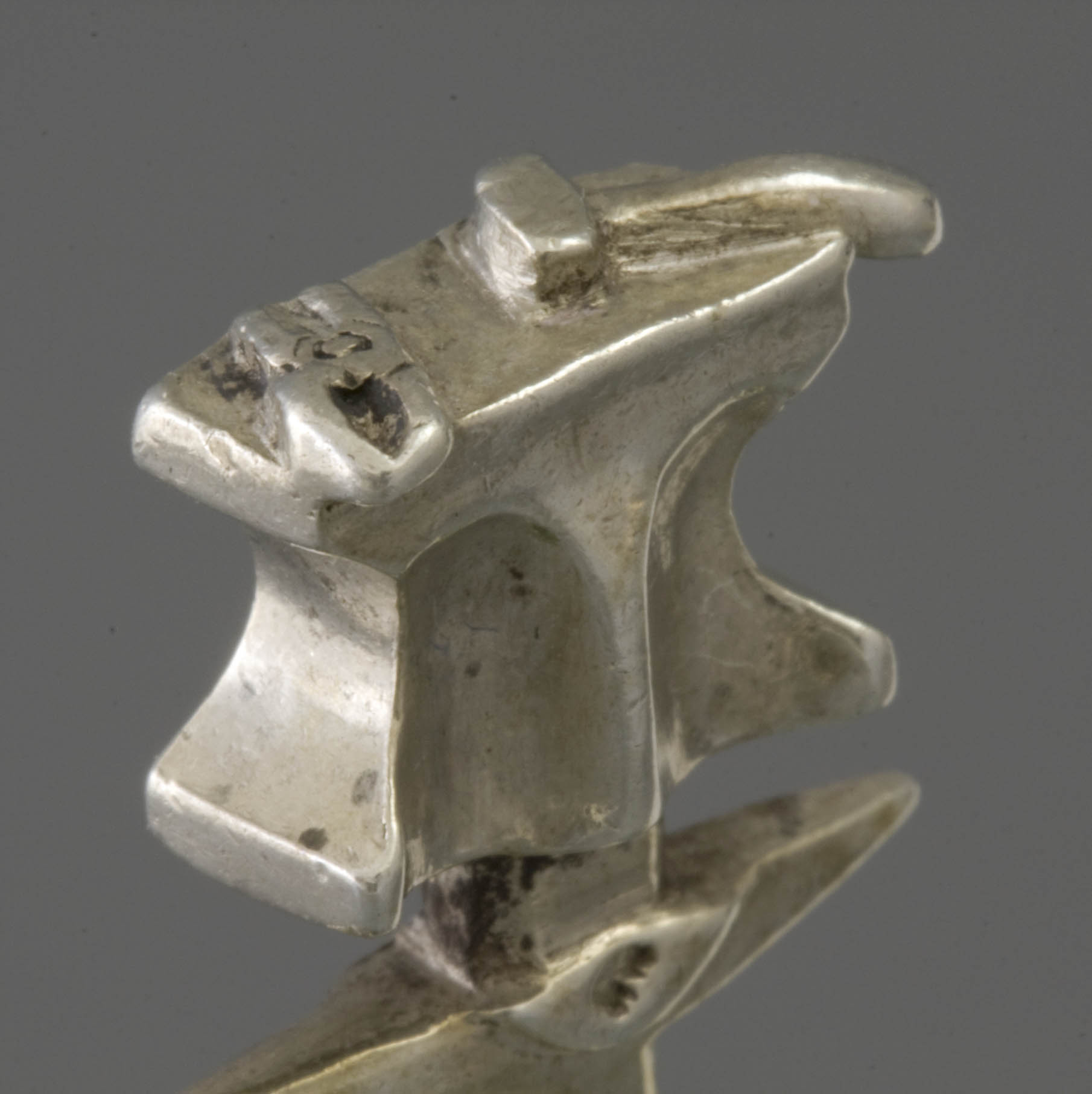
Many pipe cleaners from Schoonhoven, the silver town with the only silver smith school in the country, show a specific technique. It is based on relatively thick silver-plate that is abundantly shaped with a saw and a drill and then testily filed. Finally, the depiction was finished with hatching lines engraved with a burin. Such cleaners are said to be traditional pupil pieces intended to master the shaping from the raw silver. We can say that these cleaners handles show a specific local style. After being sold, they were apparently re-made in the same version, since we know identical copies of some makers that point to serial production. The crowning of a horseman on horseback (Fig. 9), spitz (Fig. 19) or lion with heraldic shield (Fig. 26) are characteristic of these Schoonhoven products.
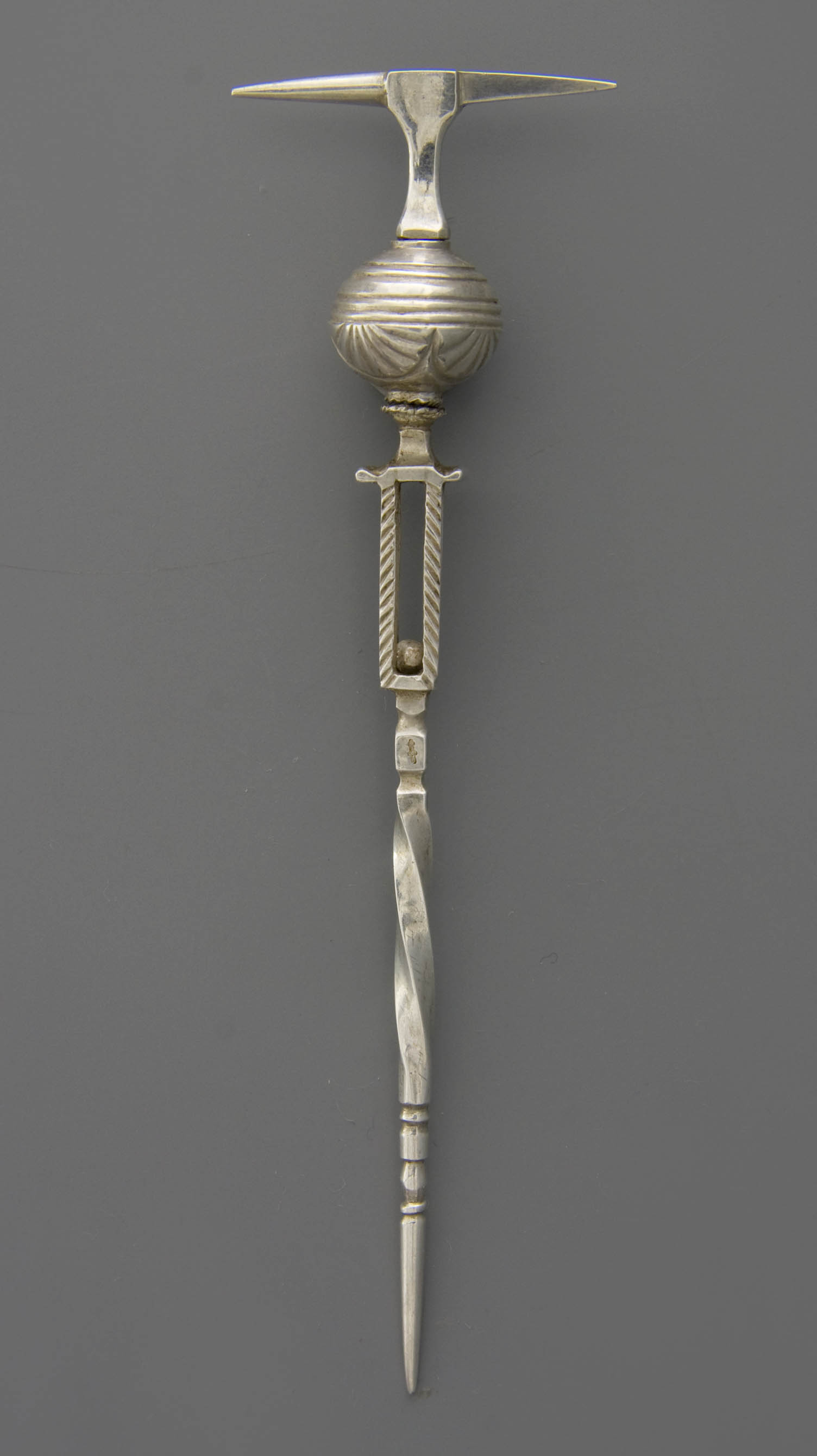
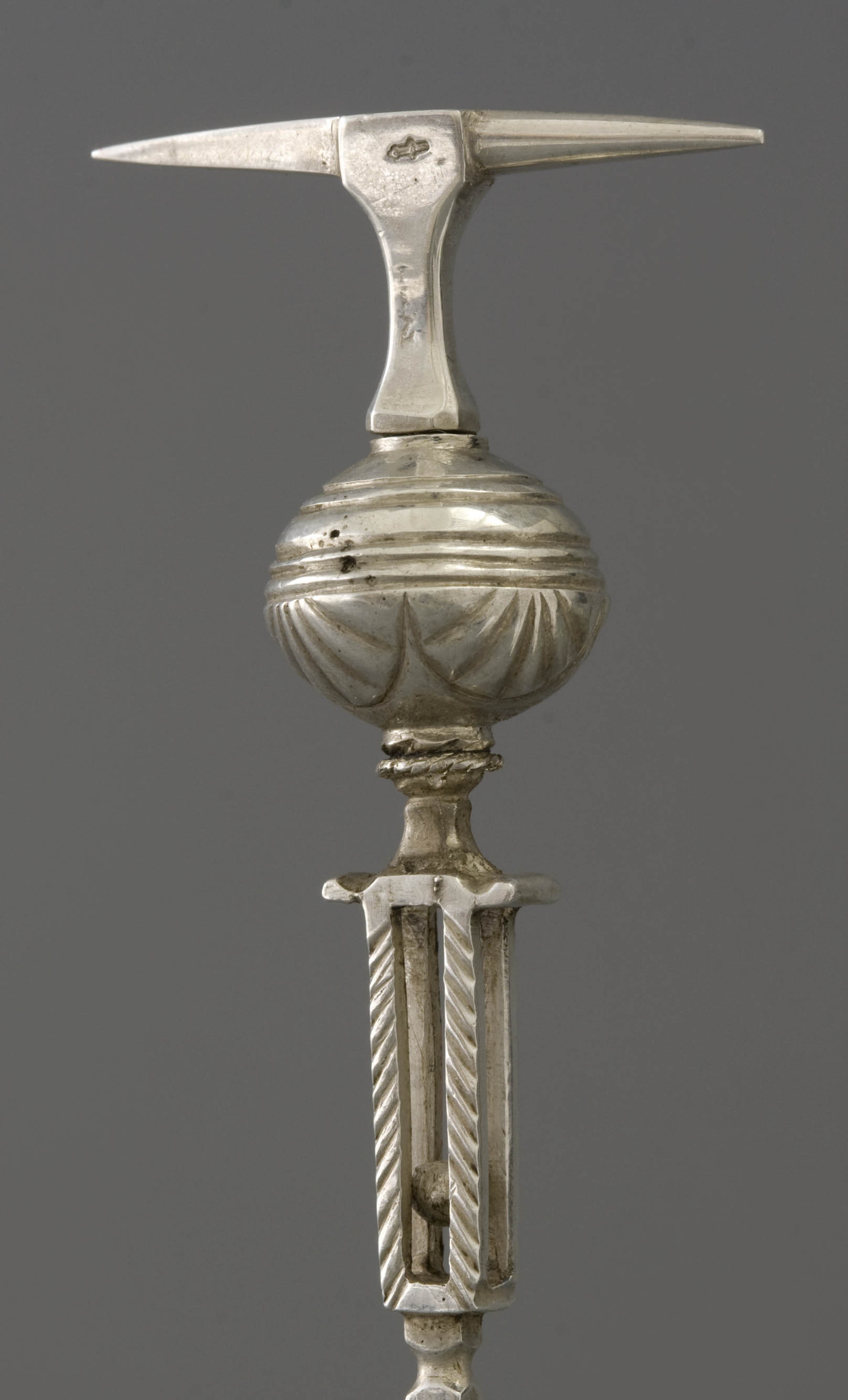
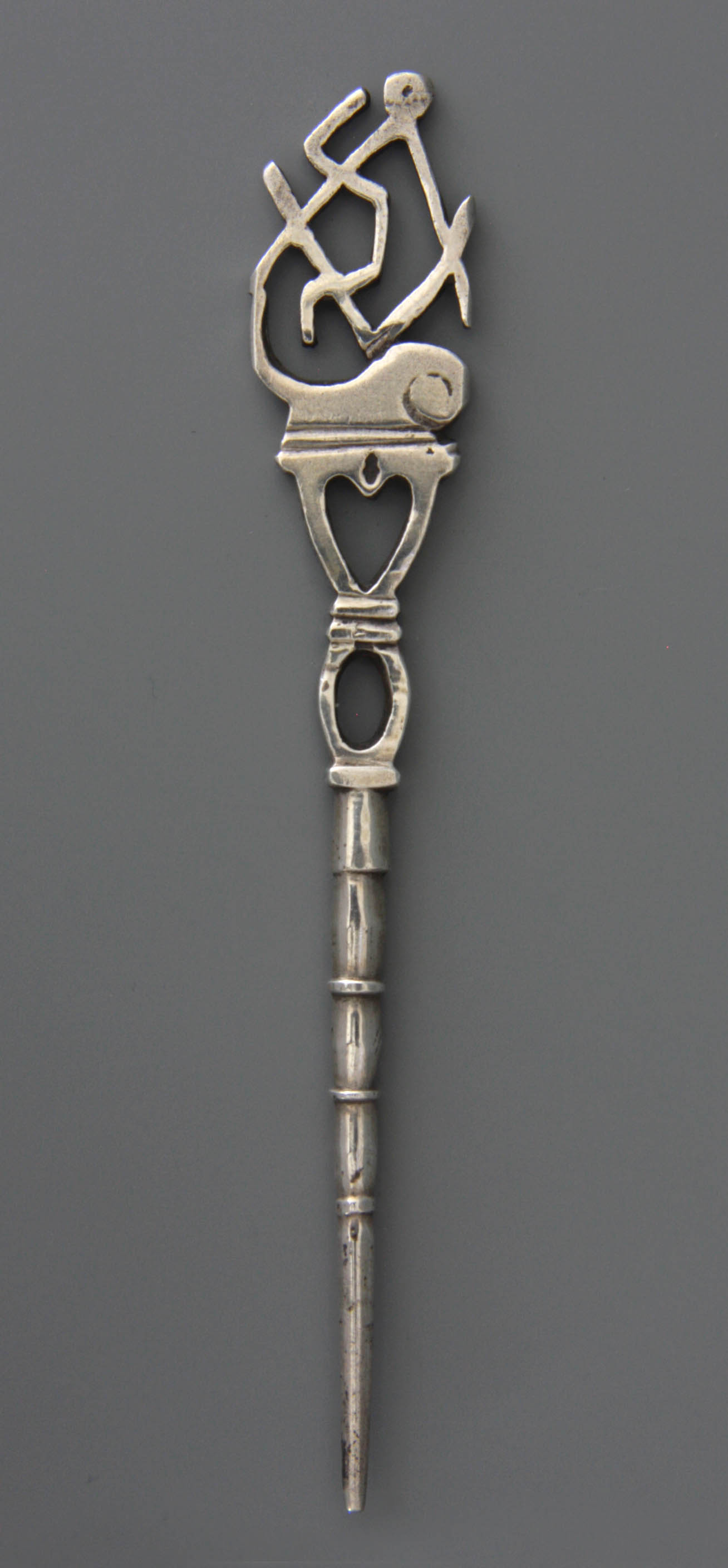
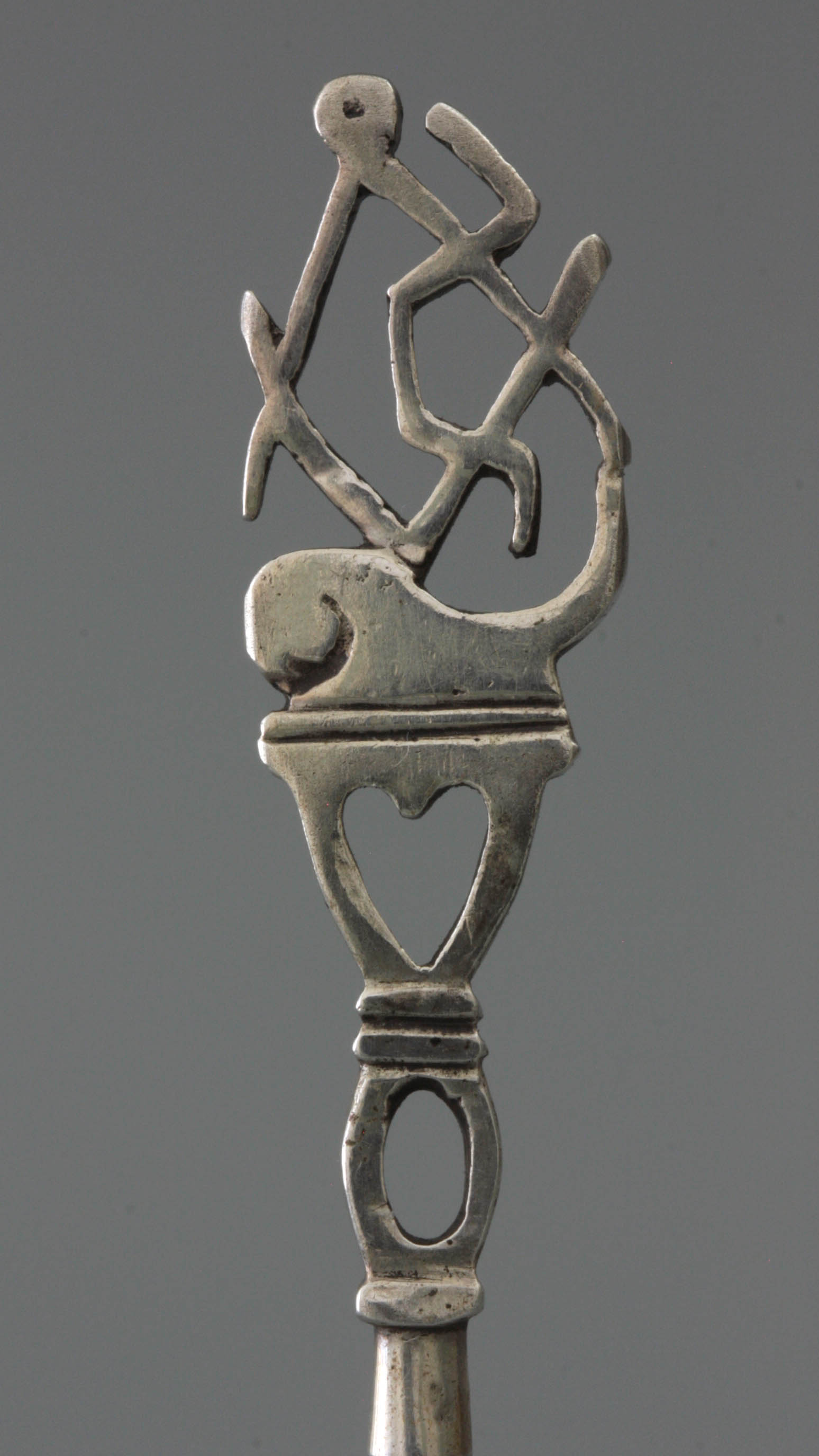
In many cleaner tops we find combined techniques. A nice and early example is the spitz in his loft (Fig. 18), where the doghouse is neatly soldered and then finished with engraving. The dog on the other hand is filed from a piece of solid silver. The dog sits on a flap which is attached to the doghouse with a hinge, again another technique. In addition to a political statement, this cleaner is also a conversation piece: among guests one can proudly open the little doghouse.
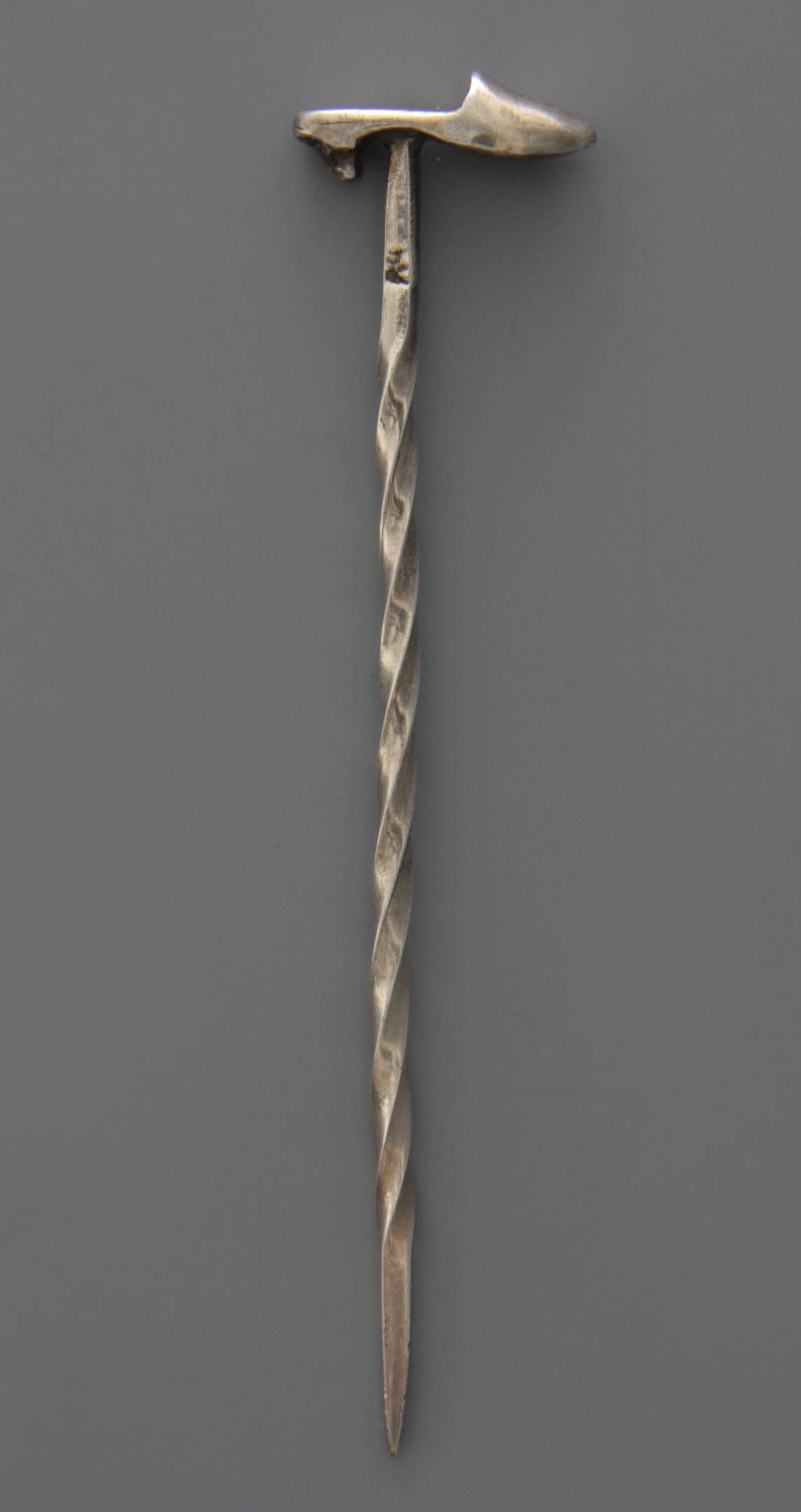

Some silversmiths make use of components supplied by fellow silversmiths for their creation. The creator of the pricker with the anvil (Fig. 42) incorporated a ready-made engraved ball that was placed in the cage. A silver worker from Goes bought cast depictions of a standing Frederick the Great (Fig. 37) and Napoleon (Fig. 38) to use as a cleaner top. It is unknown where he got them. We do know that in the years since 1830 a true craze emerged around these two legendary heroes in Germany and France. In my opinion these cleaners were not intended for the Zeeland smoker,

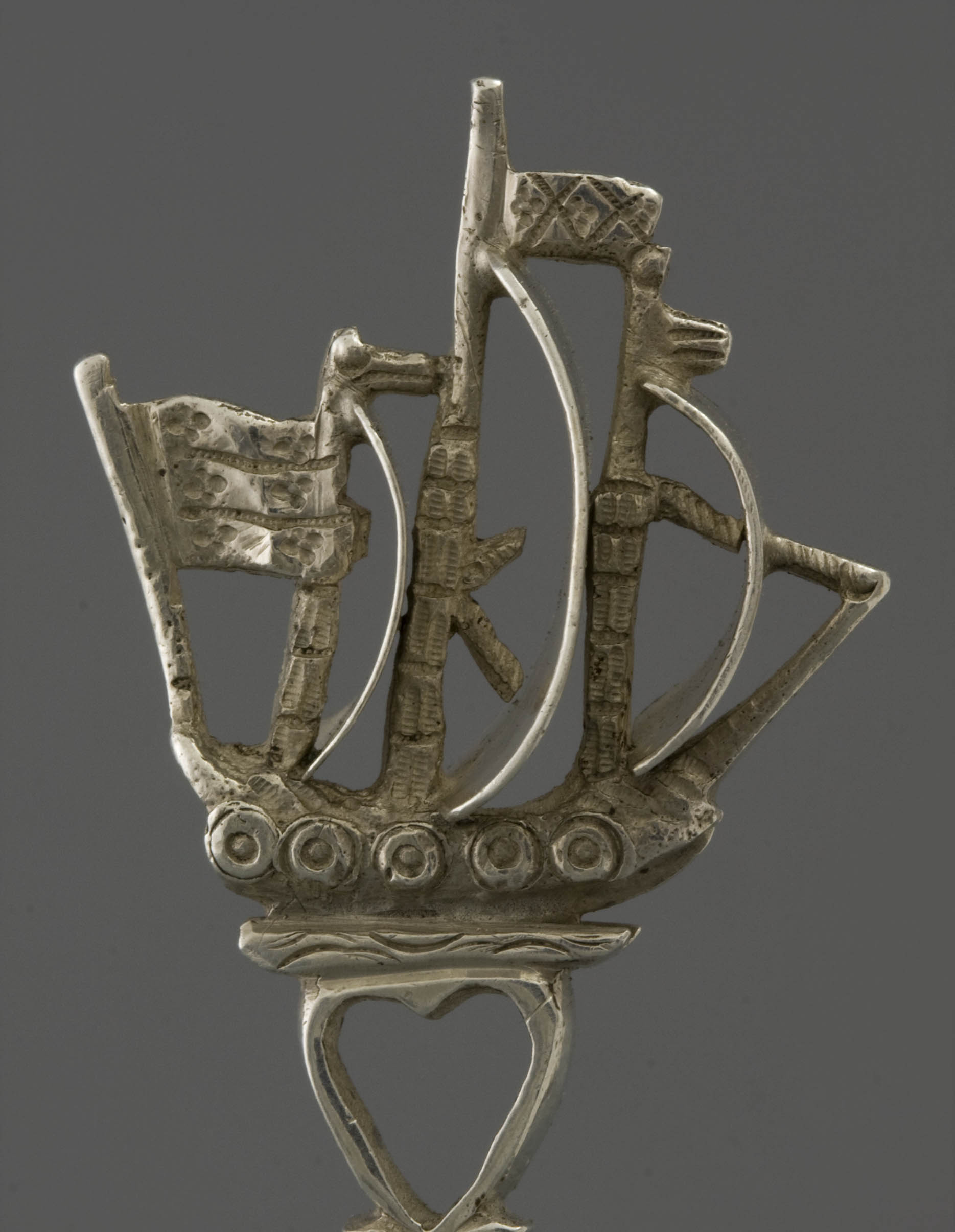
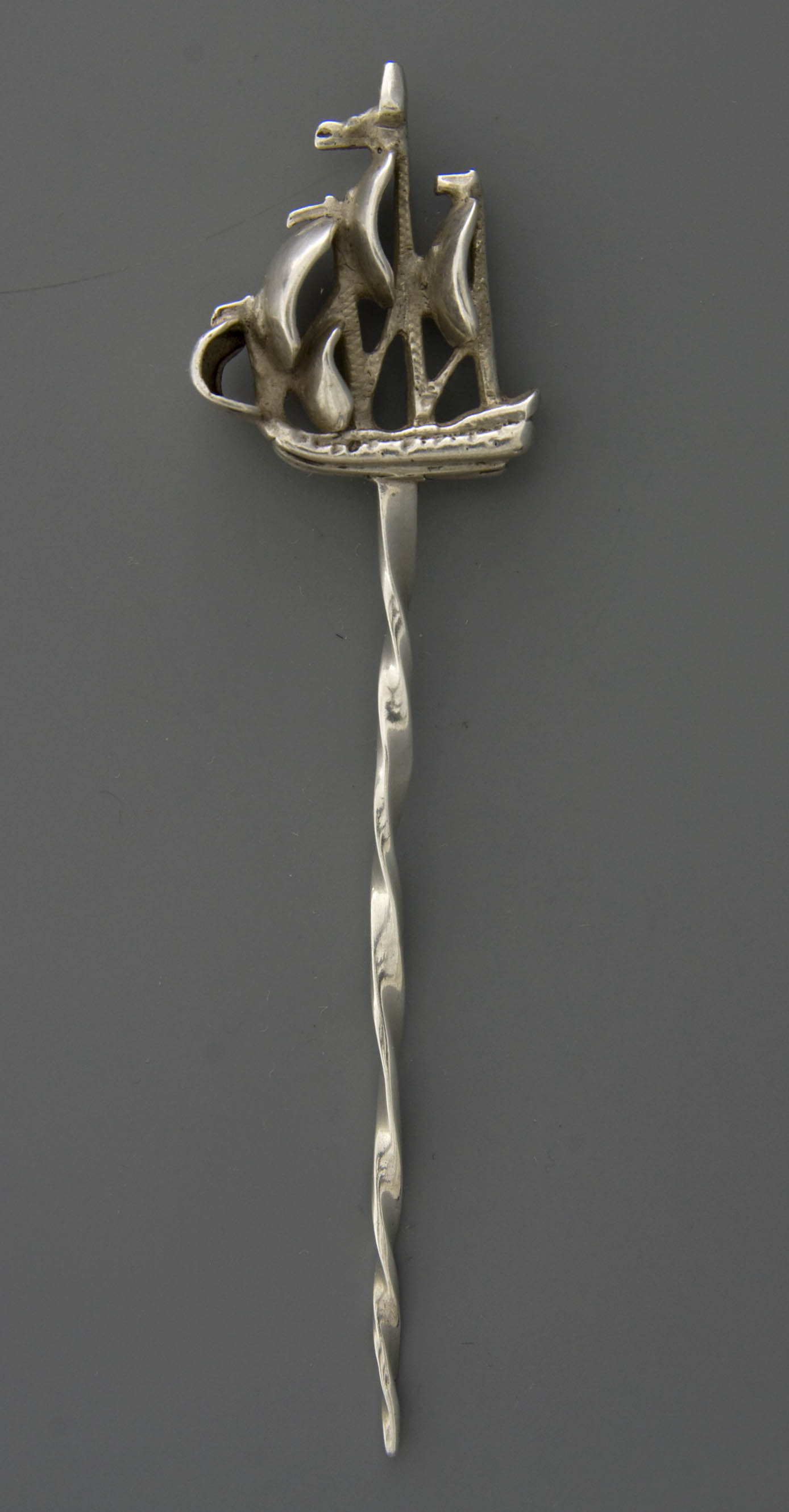
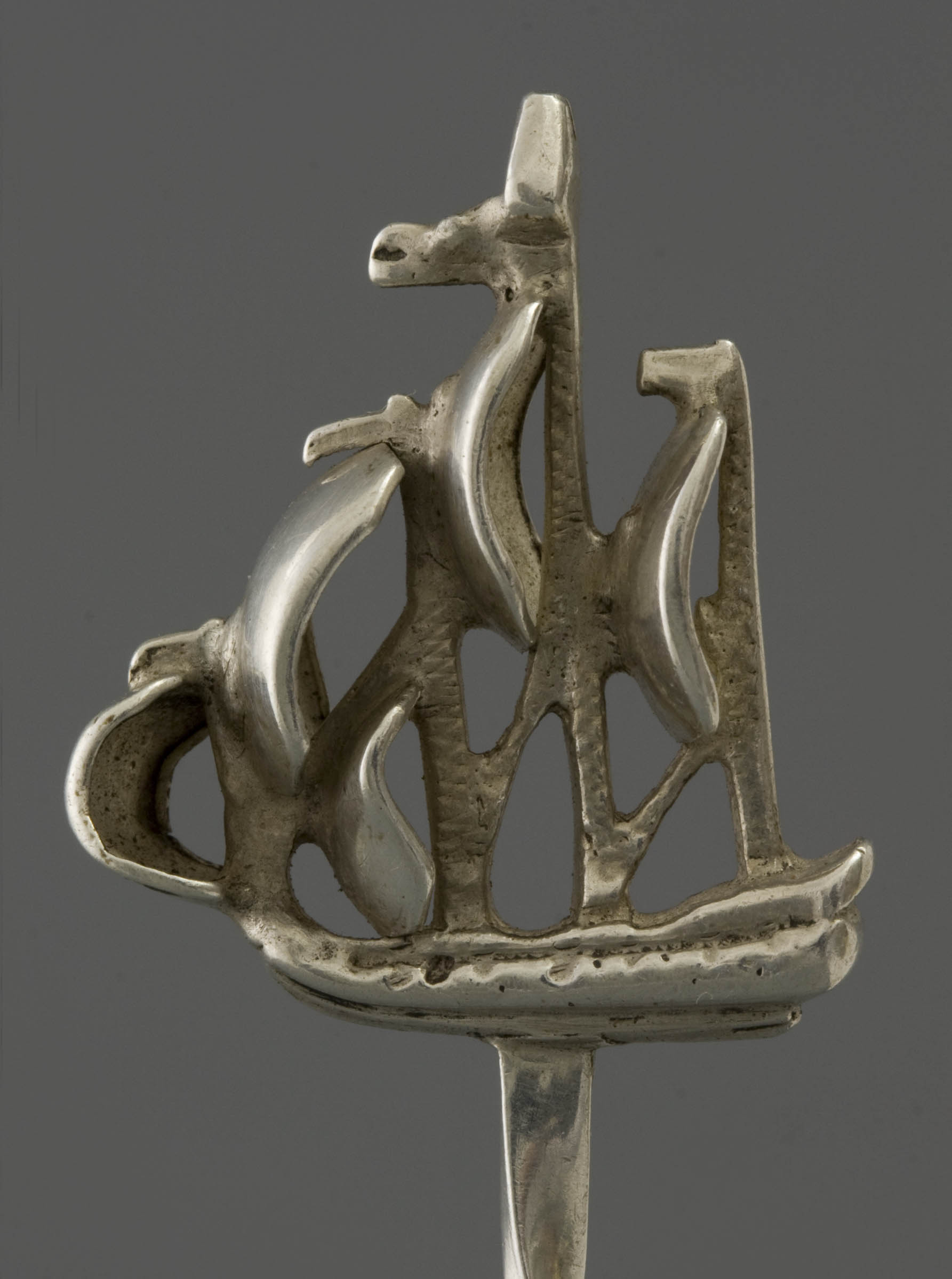
A special pipe cleaner in a strong folk-art style shows Dutch characteristics, but due to the silver hall marks must be of German manufacture (Fig. 51). Presumably it originates from Northern Germany, where it is mimicked from counterparts made in the adjacent Dutch provinces of Groningen or Friesland. This specific cleaner displays clearly the farmers ostentation , which makes the design so special. The top consists of no more than three ears of corn tied in a bow with engraved owner's initials beneath them. The showy appearance comes from the heart-shaped frame that is surrounded on both sides by six stacked pearls and is crowned by a lip with suspension eye - note the twisting - and twice a band of wound silver wire. The flattened pricker has remarkable file work with a taping rhythm.
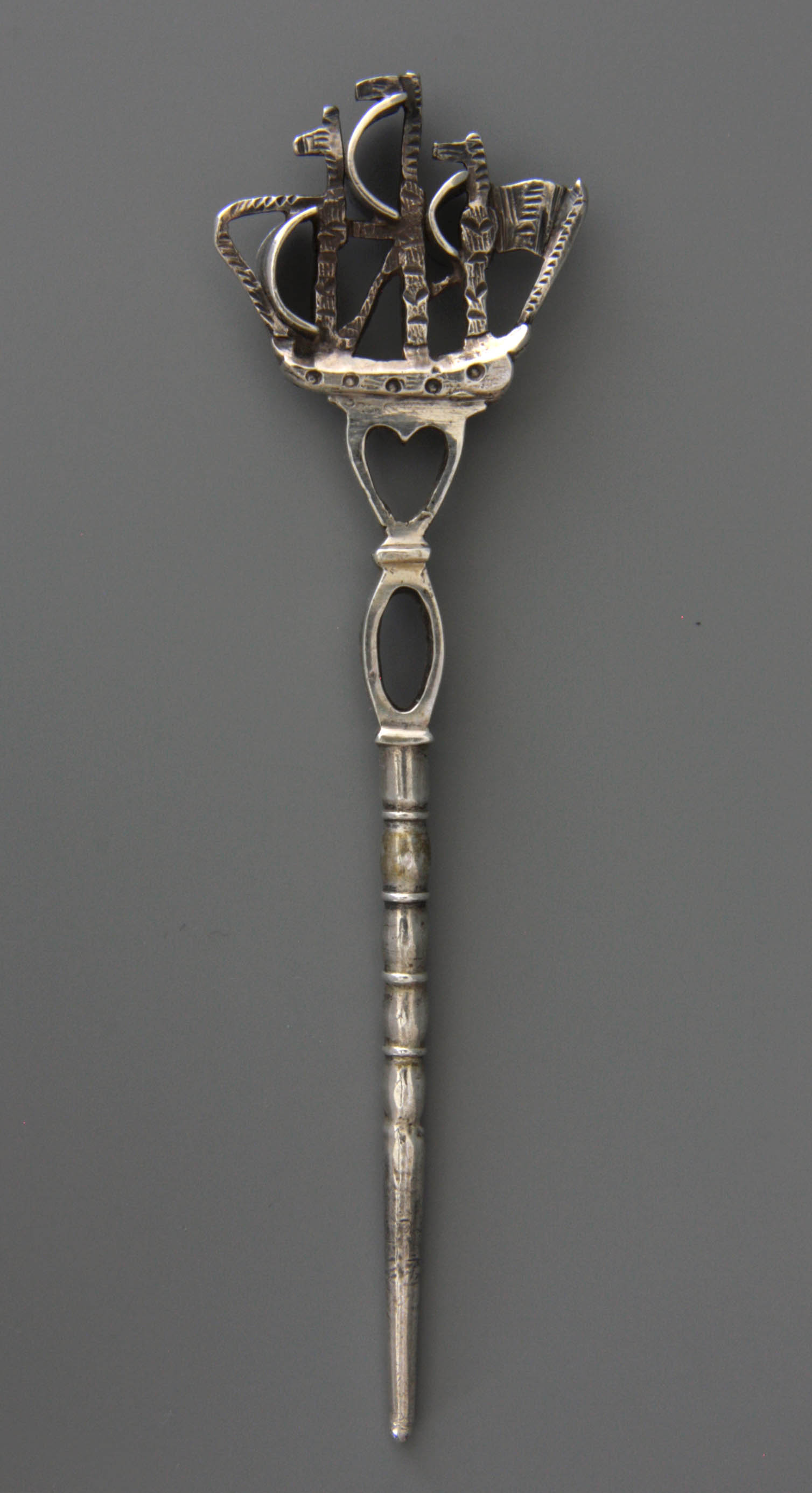

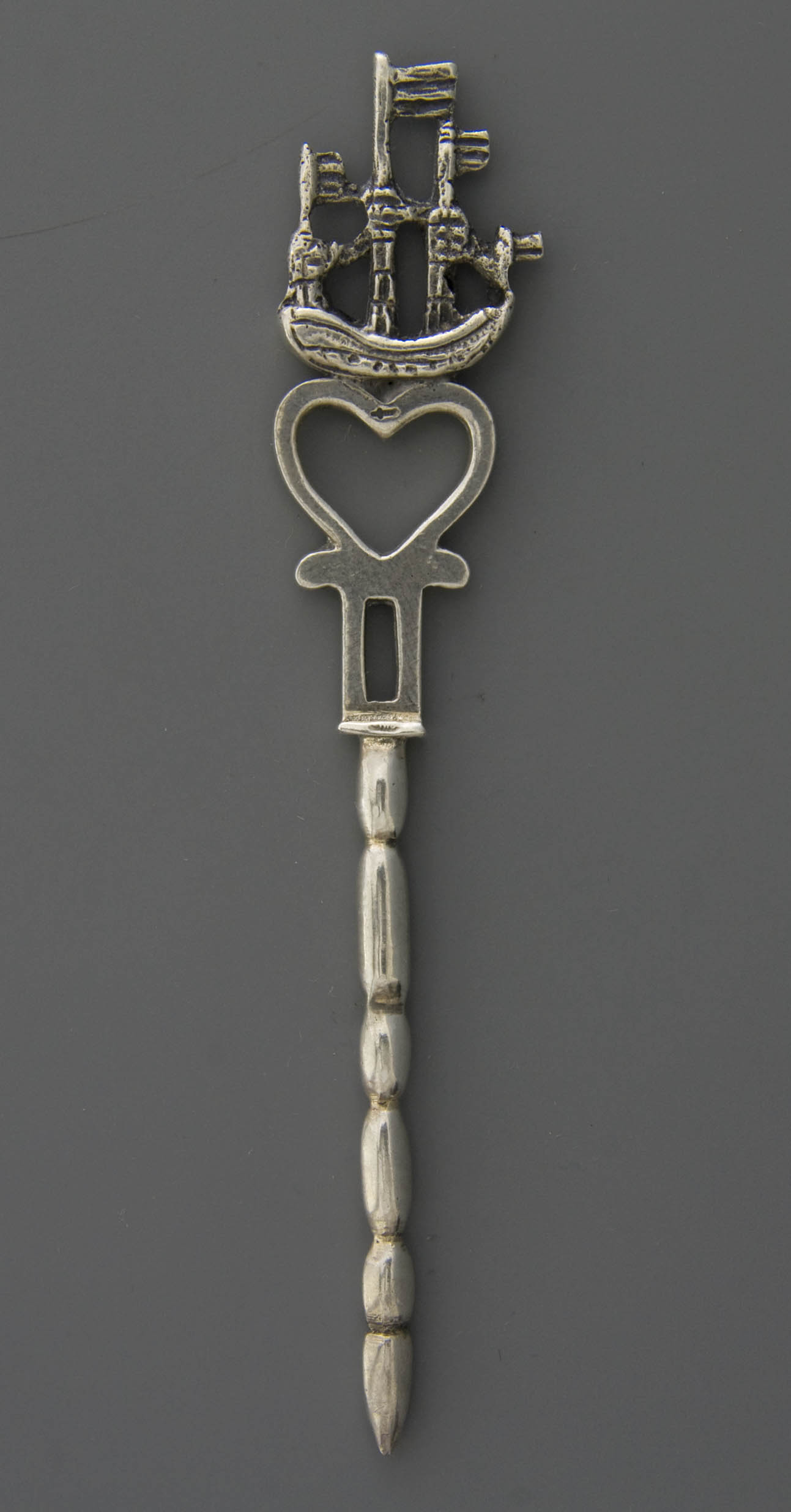
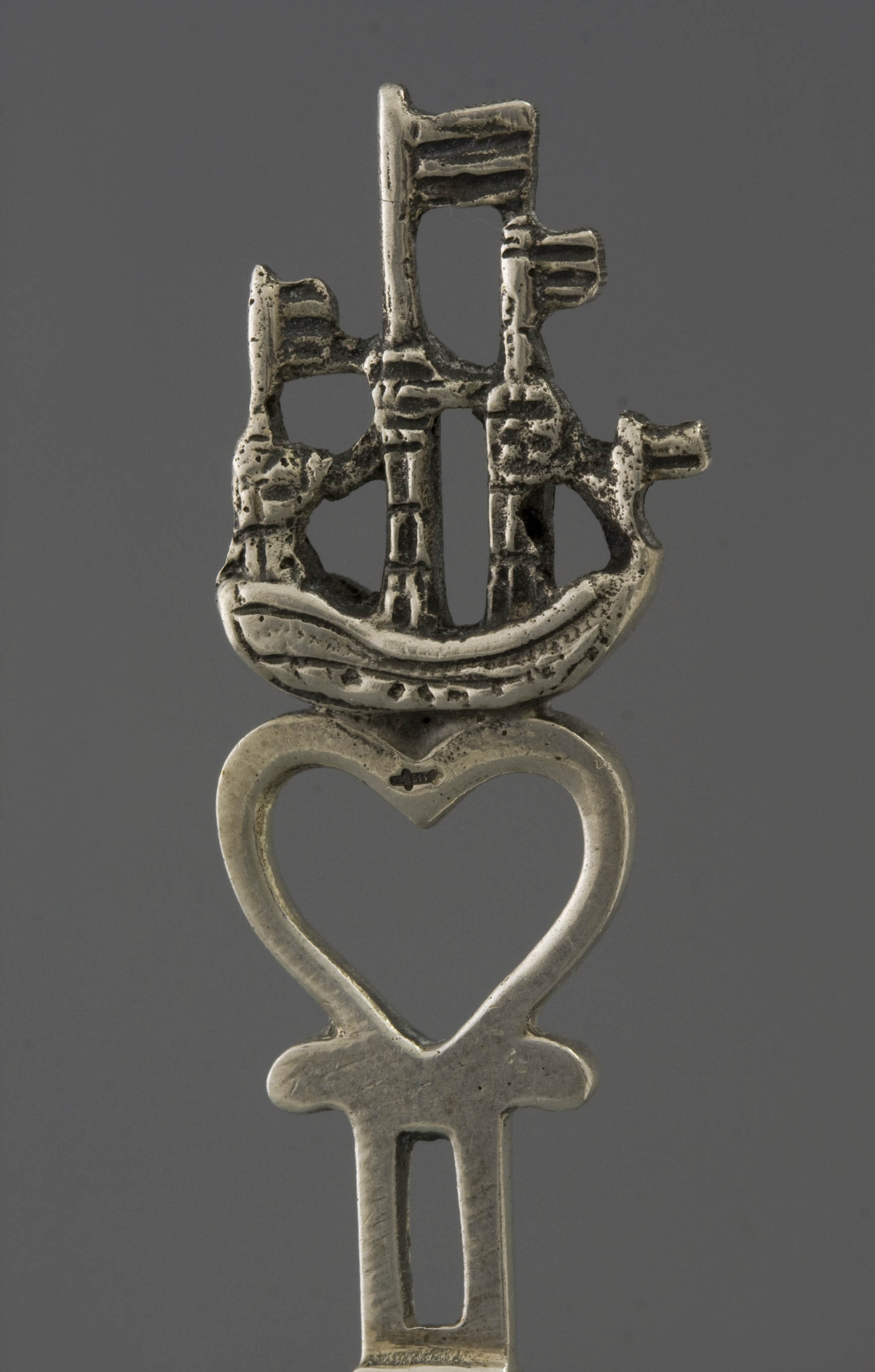
A distinct group is constituted by the silver cleaners cast from the well-known hare leap (Fig. 52): a popular and particular easy to produce tool, the luxurious version of the most humble but also most practical pipe cleaner of natural bone. With his pointed pricker in a slight curve changing to the weighted joint cavity as a handle, this simple utensil quickly became popular. We have casts from various workshops throughout the country, although they seem to come mainly from the northern provinces. Since the hare leap is so easily available and an obvious choice as a pipe cleaner, it is reasonable to assume that the silver specimens already occur from the year 1800 onwards. After 1880 the silver hazel leap revived, now again from workshops in Schoonhoven.
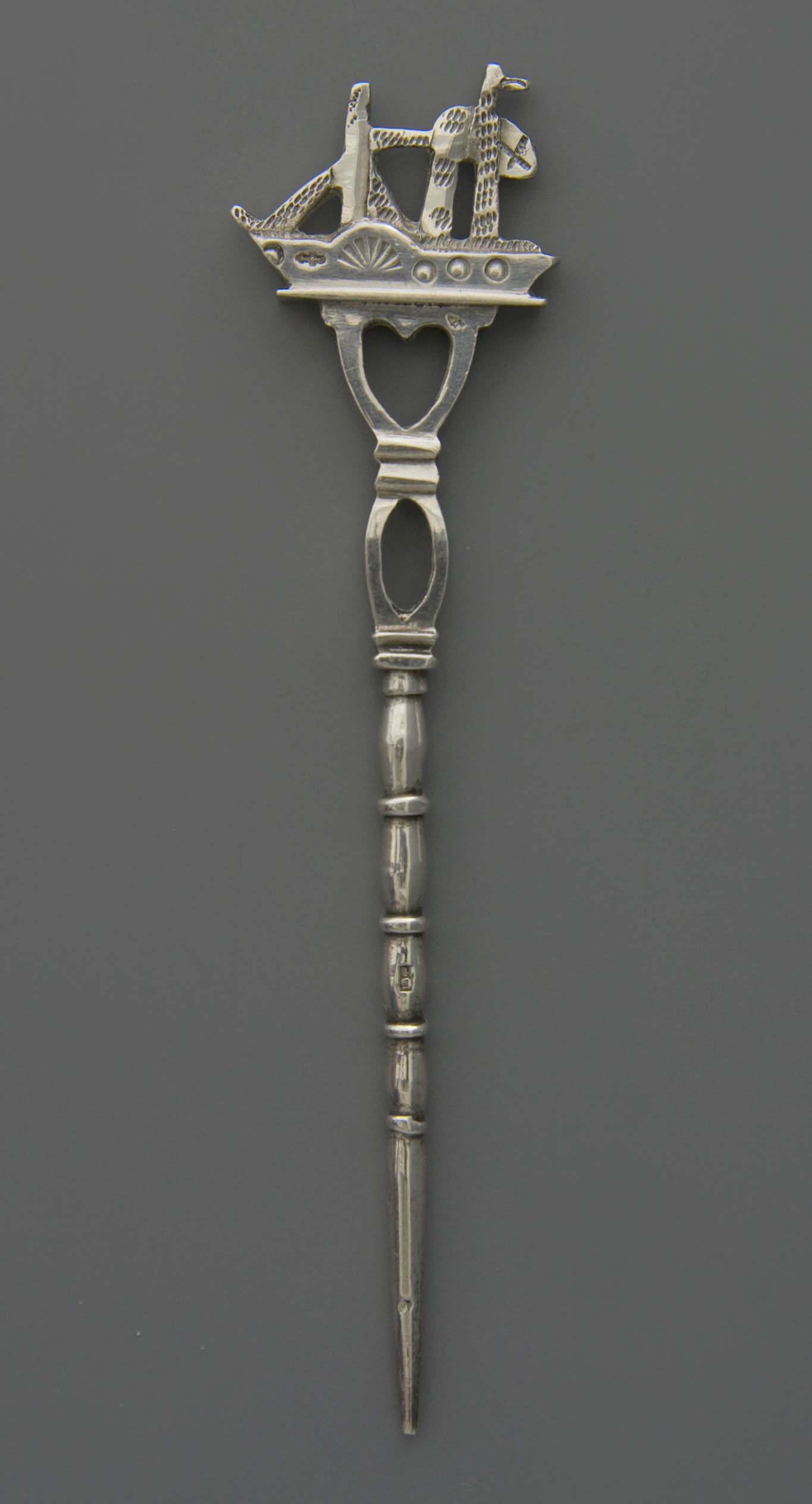
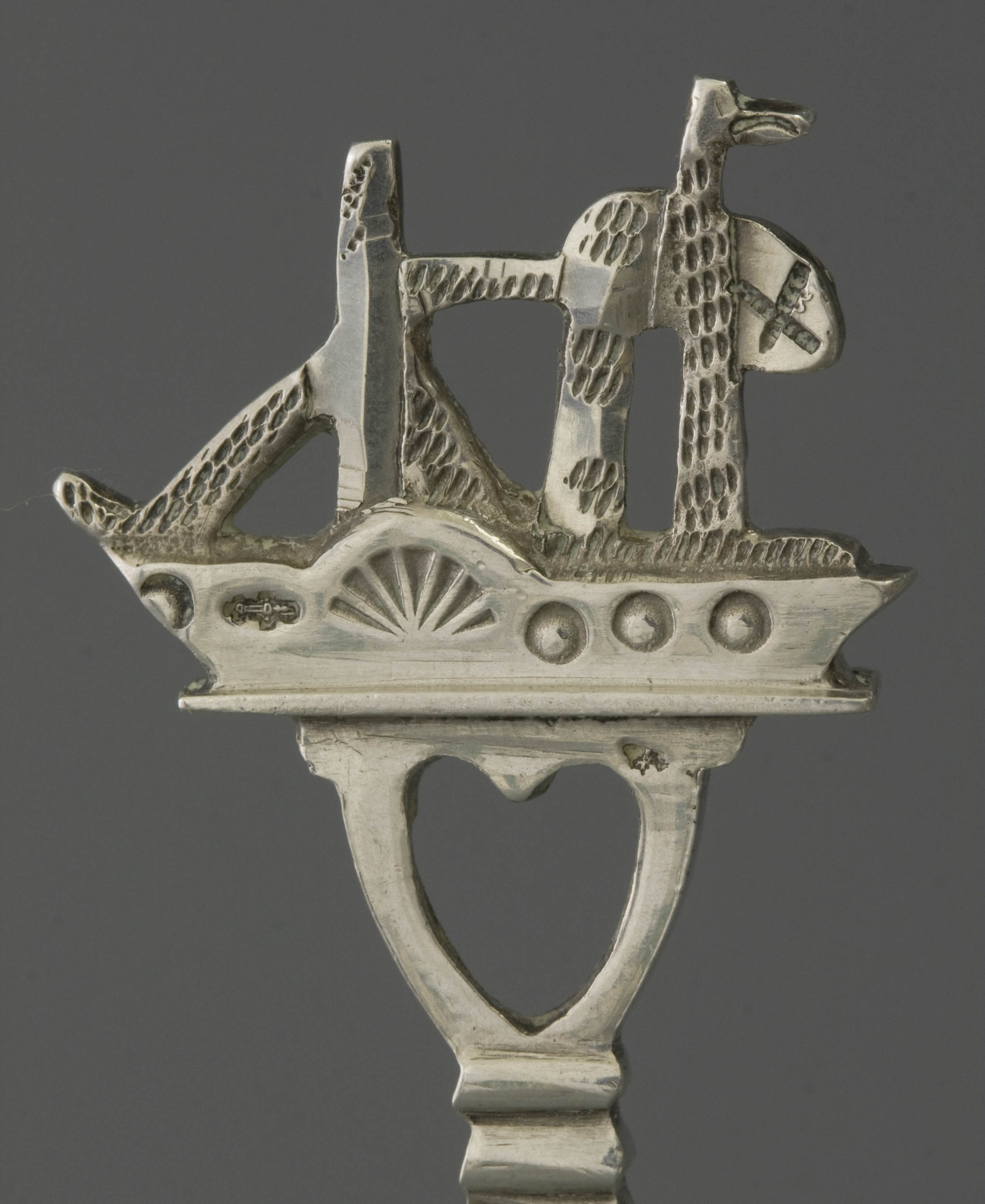
As an aside, it should be noted that similar to the pipe cleaner, there are also awls or pricks , recognizable by an undecorated pin with a sharp point. Most of these have a sleeve to store the dangerous point that is screwed around the pin with a few strokes. A firm handgrip for holding is a second characteristic. Sometimes even silver hat pins are labelled as a pipe cleaner, as are cocktail sticks from the 1950s. Needless to say that such objects are unjustly found in many collections of pipe cleaners.
Use
The question whether the silver pipe cleaner was a daily use item, or whether it was primarily a commemorative gift with a show function is easy to answer. Some of the rather unpractical cleaners with highly elaborate decorations seem more for the show and will have laid in a cupboard or display cabinet. Others will have been used as everyday objects. Smooth-worn handy cleaners that have been passed down betray that they were carried in the trouser pocket for years or handled as often as necessary laying in the pipe drawer under direct reach of the smoker. Of course, the users of such silverware were not free from vanity. In short, usage will have been different in each social circle. - A precious object for one, can be an ordinary utensil for another: an object could be spared in a parsimonious environment , while it could be in daily use in more lavish circles.
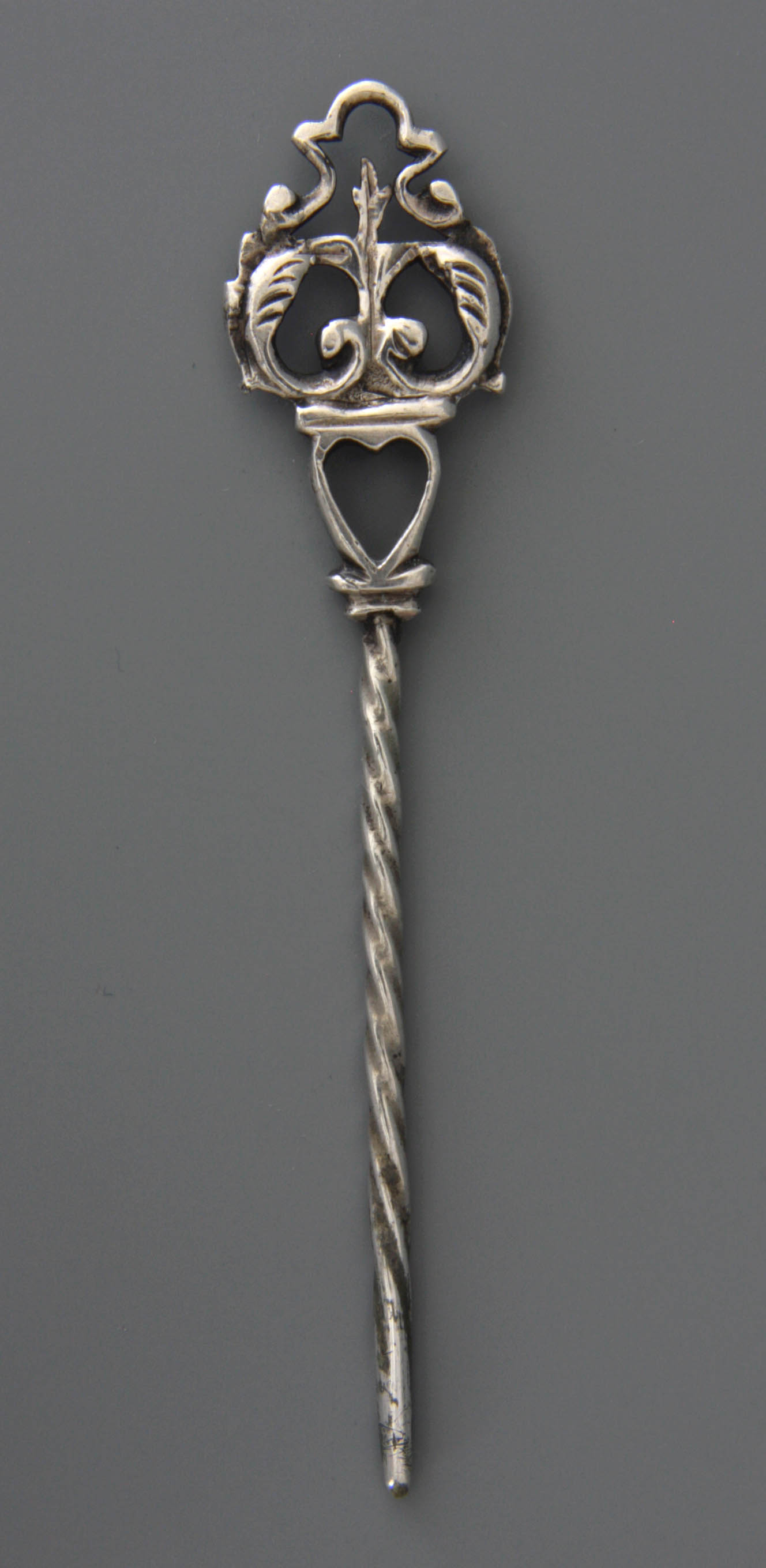
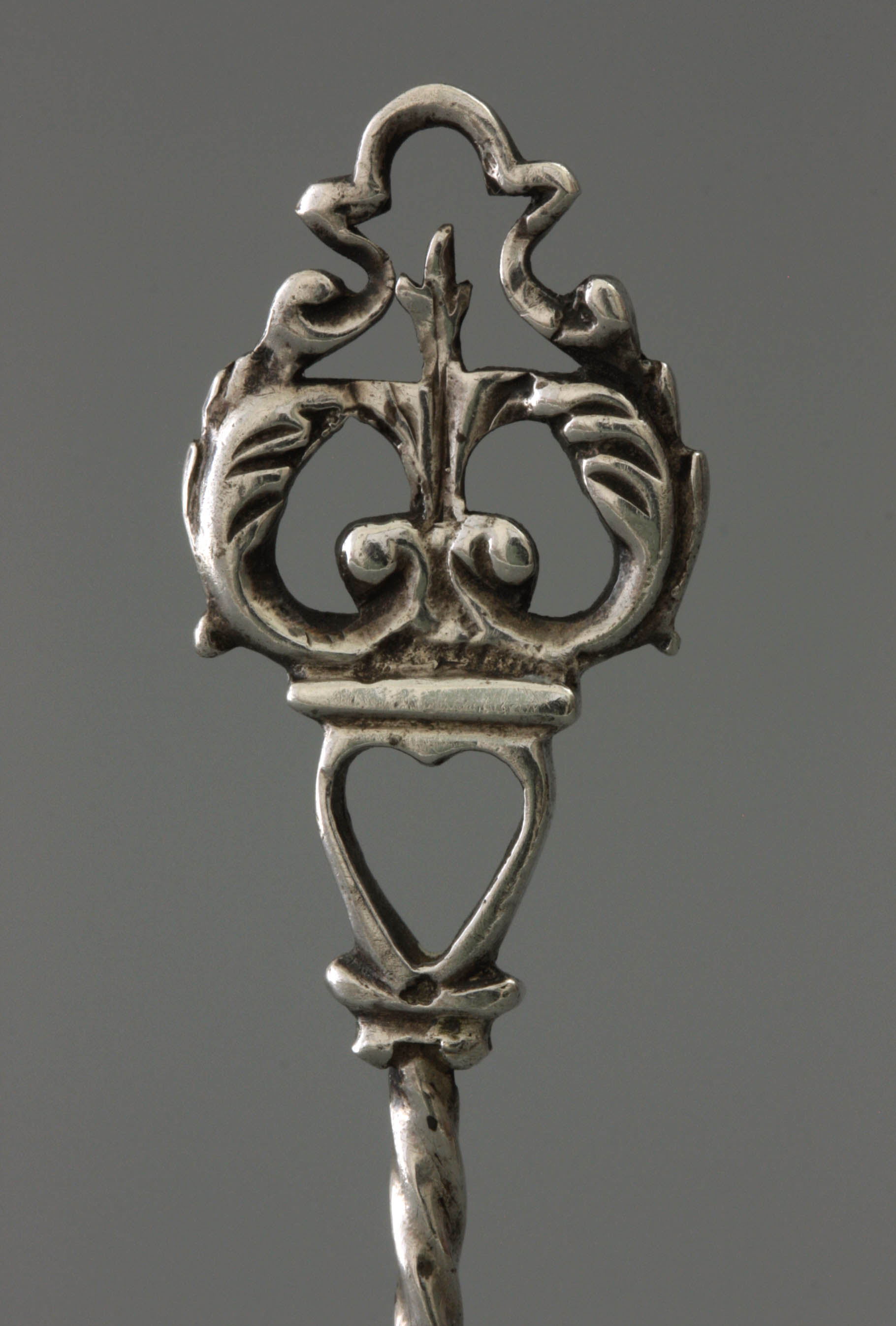
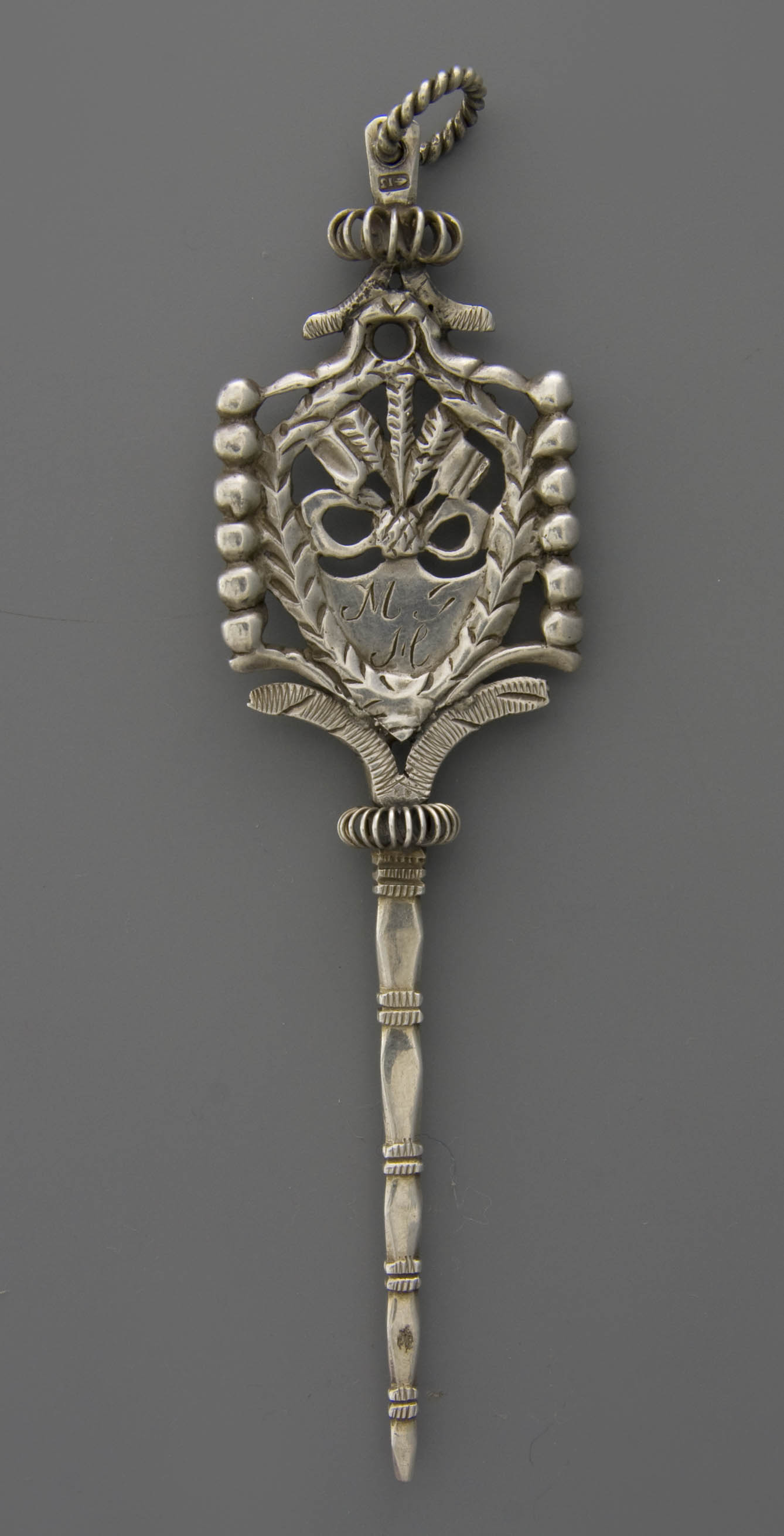
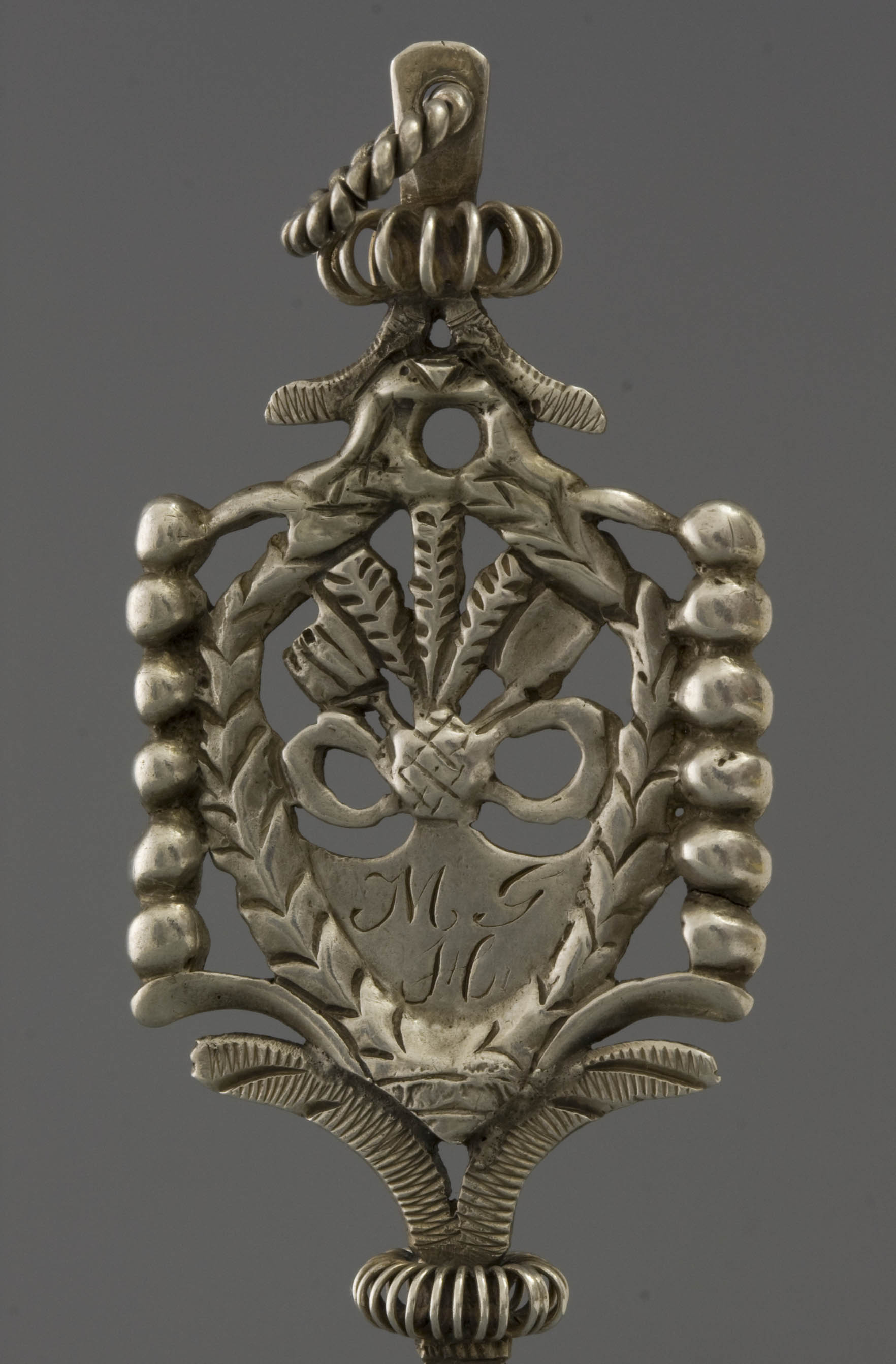
As a simple gift item, the pipe cleaner was suitably offered as a prize for the militia, trotting a horse, a price cow or in boat sailing. These activities also explain the popularity of certain depictions. It should not be forgotten that the silver value was an important part of the purchase price in the nineteenth century. The manufacturing, the fatsoen (making) as it was called, was only a modest part of the price. Since the wage costs did not rise exponentially until the time of the First World War, the price of a cleaner was not so far above the silver value. This is confirmed by characteristics of speed in many somewhat sloppy versions.
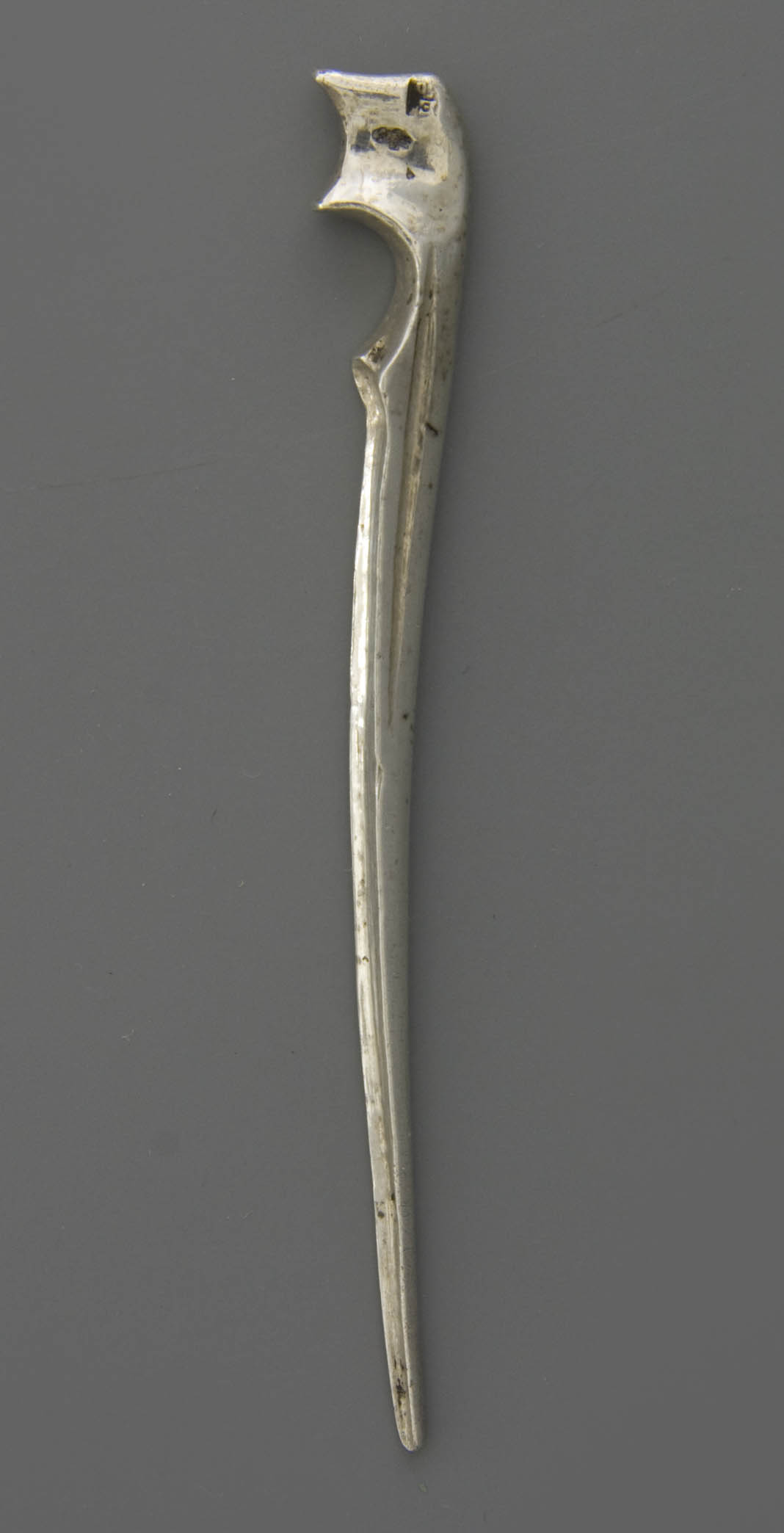
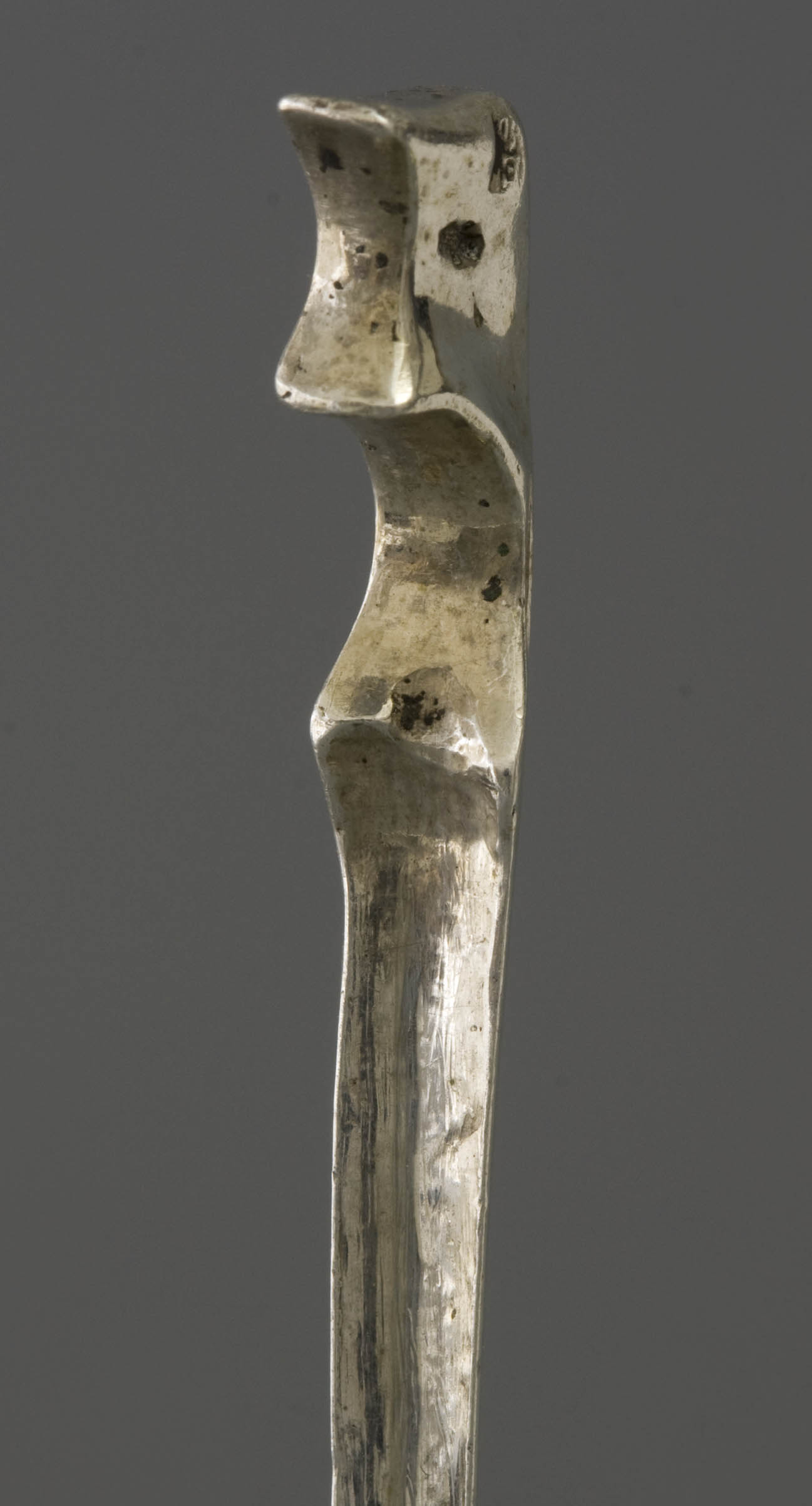
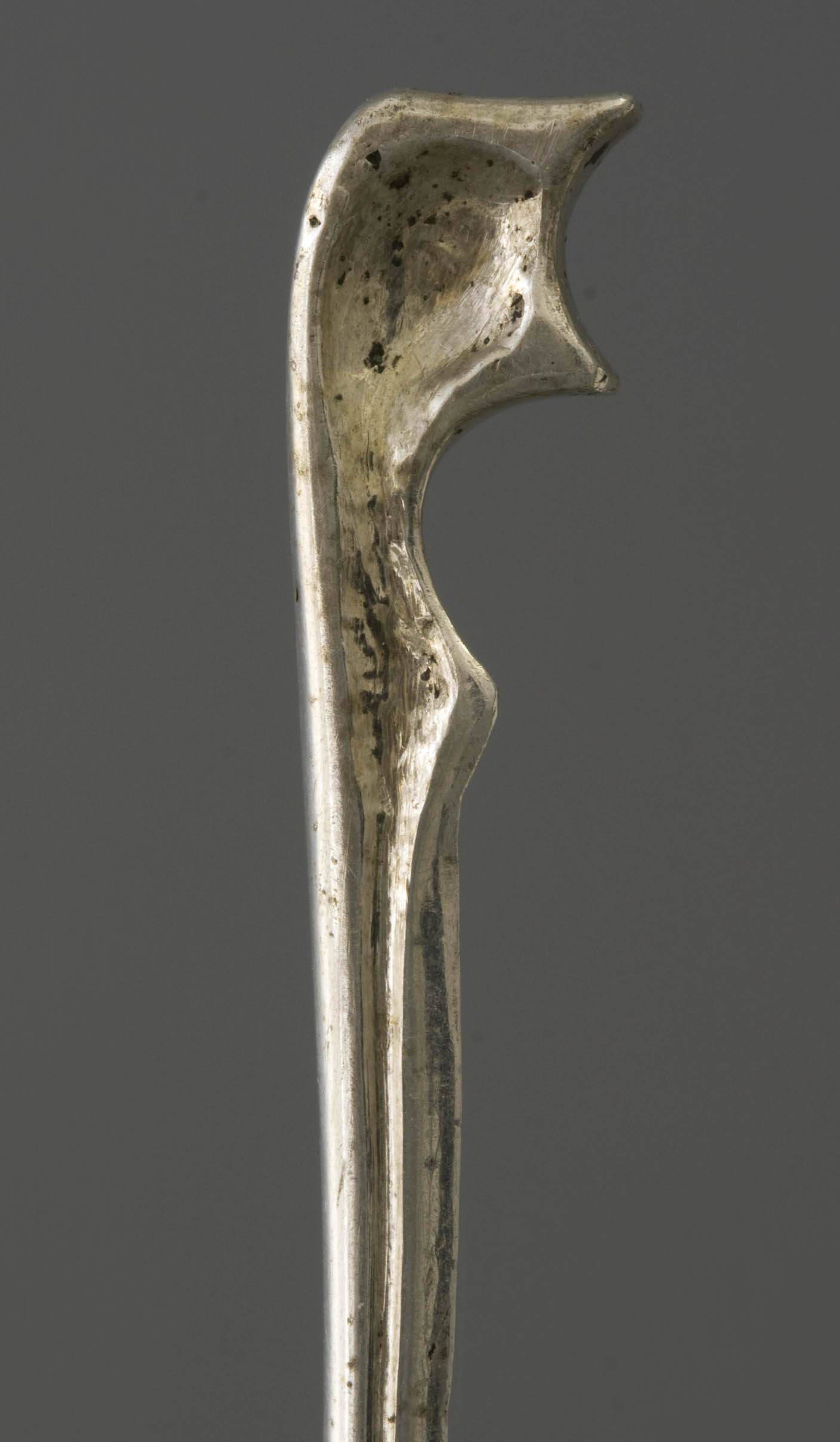
In order to get an objective picture of the pipe cleaner as a tool, we have to include the copies of other materials in the overview. For the eighteenth century these are mainly made in brass or copper with a simple shape. The hammer in particular is a popular design, but other simple decorations also occur, such as a boar or other animal. An important market share is furthermore taken up by cleaners in bone, created as an evening labour on the farm, but also by a bone worker in the city. These show a more popular style and often came about in series. These items were distributed by peddlers and itinerant sellers. Wooden pipe cleaners were not uncommon, but many were disposed because of their burned tip. Although the material differs, the shape of the cleaner and the handle take over the same design. In that respect, the tradition was already established in the eighteenth century by the silver cleaners.
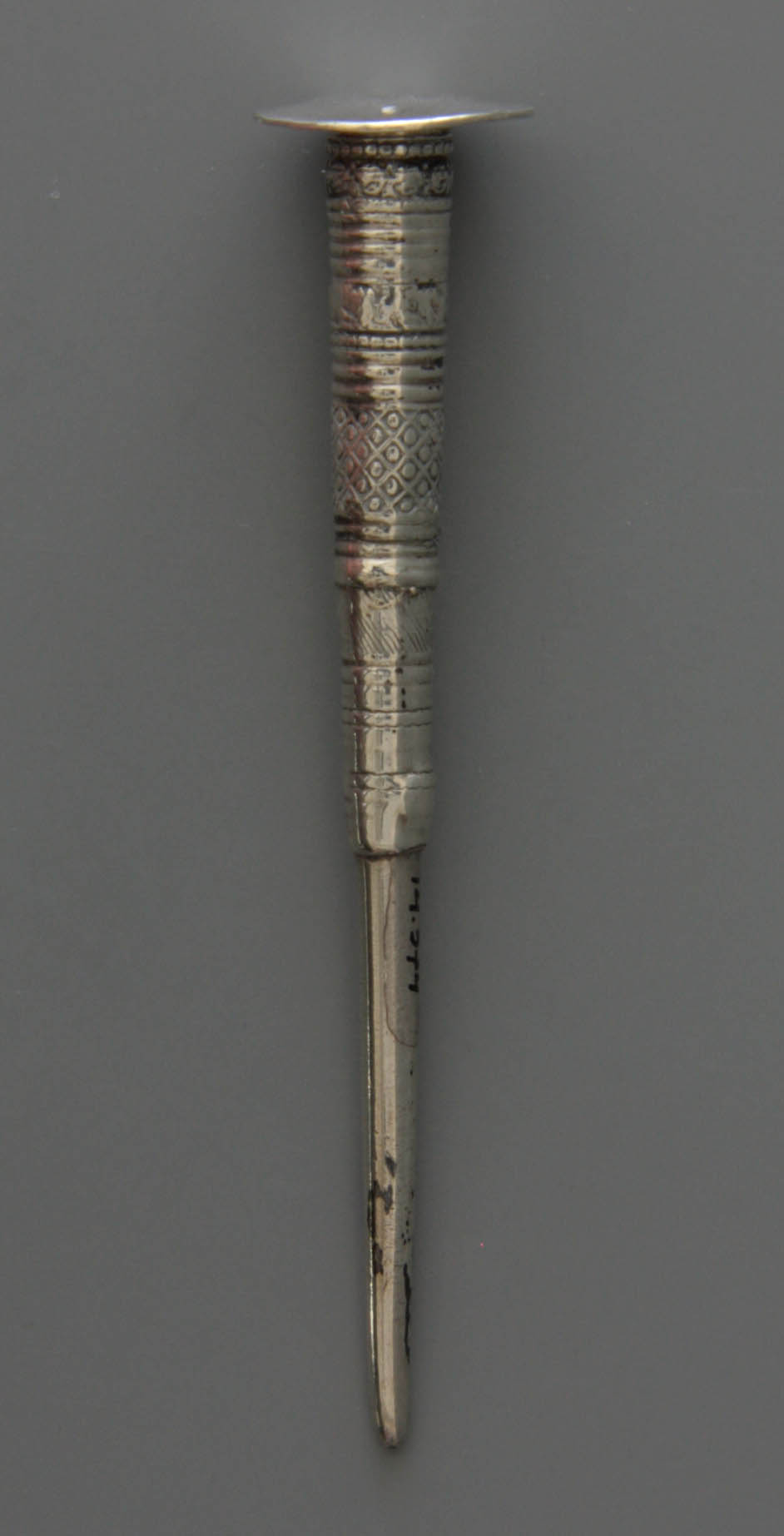
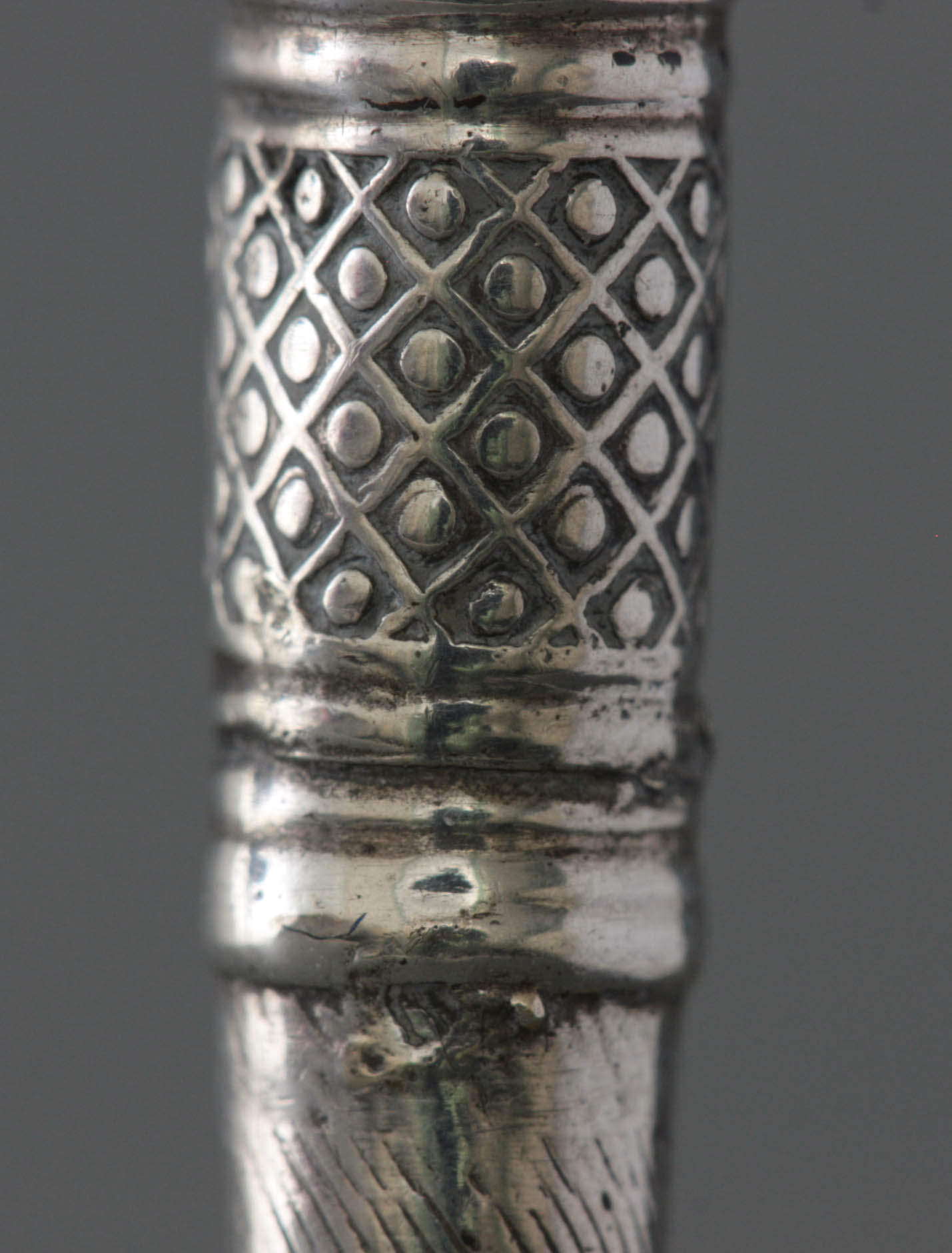
In the first half of the nineteenth century, fancy cleaners of alternative materials came into use. The beak of a curlew mounted in silver or even a cleaner with the whole bird's head are the most notable examples. In addition, there are numerous brass or silver mounted bones and even a porcupine pen. Another material used since the middle of the nineteenth century is mother-of-pearl mounted in silver. In addition, we come across very fine turning work in wood resulting in beautifully shaped turrets, finished with silver fittings. Many examples are a combination of the work of the wood turner and the silversmith. Still, for the major part showpieces, very often made as individual items, but unmistakably the one copied from the other.
Special mention needs to be made for a specific pipe cleaner from Friesland, fully made out of silver. By collectors it is sometimes referred to as “nail” according to the shape of the object: a hollow pin of rolled silver on which a round or square cover plate is soldered (Fig. 53). Although one is tempted to indicate the flat top as a pipe stopper , the top usually shows a memorial inscription such as initials, sometimes with an added year. As said, this very particular pipe cleaner is a local type.
By the time the sale of silver pipe cleaners was well established around 1800,the local silversmith would have provided a range of designs at different prices. We can see this, for example, with the Amsterdam-based silver worker Oepkes, of whom a variety of pipe cleaners are known to be on sale simultaneously. His fine three-master was already mentioned (Fig. 45), at the same time he also made a royalist pipe cleaner with the standing king William I as a handle (Fig. 36). In smaller cities, the offer will be more limited and the execution more simple.
In order to know where the production took place an inventory has been made of the hall marked pipe cleaners. It is remarkable that Amsterdam initially played an important role. Especially in the first period a lot of cleaners came from the capital. In later times, silver city Schoonhoven is leading with a production of no less than a quarter of the total number of pipe cleaners. This, of course, matches the nature of the industry in Schoonhoven, where makers kept their focus on small silver items. The famous silver smith school were the pipe cleaner was a standard training item will have added to this amount. In addition, there is a specific interest in Friesland, while the silver pipe cleaner is made by countless silversmiths all over the province. Remarkably enough, there are relatively many smaller places in the list. The latter underlines the appreciation of the pipe cleaner in the country among the middle class smoker.
In conclusion
Thanks to their more luxurious design, the silver pipe cleaner is one of the curiosities for the pipe smoker and because of their attractive shape they later became a popular item for collectors. Small in size and varied in appearance and decoration, they were already collected in the nineteenth century. Well-known collections from between the World Wars are those of Dr. Lamers from 's-Hertogenbosch, for years on loan to Museum De Moriaan in Gouda. Another example of an early collection is the collection of Karel Azijnman, finally donated to the museum in Den Bosch. Both groups comprise about eighty pipe cleaners of different nature and origin. The collection of apothecary Den Herder from Goes is a third example. This group became well-known because Wttewaal based his chapter on pipe smoking related silver in his standard work on Dutch small silver on this collection. An important part of that collection was acquired by the Amsterdam Pipe Museum in the 21st century and forms the base of this article. It is remarkable to note that collections of pipe cleaners were usually brought together by non-smokers.
The fact that the size of collections of pipe cleaners often stuck with eighty pieces is easily explained. After many years of buying, enough variation was obtained with such a number and more of the same would ad little new. Studying the collections of pipe cleaners proves the serial production so that we can safely state that we have sufficiently inventoried the material. A disruptive factor in that image is the fact that the pipe cleaners from Schoonhoven have remained in production much longer than is logical from a smokers' point of view. Due to the small size and low weight of silver, hall marks are often lacking which is an impeding factor for an overview of dating and spreading to production site.
There is little known about the actual tradition in this relatively humble silver object, for some ornamental and show goods, for others a practical implement. It would be interesting to have a sharper picture of the production and distribution of pipe cleaners and to know more about the use by the target group. By clearly mapping out these factors, an overview of the Dutch silver pipe cleaner can exceed the level of this story. That piece of research should be the sequel to this article.
Origin of pipe cleaners
| Amsterdam | 11 |
| Goes | 2 |
| Groningen | 2 |
| Haarlem | 1 |
| Harlingen | 3 |
| Heerenveen | 3 |
| 's-Hertogenbosch | 1 |
| Hoorn | 4 |
| Joure | 1 |
| Leeuwarden | 5 |
| Leiden | 1 |
| Lemmer | 1 |
| Makkum | 1 |
| Rotterdam | 1 |
| Schoonhoven | 25 |
| Sneek | 1 |
| Steenwijk | 1 |
| Waspik | 1 |
| Workum | 1 |
| Utrecht | 1 |
| Zwolle | 1 |
| 66 |
© Don Duco, Amsterdam Pipe Museum, Amsterdam – the Netherlands, 2013.
Illustrations
- Smoke and toilet trimmings in silver with various instruments including a pipe stopper and a pipe cleaner. Haarlem, 1725-1760.
Amsterdam Pipe Museum APM 4.647 - Pipe cleaner of brass, in the handle a boar. The Netherlands, 1750-1800.
Amsterdam Pipe Museum APM 6.649 - Pipe cleaner of bone, in the handle a sitting dog. Friesland, 1780-1850.
Amsterdam Pipe Museum APM 0.330 - Pipe cleaner in silver, in the handle a horse. Zeeland, 1840-1870.
Amsterdam Pipe Museum APM 21.870 - Pipe cleaner in silver, in the handle a horse. The Netherlands, 1850-1890.
Amsterdam Pipe Museum APM 21.869 - Pipe cleaner in silver, in the handle a horse. Haarlem, L. Hajee, 1810-1830.
Amsterdam Pipe Museum APM 21.868 - Pipe cleaner in silver, in the handle a horse. Schoonhoven, L. van den Berg, 1855-1870.
Amsterdam Pipe Museum APM 20.781 - Pipe cleaner in silver, in the handle a horse. The Netherlands, 1850-1890.
Amsterdam Pipe Museum APM 21.867 - Pipe cleaner in silver, in the handle a rider on horseback. Schoonhoven, L. van den Berg, 1850-1875.
Amsterdam Pipe Museum APM 10.101 - Pipe cleaner in silver, in the handle a rider on horseback. Schoonhoven, 1880-1930.
Amsterdam Pipe Museum APM 4.580 - Pipe cleaner in silver, in the handle a lying cow. The Netherlands, 1860-1900.
Amsterdam Pipe Museum APM 21.861 - Pipe cleaner in silver, in the handle a standing cow. Waspik, P. Boonhof, 1815-1825.
Amsterdam Pipe Museum APM 21.859 - Pipe cleaner in silver, in the handle a standing cow. The Netherlands, 1850-1900.
Amsterdam Pipe Museum APM 21.860 - Pipe cleaner in silver, in the handle a four-legged animal. The Netherlands, 1812-1850.
Amsterdam Pipe Museum APM 21. 857 - Pipe cleaner in silver, in the handle a four-legged animal. Schoonhoven, G. van Ewijck, 1835-1865.
Amsterdam Pipe Museum APM 21.858 - Pipe cleaner in silver, in the handle a little animal. The Netherlands, 1813-1830.
Amsterdam Pipe Museum APM 13.931 - Pipe cleaner in silver, in the handle a sitting dog. Steenwijk, firma M. Bijkamp & Co., 1925-1940.
Amsterdam Pipe Museum APM 20.780 - Pipe cleaner in silver, in the handle spitz in doghouse. The Netherlands, 1785-1790.
Amsterdam Pipe Museum APM 21.855 - Pipe cleaner in silver, in the handle a spitz. Schoonhoven, H.Ch. Sperna Weiland, 1845-1870.
Amsterdam Pipe Museum APM 21.856 - Pipe cleaner in silver, in the handle a standing rooster. The Netherlands, 1850-1890.
Amsterdam Pipe Museum APM 21.862 - Pipe cleaner in silver, in the handle a parrot. Leiden, C. de Keijzer, 1820-1845.
Amsterdam Pipe Museum APM 20.778 - Pipe cleaner in silver, in the handle a falcon. The Netherlands, 1850-1890.
Amsterdam Pipe Museum APM 21.863 - Pipe cleaner in silver, in the handle a smoking monkey. Utrecht, D. van Boom, 1815-1830.
Amsterdam Pipe Museum APM 21.864 - Pipe cleaner in silver, in the handle a monkey with trumpet. The Netherlands, 1800-1850.
Amsterdam Pipe Museum APM 20.779 - Pipe cleaner in silver, in the handle a dolphin. Schoonhoven, A.H. Lazonder, 1835-1860.
Amsterdam Pipe Museum APM 0.681 - Pipe cleaner in silver, in the handle an heraldic lion with shield. Schoonhoven, J. van Geelen, 1860-1880.
Amsterdam Pipe Museum APM 21.865 - Pipe cleaner in silver, in the handle an heraldic lion with shield. The Netherlands, 1870-1920.
Amsterdam Pipe Museum APM 21.866 - Pipe cleaner in silver, in the handle a cooper with barrel. The Netherlands, 1820-1860.
Amsterdam Pipe Museum APM 21.871 - Pipe cleaner in silver, in the handle a man with gun. The Netherlands, 1850-1890.
Amsterdam Pipe Museum APM 21.873 - Pipe cleaner in silver, in the handle a man with gun. Amsterdam, P. Lacroix, 1850-1865.
Amsterdam Pipe Museum APM 0.399 - Pipe cleaner in silver, in the handle a standing man. Schoonhoven, 1900-1940.
Amsterdam Pipe Museum APM 21.875 - Pipe cleaner in silver, in the handle a standing man with pipe. The Netherlands, 1850-1920.
Amsterdam Pipe Museum APM 21.872 - Pipe cleaner in silver, in the handle person with cornucopia. Amsterdam, H. van Heezel, 1820-1880.eezel, 1830-1880.
Amsterdam Pipe Museum APM 20.782 - Pipe cleaner in silver, in the handle a dancing harlequin. The Netherlands, 1955-1970.
Amsterdam Pipe Museum APM 21.874 - Pipe cleaner in silver, in the handle a standing Esaias with saw. The Netherlands, 1830-1880.
Amsterdam Pipe Museum APM 21.903 - Pipe cleaner in silver, in the handle standing king Willem II. Leeuwarden, P. Schuil, 1835-1845.
Amsterdam Pipe Museum APM 21.876 - Pipe cleaner in silver, in the handle a standing Frederick the Great. Goes, Gerrit van de Velde, 1840-1865.
Amsterdam Pipe Museum APM 21.878 - Pipe cleaner in silver, in the handle a standing Napoleon. Goes, Gerrit van de Velde, 1830-1860.
Amsterdam Pipe Museum APM 21.877 - Pipe cleaner in silver, in the handle a plan. The Netherlands, 1780-1805.
Amsterdam Pipe Museum APM 21.852 - Pipe cleaner in silver, in the handle a saw. The Netherlands, 1830-1880.
Amsterdam Pipe Museum APM 21.851 - Pipe cleaner in silver, in the handle a smith work bench, anvil and bellows. The Netherlands, 1840-1860.
Amsterdam Pipe Museum APM 21.850 - Pipe cleaner in silver, in the handle an anvil. Amsterdam, P. Siemering, 1810-1840.
Amsterdam Pipe Museum APM 21.853 - Pipe cleaner in silver, in the handle carpenter's tools. Schoonhoven, G. van Ewijck, 1835-1855.
Amsterdam Pipe Museum APM 18.443 - Pipe cleaner in silver, in the handle a mule. The Netherlands, 1860-1890.
Amsterdam Pipe Museum APM 20.976 - Pipe cleaner in silver, in the handle a three-master. Amsterdam, G. Oepkes, 1812-1820.
Amsterdam Pipe Museum APM 21.880 - Pipe cleaner in silver, in the handle a three-master. The Netherlands, 1840-1880.
Amsterdam Pipe Museum APM 21.881 - Pipe cleaner in silver, in the handle a three-master. Schoonhoven, 1850-1900.
Amsterdam Pipe Museum APM 1.608 - Pipe cleaner in silver, in the handle a three-master. The Netherlands, 1955-1975.
Amsterdam Pipe Museum APM 21.879 - Pipe cleaner in silver, in the handle a paddle boat. Schoonhoven, D.H. Greup, 1850-1865.
Amsterdam Pipe Museum APM 1.869 - Pipe cleaner in silver, in the handle ornaments. The Netherlands, 1830-1870.
Amsterdam Pipe Museum APM 18.444 - Pipe cleaner in silver, in the handle ears of corn. Germany, 1850-1890.
Amsterdam Pipe Museum APM 21.854 - Pipe cleaner in silver, shaped like a hazy leap. Schoonhoven, G. van Ewijck, 1850-1865.
Amsterdam Pipe Museum APM 0.157c - Pipe cleaner in silver, shape resembles a nail. Sneek, L. van Manen, 1844.
Amsterdam Pipe Museum APM 14.574